Paul van Yperen's Blog, page 129
April 1, 2022
Nils Asther
Good-looking Swedish actor Nils Asther (1897-1981) was an intense star of silent European cinema. He was labelled ‘the male Greta Garbo’. In Hollywood, he played the leading man to divas like Pola Negri, Joan Crawford, and Marion Davies.
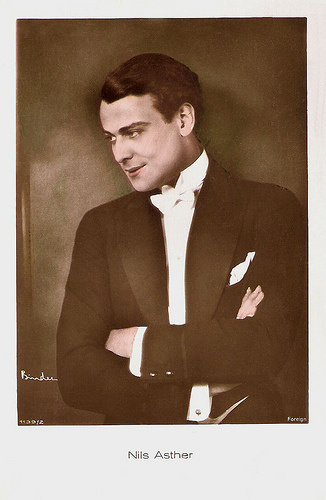
British postcard, no. 1139/2, 1927-1928. Photo: Alex Binder.
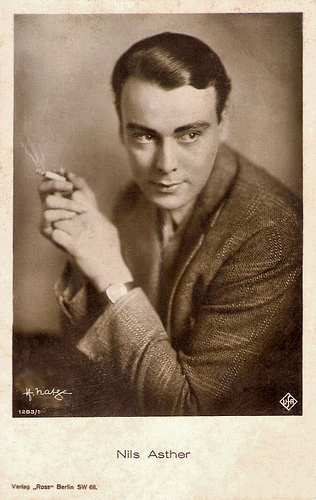
German postcard by Ross Verlag, Berlin, no. 1283/1, 1927-1928. Photo: H. Natze / Ufa.
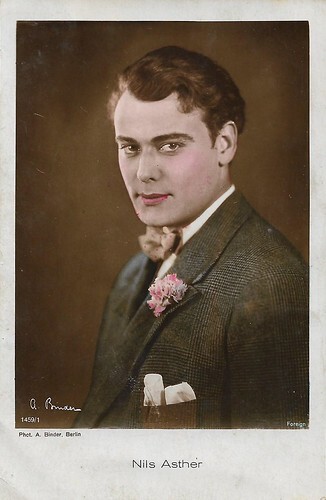
German postcard in the Foreign Series by Ross Verlag, no. 1459/1. Photo: Alex Binder, Berlin.
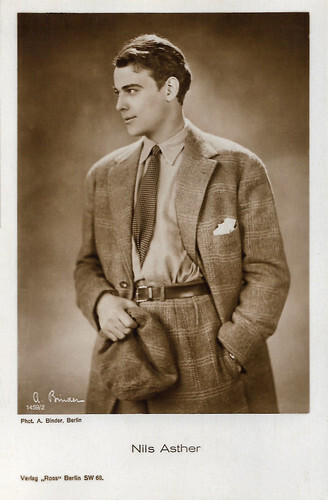
German postcard by Ross Verlag, Berlin, no. 1459/2, 1927-1928. Photo: Alex Binder, Berlin.
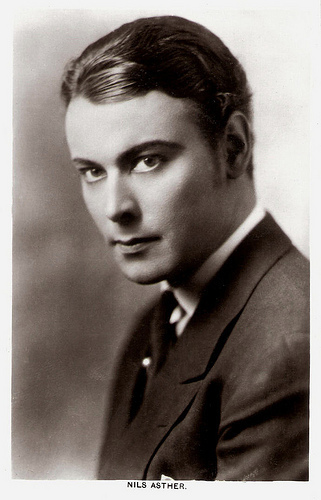
British postcard in the Picturegoer Series, London, no. 341.
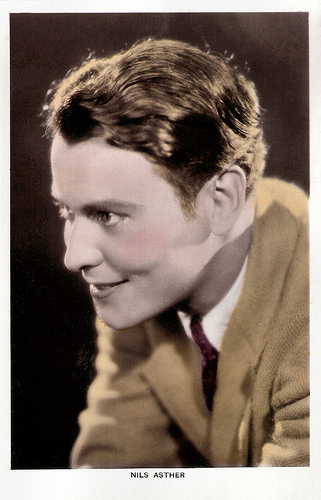
British postcard in the Colourgraph Series, London, no. C 47.
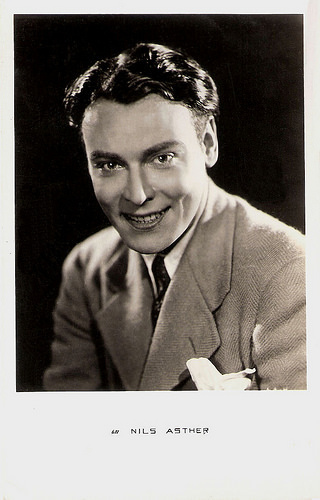
Dutch postcard, no. 69.
Darkly handsome
Nils Anton Alfhild Asther was born in Copenhagen, the capital of Denmark (some sources say Hellerup, Denmark), in 1897, but he was raised in Malmö, Sweden, by his wealthy Swedish parents.
After attending the Kungliga Dramatiska Teaterns Elevskola (Royal Dramatic Theater School) in Stockholm, the darkly handsome Asther began his stage career in Copenhagen.
In 1916 legendary director - and the later mentor of Greta Garbo - Mauritz Stiller discovered him. Reportedly they also began an affair.
Stiller cast him in the leading role (as an aspiring actor, appropriately enough) in the Swedish film Vingarne/The Wings (Mauritz Stiller, 1916). In the following years, Asther acted on the Swedish stage and in a few films.
In 1922 he worked with another acclaimed Swedish director, Victor Sjöström in Vem dömer/Love's Crucible (1922) with Gösta Ekman . Then he starred in German productions like Briefe, die ihn nicht erreichten/Letters, Which Never Reached Him ( Friedrich Zelnik/Frederic Zelnik , 1925), Der Goldene Schmetterling/The Golden Butterfly (Mihály Kertész/Michael Curtiz, 1926) opposite Lily Damita , and Hotelratten/Hotel Rats (Jaap Speyer, 1927).
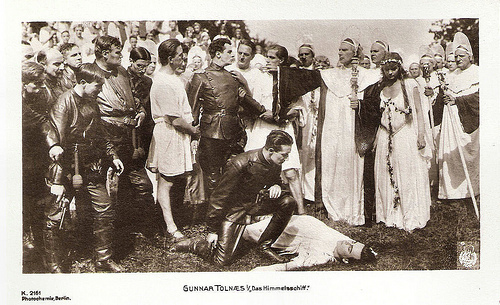
German postcard by Photochemie, Berlin, no. K. 2161. Photo: Nordisk. Publicity still for Himmelskibet/Das Himmelschiff (Holger-Madsen, 1918) with Gunnar Tolnaes as Avanti Planetaros, Philip Bech as the Martian leader, Lilly Jacobsson as Marya, the Martian leader's daughter, Alf Blütecher (kneeling) as his friend Dr. Krafft and Nils Asther as the fallen Martian.
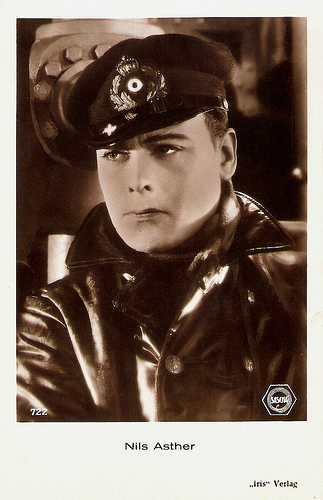
Austrian postcard by Iris Verlag, no. 722. Photo: Sascha Film. Nils Asther in the German silent film Die versunkene Flotte (Manfred Noa, 1926), released in the US in 1929 as The Wrath of the Seas.
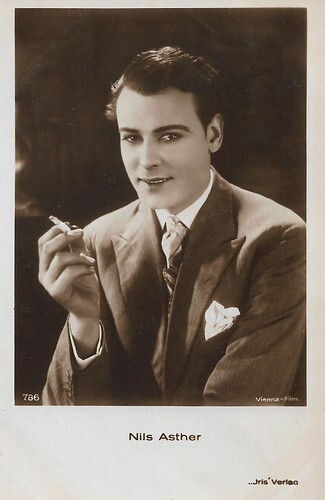
Austrian postcard by Iris Verlag, no. 786. Photo: Vienna-Film.
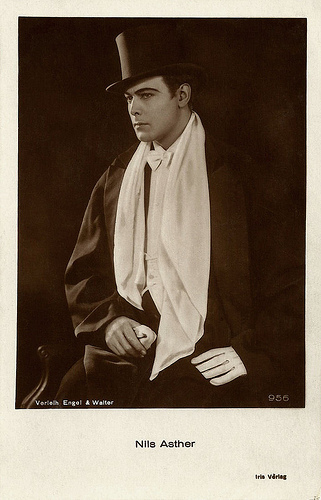
Austrian postcard by Iris Verlag, no. 956. Photo: Verleih Engel & Walter. Probably publicity still for Sorrell & Son (Herbert Brenon, 1927).
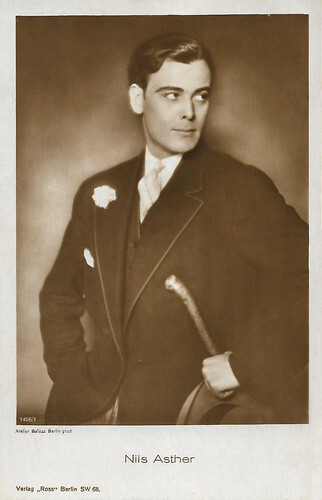
German postcard by Ross Verlag, Berlin, no. 1456/1, 1927-1928. Photo: Atelier Balàzs, Berlin.
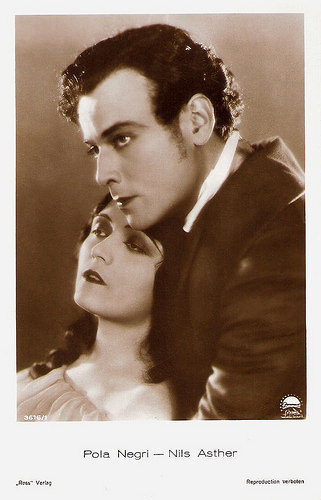
German postcard by Ross Verlag, no. 3616/1, 1928-1929. Photo: Paramount. Publicity still for Loves of an Actress (Rowland V. Lee, 1928) with Pola Negri .
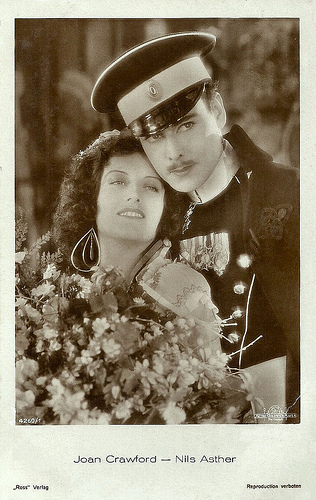
German postcard by Ross Verlag, no. 4260/1, 1929-1930. Photo: Metro-Goldwyn-Mayer. Joan Crawford and Nils Asther in Dream of Love (Fred Niblo, 1928).
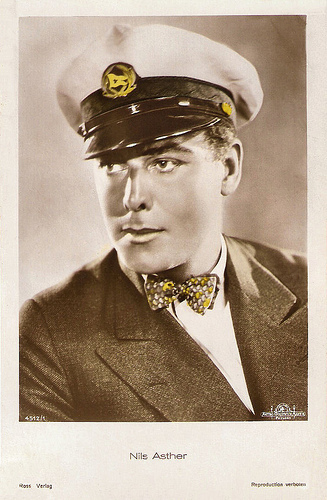
German postcard by Ross Verlag, no. 4512/1, 1929-1930. Photo: Metro-Goldwyn-Mayer.
Almost impossibly handsome
In 1927 Nils Asther moved to Hollywood. His first American films were Topsy and Eva (Del Lord, 1927), based on Harriet Beecher Stowe’s novel Uncle Tom's Cabin, and the popular comedy Sorrell and Son (Herbert Brenon, 1927), in which he played Sorrell Jr.
Another successful film directed by Herbert Brenon was Laugh, Clown, Laugh (1928) starring Lon Chaney . Asther’s foreign, exotic looks made him a popular actor, and he soon grew a thin moustache that amplified his suave appearance.
His good looks landed him romantic roles with such co-stars as Pola Negri in Loves of an Actress (Rowland V. Lee, 1928), Marion Davies in The Cardboard Lover (Robert Z. Leonard, 1928), and Joan Crawford in Our Dancing Daughters (Harry Beaumont, 1928).
Hans Wollstein writes at AllMovie : "Almost impossibly handsome, (...) Asther had the misfortune to be tagged the 'male Greta Garbo . He did two films with his famous counterpart: The Single Standard (John S. Robertson, 1929) and Wild Orchids (Sidney Franklin, 1929), and what an exotically handsome couple they made."
Asther was bisexual, and for a while, he was smitten with Garbo. Like John Gilbert , he unsuccessfully proposed in 1929 while they were filming The Single Standard (John S. Robertson, 1929).
In the early 1930s, he was briefly married to vaudeville actress Vivian Duncan, his co-star in Topsy and Eva (Del Lord, 1927).
Although his foreign accent was a hindrance in the sound film, he starred opposite Joan Crawford in Letty Lynton (Clarence Brown, 1932), and opposite Barbara Stanwyck in The Bitter Tea of General Yen (Frank Capra, 1933). He also starred in James Whale’s charming romantic comedy By Candlelight (1933) with Elissa Landi .
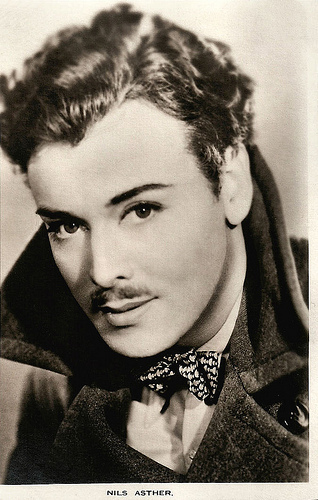
Postcard of unknown nationality or editor.
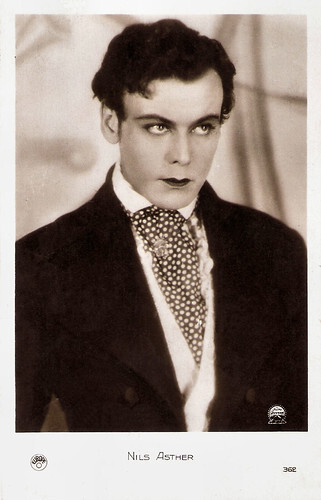
French postcard in the Europe series, no. 362. Photo: Paramount. Could be for Loves of an Actress (Rowland V. Lee, 1928).
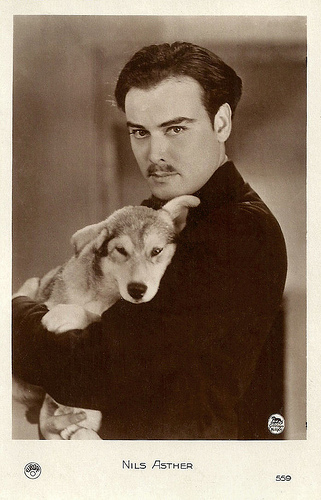
French postcard in the Europe series, no. 559. Photo: Metro-Goldwyn-Mayer.
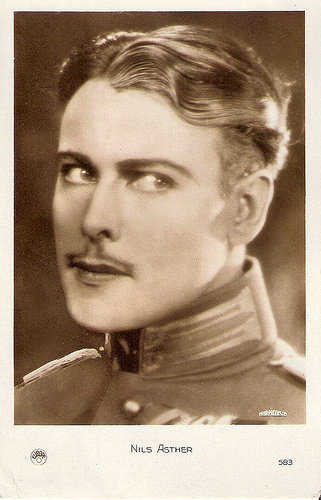
French postcard in the Europe series, no. 583. Photo: Erko-Prodisco. Publicity still for Moonlight on the Danube (Paul Sloane, 1928).
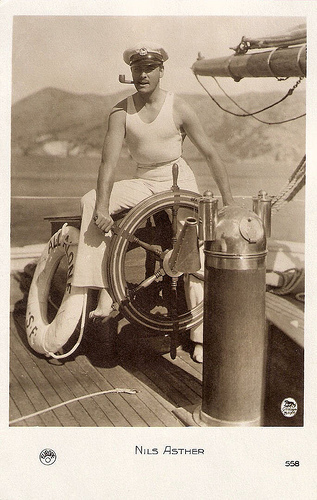
French postcard in the Europe Series, no. 558. Photo: MGM (Metro-Goldwyn-Mayer). Publicity still for the late silent film The Single Standard (John S. Robertson, 1929), starring Greta Garbo . The safety buoy reads: All Alone....
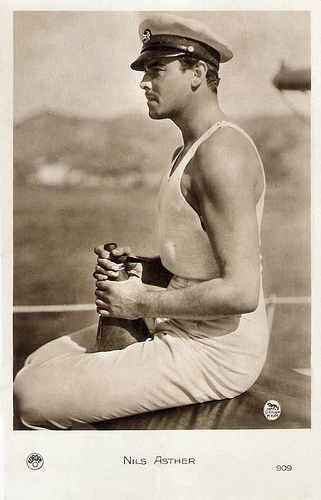
French postcard in the Europe series, no. 909. Photo: MGM (Metro-Goldwyn-Mayer). Publicity still for The Single Standard (John S. Robertson, 1929).
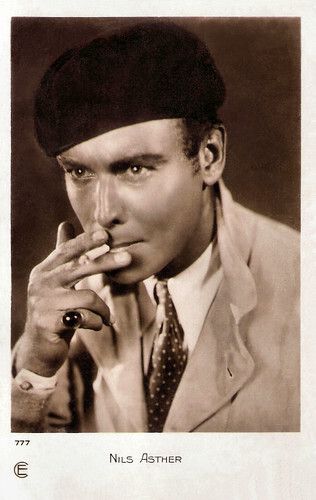
French postcard by Cinémagazine-Edition, Paris, no. 777.
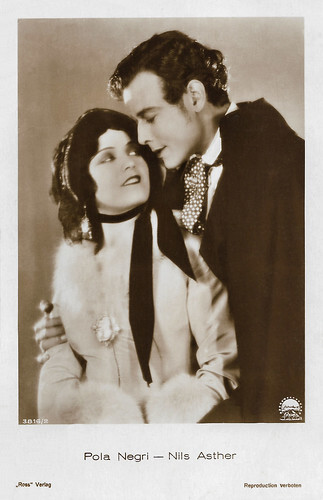
German postcard by Ross Verlag, no. 3816/2, 1928-1929. Photo: Paramount. Pola Negri and Nils Asther in Loves of an Actress (Rowland V. Lee, 1928).
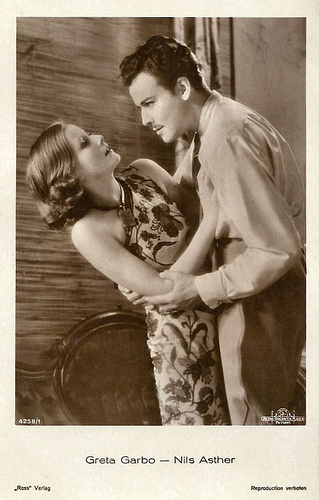
German postcard by Ross Verlag, no. 4258/1, 1928-1929. Photo: Metro-Goldwyn-Mayer. Greta Garbo and Nils Asther in the late silent film Wild Orchids (Sidney Franklin, 1929).
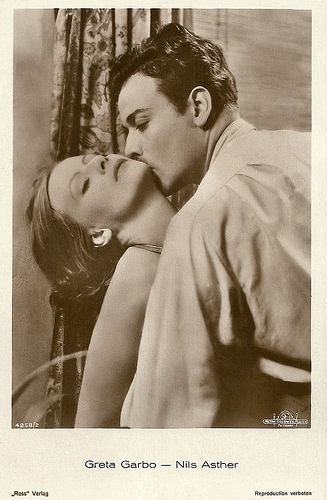
German postcard by Ross Verlag, no. 4258/2, 1928-1929. Photo: Metro-Goldwyn-Mayer. Greta Garbo and Nils Asther in Wild Orchids (Sidney Franklin, 1929).
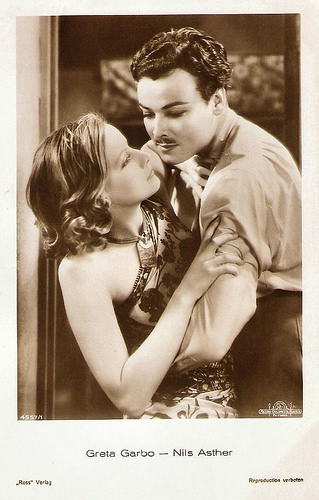
German postcard by Ross Verlag, no. 4557/1, 1928-1929. Photo: Metro-Goldwyn-Mayer. Publicity still for Wild Orchids (Sidney Franklin, 1929) with Greta Garbo .
Blacklisted
Nils Asther's Hollywood career continued until 1934 when he was blacklisted for breaking a contract. In 1935, he moved to Britain for four years.
His British films included the spectacle Abdul the Damned (Karl Grune, 1935) with Fritz Kortner , and the historical romance The Marriage of Corbal (Karl Grune, 1936).
Although he was allowed back in 1941, his Hollywood career declined. He played supporting parts in B-films like The Night Before the Divorce (Robert Siodmak, 1942), Night Monster (Ford Beebe, 1942), and the film-noir Jealousy (Gustav Machaty, 1945) starring John Loder .
But according to Hans J. Wollstein at AllMovie "whatever the setting, Asther always delivered a carefully modulated performance."
By 1949 he was driving a truck.
In 1958, he returned to Sweden, where he made occasional appearances in films like När mörkret faller/When Darkness Falls (Arne Mattsson, 1960), and Vita frun/Lady in White (Arne Mattsson, 1962) opposite Anita Björk . He also worked for Swedish television and on stage.
Nils Asther died in 1981 in Stockholm. A very honest autobiography, 'Narren's Väg' (The Road of the Jester), was published posthumously in Sweden in 1988.
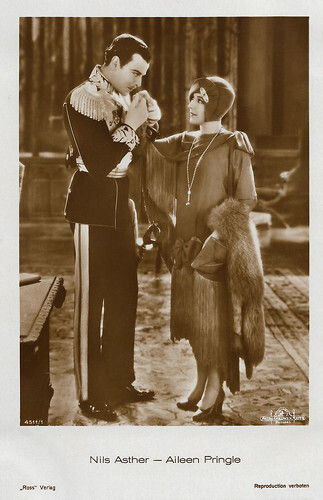
German postcard by Ross Verlag, no. 4511/1. Metro-Goldwyn-Mayer. Aileen Pringle and Nils Asther, probably in the late silent film Dream of Love (Fred Niblo, 1928). The film is considered lost.
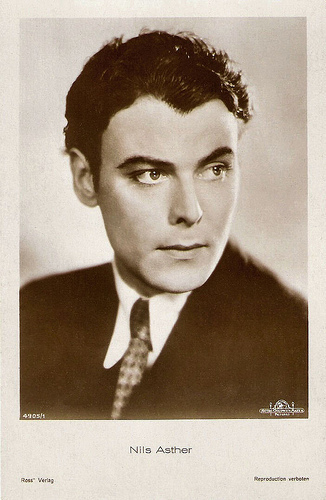
German postcard by Ross Verlag, no. 4905/1, 1929-1930. Photo: MGM (Metro-Goldwyn-Mayer).
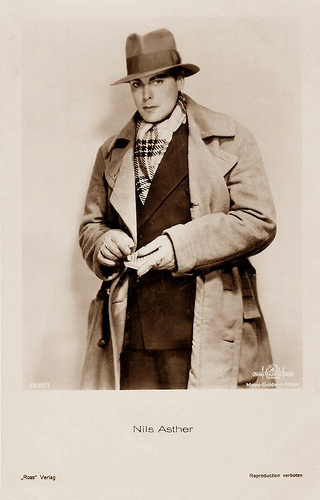
German postcard by Ross Verlag, no. 6237/1, 1931-1932. Photo: MGM (Metro-Goldwyn-Mayer).
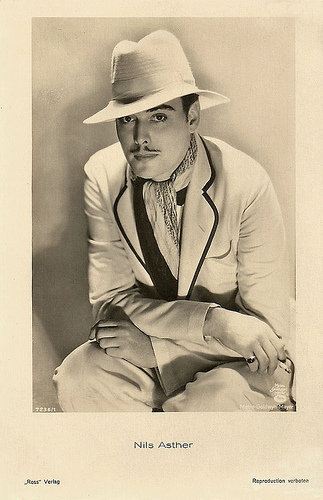
German postcard by Ross Verlag, no. 7236/1, 1932-1933. Photo: MGM (Metro-Goldwyn-Mayer).
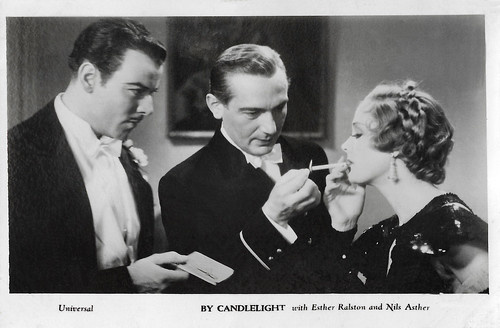
British postcard in the Film Shots series by Film Weekly. Photo: Universal. Nils Asther, Paul Lukas and Esther Ralston in By Candlelight (James Whale, 1933).
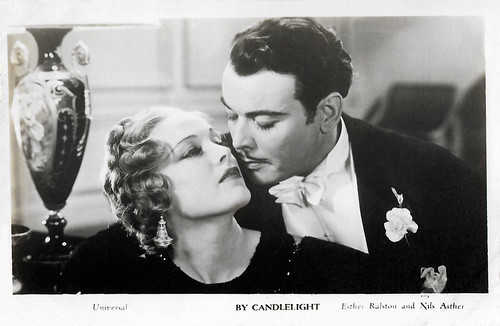
British postcard in the Film Shots series by Film Weekly. Photo: Universal. Nils Asther and Esther Ralston in By Candlelight (James Whale, 1933).
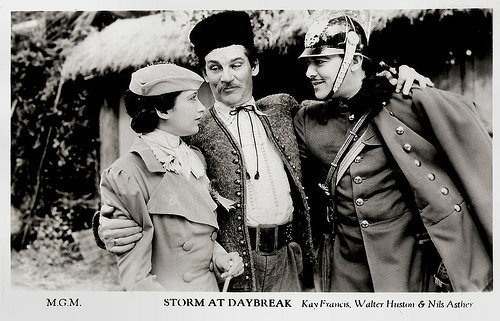
British postcard in the Film Shots series by Film Weekly. Photo: MGM. Publicity still for Storm at Daybreak (Richard Boleslawski, 1933) with Kay Francis and Walter Huston.
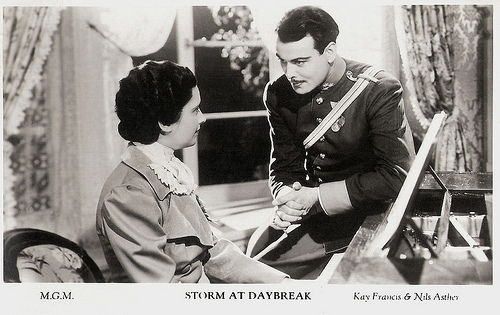
British postcard in the Film Shots series by Film Weekly. Photo: MGM. Publicity still for Storm at Daybreak (Richard Boleslawski, 1933).
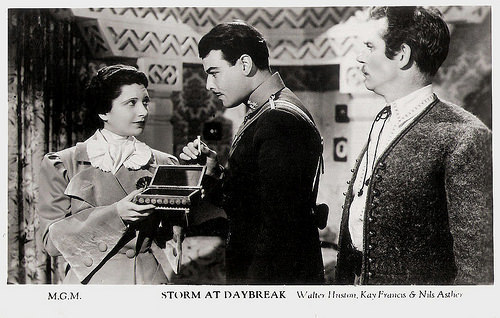
British postcard in the Film Shots series by Film Weekly. Photo: MGM. Publicity still for Storm at Daybreak (Richard Boleslawski, 1933).
Nils Asther with Greta Garbo and Lewis Stone in a scene from Wild Orchids (Sidney Franklin, 1929). Source: Asphodela (YouTube).
Sources: Peter Rivendell (Gay For Today), Hans J. Wollstein (AllMovie), (IMDb), Wikipedia, and .

British postcard, no. 1139/2, 1927-1928. Photo: Alex Binder.

German postcard by Ross Verlag, Berlin, no. 1283/1, 1927-1928. Photo: H. Natze / Ufa.

German postcard in the Foreign Series by Ross Verlag, no. 1459/1. Photo: Alex Binder, Berlin.

German postcard by Ross Verlag, Berlin, no. 1459/2, 1927-1928. Photo: Alex Binder, Berlin.

British postcard in the Picturegoer Series, London, no. 341.

British postcard in the Colourgraph Series, London, no. C 47.

Dutch postcard, no. 69.
Darkly handsome
Nils Anton Alfhild Asther was born in Copenhagen, the capital of Denmark (some sources say Hellerup, Denmark), in 1897, but he was raised in Malmö, Sweden, by his wealthy Swedish parents.
After attending the Kungliga Dramatiska Teaterns Elevskola (Royal Dramatic Theater School) in Stockholm, the darkly handsome Asther began his stage career in Copenhagen.
In 1916 legendary director - and the later mentor of Greta Garbo - Mauritz Stiller discovered him. Reportedly they also began an affair.
Stiller cast him in the leading role (as an aspiring actor, appropriately enough) in the Swedish film Vingarne/The Wings (Mauritz Stiller, 1916). In the following years, Asther acted on the Swedish stage and in a few films.
In 1922 he worked with another acclaimed Swedish director, Victor Sjöström in Vem dömer/Love's Crucible (1922) with Gösta Ekman . Then he starred in German productions like Briefe, die ihn nicht erreichten/Letters, Which Never Reached Him ( Friedrich Zelnik/Frederic Zelnik , 1925), Der Goldene Schmetterling/The Golden Butterfly (Mihály Kertész/Michael Curtiz, 1926) opposite Lily Damita , and Hotelratten/Hotel Rats (Jaap Speyer, 1927).

German postcard by Photochemie, Berlin, no. K. 2161. Photo: Nordisk. Publicity still for Himmelskibet/Das Himmelschiff (Holger-Madsen, 1918) with Gunnar Tolnaes as Avanti Planetaros, Philip Bech as the Martian leader, Lilly Jacobsson as Marya, the Martian leader's daughter, Alf Blütecher (kneeling) as his friend Dr. Krafft and Nils Asther as the fallen Martian.

Austrian postcard by Iris Verlag, no. 722. Photo: Sascha Film. Nils Asther in the German silent film Die versunkene Flotte (Manfred Noa, 1926), released in the US in 1929 as The Wrath of the Seas.

Austrian postcard by Iris Verlag, no. 786. Photo: Vienna-Film.

Austrian postcard by Iris Verlag, no. 956. Photo: Verleih Engel & Walter. Probably publicity still for Sorrell & Son (Herbert Brenon, 1927).

German postcard by Ross Verlag, Berlin, no. 1456/1, 1927-1928. Photo: Atelier Balàzs, Berlin.

German postcard by Ross Verlag, no. 3616/1, 1928-1929. Photo: Paramount. Publicity still for Loves of an Actress (Rowland V. Lee, 1928) with Pola Negri .

German postcard by Ross Verlag, no. 4260/1, 1929-1930. Photo: Metro-Goldwyn-Mayer. Joan Crawford and Nils Asther in Dream of Love (Fred Niblo, 1928).

German postcard by Ross Verlag, no. 4512/1, 1929-1930. Photo: Metro-Goldwyn-Mayer.
Almost impossibly handsome
In 1927 Nils Asther moved to Hollywood. His first American films were Topsy and Eva (Del Lord, 1927), based on Harriet Beecher Stowe’s novel Uncle Tom's Cabin, and the popular comedy Sorrell and Son (Herbert Brenon, 1927), in which he played Sorrell Jr.
Another successful film directed by Herbert Brenon was Laugh, Clown, Laugh (1928) starring Lon Chaney . Asther’s foreign, exotic looks made him a popular actor, and he soon grew a thin moustache that amplified his suave appearance.
His good looks landed him romantic roles with such co-stars as Pola Negri in Loves of an Actress (Rowland V. Lee, 1928), Marion Davies in The Cardboard Lover (Robert Z. Leonard, 1928), and Joan Crawford in Our Dancing Daughters (Harry Beaumont, 1928).
Hans Wollstein writes at AllMovie : "Almost impossibly handsome, (...) Asther had the misfortune to be tagged the 'male Greta Garbo . He did two films with his famous counterpart: The Single Standard (John S. Robertson, 1929) and Wild Orchids (Sidney Franklin, 1929), and what an exotically handsome couple they made."
Asther was bisexual, and for a while, he was smitten with Garbo. Like John Gilbert , he unsuccessfully proposed in 1929 while they were filming The Single Standard (John S. Robertson, 1929).
In the early 1930s, he was briefly married to vaudeville actress Vivian Duncan, his co-star in Topsy and Eva (Del Lord, 1927).
Although his foreign accent was a hindrance in the sound film, he starred opposite Joan Crawford in Letty Lynton (Clarence Brown, 1932), and opposite Barbara Stanwyck in The Bitter Tea of General Yen (Frank Capra, 1933). He also starred in James Whale’s charming romantic comedy By Candlelight (1933) with Elissa Landi .

Postcard of unknown nationality or editor.

French postcard in the Europe series, no. 362. Photo: Paramount. Could be for Loves of an Actress (Rowland V. Lee, 1928).

French postcard in the Europe series, no. 559. Photo: Metro-Goldwyn-Mayer.

French postcard in the Europe series, no. 583. Photo: Erko-Prodisco. Publicity still for Moonlight on the Danube (Paul Sloane, 1928).

French postcard in the Europe Series, no. 558. Photo: MGM (Metro-Goldwyn-Mayer). Publicity still for the late silent film The Single Standard (John S. Robertson, 1929), starring Greta Garbo . The safety buoy reads: All Alone....

French postcard in the Europe series, no. 909. Photo: MGM (Metro-Goldwyn-Mayer). Publicity still for The Single Standard (John S. Robertson, 1929).

French postcard by Cinémagazine-Edition, Paris, no. 777.

German postcard by Ross Verlag, no. 3816/2, 1928-1929. Photo: Paramount. Pola Negri and Nils Asther in Loves of an Actress (Rowland V. Lee, 1928).

German postcard by Ross Verlag, no. 4258/1, 1928-1929. Photo: Metro-Goldwyn-Mayer. Greta Garbo and Nils Asther in the late silent film Wild Orchids (Sidney Franklin, 1929).

German postcard by Ross Verlag, no. 4258/2, 1928-1929. Photo: Metro-Goldwyn-Mayer. Greta Garbo and Nils Asther in Wild Orchids (Sidney Franklin, 1929).

German postcard by Ross Verlag, no. 4557/1, 1928-1929. Photo: Metro-Goldwyn-Mayer. Publicity still for Wild Orchids (Sidney Franklin, 1929) with Greta Garbo .
Blacklisted
Nils Asther's Hollywood career continued until 1934 when he was blacklisted for breaking a contract. In 1935, he moved to Britain for four years.
His British films included the spectacle Abdul the Damned (Karl Grune, 1935) with Fritz Kortner , and the historical romance The Marriage of Corbal (Karl Grune, 1936).
Although he was allowed back in 1941, his Hollywood career declined. He played supporting parts in B-films like The Night Before the Divorce (Robert Siodmak, 1942), Night Monster (Ford Beebe, 1942), and the film-noir Jealousy (Gustav Machaty, 1945) starring John Loder .
But according to Hans J. Wollstein at AllMovie "whatever the setting, Asther always delivered a carefully modulated performance."
By 1949 he was driving a truck.
In 1958, he returned to Sweden, where he made occasional appearances in films like När mörkret faller/When Darkness Falls (Arne Mattsson, 1960), and Vita frun/Lady in White (Arne Mattsson, 1962) opposite Anita Björk . He also worked for Swedish television and on stage.
Nils Asther died in 1981 in Stockholm. A very honest autobiography, 'Narren's Väg' (The Road of the Jester), was published posthumously in Sweden in 1988.

German postcard by Ross Verlag, no. 4511/1. Metro-Goldwyn-Mayer. Aileen Pringle and Nils Asther, probably in the late silent film Dream of Love (Fred Niblo, 1928). The film is considered lost.

German postcard by Ross Verlag, no. 4905/1, 1929-1930. Photo: MGM (Metro-Goldwyn-Mayer).

German postcard by Ross Verlag, no. 6237/1, 1931-1932. Photo: MGM (Metro-Goldwyn-Mayer).

German postcard by Ross Verlag, no. 7236/1, 1932-1933. Photo: MGM (Metro-Goldwyn-Mayer).

British postcard in the Film Shots series by Film Weekly. Photo: Universal. Nils Asther, Paul Lukas and Esther Ralston in By Candlelight (James Whale, 1933).

British postcard in the Film Shots series by Film Weekly. Photo: Universal. Nils Asther and Esther Ralston in By Candlelight (James Whale, 1933).

British postcard in the Film Shots series by Film Weekly. Photo: MGM. Publicity still for Storm at Daybreak (Richard Boleslawski, 1933) with Kay Francis and Walter Huston.

British postcard in the Film Shots series by Film Weekly. Photo: MGM. Publicity still for Storm at Daybreak (Richard Boleslawski, 1933).

British postcard in the Film Shots series by Film Weekly. Photo: MGM. Publicity still for Storm at Daybreak (Richard Boleslawski, 1933).
Nils Asther with Greta Garbo and Lewis Stone in a scene from Wild Orchids (Sidney Franklin, 1929). Source: Asphodela (YouTube).
Sources: Peter Rivendell (Gay For Today), Hans J. Wollstein (AllMovie), (IMDb), Wikipedia, and .
Published on April 01, 2022 22:00
March 30, 2022
Larry Semon
Lawrence 'Larry' Semon (1889-1928) was an American Slapstick comedian known for his charming, white-painted face and clownish smile. French audiences knew him as Zigoto, Italian ones as Ridolini, and Spanish ones as Jaimito. In his day, Semon was considered a major film comedian, but he is now remembered mainly for working with both Stan Laurel and Oliver Hardy before they started working together. He is also sometimes noted for directing (as well as appearing in) the silent film The Wizard of Oz (1925), which had a slight influence on the better-known sound version of The Wizard of Oz (1939). His career was marred by personal problems. By the time he died at the age of 39, he'd already been hospitalised for a nervous breakdown and was penniless.
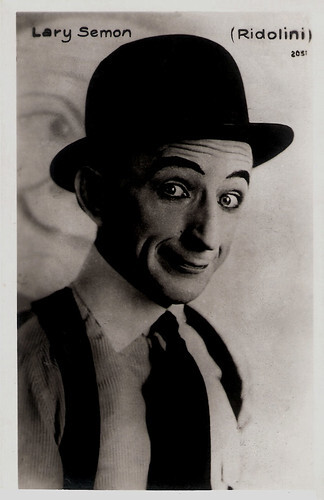
Italian postcard by G. Vettori, Bologna, no. 2051. Caption: Lary (sic) Semon (Ridolini). Sent by mail in 1925.
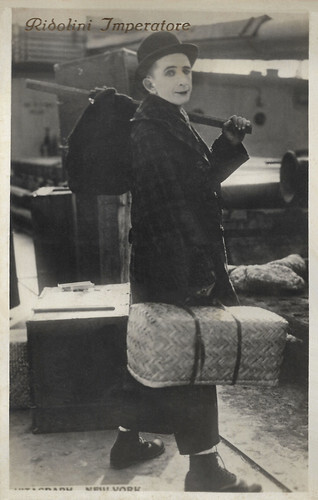
Italian postcard by G.B. Falci Editore, Milano, no. 128. Photo: Vitagraph, New York. Caption: Ridolini Imperatore. Larry Semon (Ridolini) in A Pair of Kings (Larry Semon, Norman Taurog, 1922).
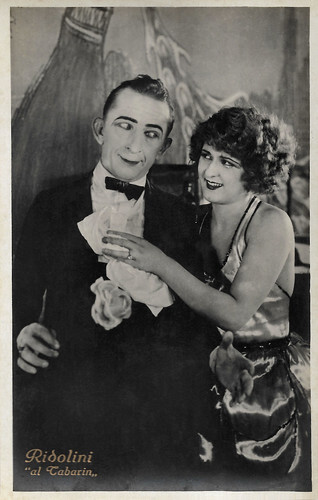
Italian postcard by G.B. Falci Editore, Milano, no. 325. Caption: Ridolini "al Tabarin". Larry Semon (Ridolini) and Kathleen Myers in The Midnight Cabaret (Larry Semon, 1923).
Laurel and Hardy
Born in West Point, Mississippi in 1889, Larry Semon was the son of a travelling Jewish vaudeville magician Zera Semon, who billed himself as "Zera the Great". His mother, Irene Semon (née Rea) worked as his assistant. Along with his older sister, Semon joined his parents' act until his father's death.
After completing his education in Savannah, Georgia, Semon moved to New York City, where he worked for The New York Sun and later The New York Morning Telegraph as a cartoonist, comics artist, and graphic artist.
While working as an artist, Semon appeared in monologues in vaudeville, where he attracted the attention of Vitagraph Studios. In 1915, he was offered a contract with the company. He quickly proved himself and was promoted to director for the Hughie Mack series of comedies. His background in magic helped him create interesting new gags for the comedian.
When Mack left the studio in 1917, Semon took over the starring role himself. His first screen appearance was in Boats and Boldness (Larry Semon, 1917), a Western in which he played an unbelievable outlaw with an easy gun. In a short time, having refined his technique and delineated the psychological profile of the clown who entertains without making people think, with his one-roll comedies where action, acrobatics, gags in bursts, simple but exhilarating, whose rhythm cut off the breath, he became a favourite with the public.
His one-reelers were quite successful, and Vitagraph sent him to California to participate in its new West Coast operation. He produced as well as wrote, starred in, and directed his own films, at the same time also producing films for other comics. He usually played a white-faced goof in derby hat and overalls who would enter any given setting (a bakery, a restaurant, a construction site, a prison camp, etc.) and cause chaos, with people being covered with debris and property being destroyed.
He became very popular in Europe. In Italy he came to fame as 'Ridolini', in France he was known as 'Zigoto', in Spain he was 'Jaimito'. Once he had developed his characteristic mask with its floured face and very high-waisted trousers, he was easily identified with the traditional circus clown of old tradition. The European public already appreciated such film clowns as the French André Deed ("Cretinetti") and the Italian Ferdinand Guillaume ("Polidor" or "Tontolini").
His short slapstick comedies were made and released quickly and prolifically, making Semon very familiar to moviegoers. In 1918 Semon began featuring in his films a young comedian named Stan Laurel, and their successful pairing seemed to portend a new comedy team. However, for reasons that were never made quite clear, Laurel left the partnership in its infancy.
Coincidentally, within a year, Laurel's future partner Oliver Hardy would join Semon's troupe, eventually becoming a prominent member. As Semon's fame grew, his films expanded from one reel (about 12 minutes) to two reels, and Semon was given a free hand in making them. This became a dangerous policy because Semon became notorious for being expensive and extravagant: his two-reel comedies could easily cost more than an average five-reel feature film.
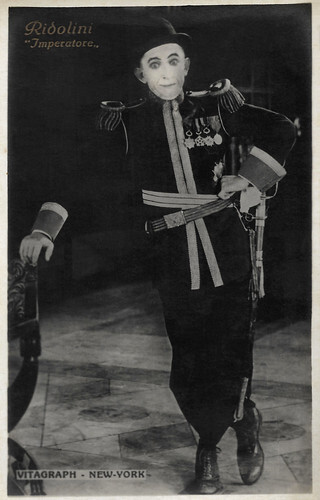
Italian postcard by G.B. Falci Editore, Milano, no. 124. Photo: Vitagraph, New York. Caption: Ridolini "Imperatore". Larry Semon (Ridolini) in A Pair of Kings (Larry Semon, Norman Taurog, 1922).
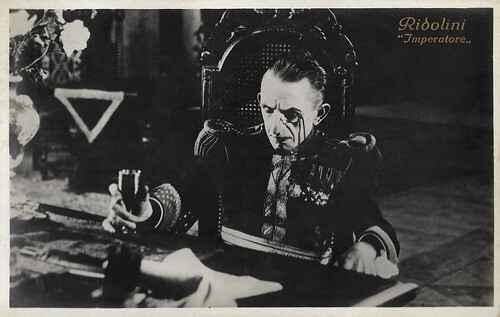
Italian postcard by G.B. Falci Editore, Milano, no. 125. Photo: Vitagraph, New York. Caption: Ridolini "Imperatore". Larry Semon (Ridolini) in A Pair of Kings (Larry Semon, Norman Taurog, 1922).
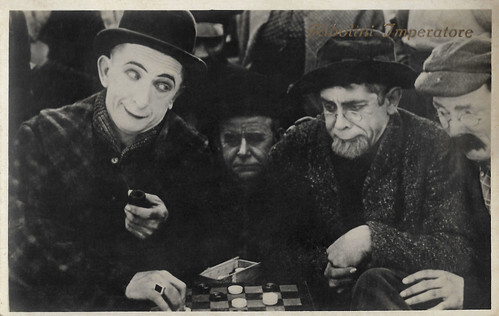
Italian postcard by G.B. Falci Editore, Milano, no. 126. Photo: Vitagraph, New York. Caption: Ridolini "Imperatore". Larry Semon (Ridolini) in A Pair of Kings (Larry Semon, Norman Taurog, 1922).
Airplane chases, exploding barns, falling water towers, and auto wrecks
As a former cartoonist, Larry Semon staged similarly cartoony sight gags, using elaborate special effects. No gag was too big for Semon. He loved chase sequences involving airplanes (sometimes using three in a film), exploding barns, falling water towers, auto wrecks and/or explosions, and liberal use of substances in which to douse people.
A typical Semon comedy might involve barrels of flour, sacks of soot, gallons of ink, gobs of jam, or pits filled with mud. For example, in Semon's The Bell Hop (Larry Semon, Norman Taurog, 1921), a man sleeping under the spray of a malfunctioning fountain imagines he is swimming in the ocean, and in his sleep, he dives off the bed, through the floor, and into a vat of paint in the lobby below.
Oliver Hardy recalled in an interview that Semon when staging his comedy short The Sawmill (Larry Semon, Norman Taurog, 1922) in a lumber camp, would not use traditional, painted stage sets. Instead, Semon insisted on building permanent log cabins complete with modern conveniences. The production budget soared, and his bosses at Vitagraph finally demanded that Semon become his own producer and underwrite his productions personally.
Semon tried to reverse his money problems by entering the more lucrative field of feature films but was none too successful. In a new partnership with producer I.E. Chadwick's Chadwick Pictures, Semon returned to two-reelers. He then embarked on what would turn out to be a disastrous dream project - an adaptation of L. Frank Baum's 'The Wonderful Wizard of Oz'.
Jim Beaver at IMDb : "The film boasted a superb cast, with Semon at the helm, and while it was wildly expensive it was enormously promising. Yet Semon failed utterly to capitalize on that promise, and the film (The Wizard of Oz (1925)) turned out to be a trite and inept run-of-the-mill comedy that seemed only to share a title and character names with Baum's beloved story, instead of the classic film it could have been."
A gangster role in Josef von Sternberg's Underworld (1927) was impressive, but a mere ripple. Larry went back in short subjects released through Educational Pictures. These also failed. After filing for bankruptcy in March 1928, Semon returned to vaudeville. While traveling on the vaudeville circuit, he suffered a nervous breakdown and went back to Los Angeles.
After returning to Los Angeles, Semon was admitted to a sanatorium in Victorville, California, where at the age of 39, he died of pneumonia and tuberculosis in 1928. His wife Dorothy Dwan was reported to be at his bedside when he died.
In its obituary for Semon, the trade paper Variety speculated that ongoing stress related to his dire financial circumstances was a contributing factor in his demise, alluding to The Wizard of Oz (1925) as the major cause of his money woes: "This screen disaster caused Mr. Semon no end of worry and repeated efforts to recoup only added to his discomfiture. Last March he filed a voluntary petition in bankruptcy, listing debts at nearly $500,000. Ceaseless worry undermined his health making him an easy victim of pneumonia."
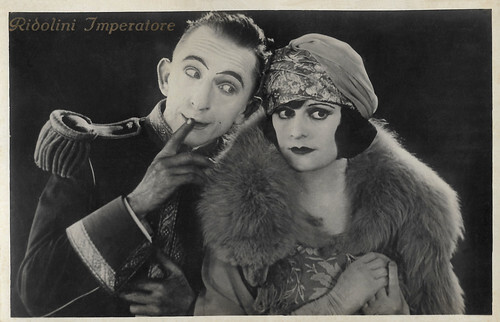
Italian postcard by G.B. Falci Editore, Milano, no. 127. Caption: Ridolini Imperatore. Larry Semon (Ridolini) and Lucille Carlisle in A Pair of Kings (Larry Semon, Norman Taurog, 1922).
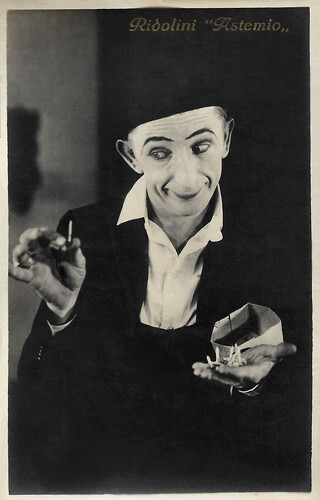
Italian postcard by G.B. Falci Editore, Milano, no. 285. Caption: Ridolini "al Tabarin". Larry Semon (Ridolini) in Trouble Brewing (James D. Davis, Larry Semon, 1924).
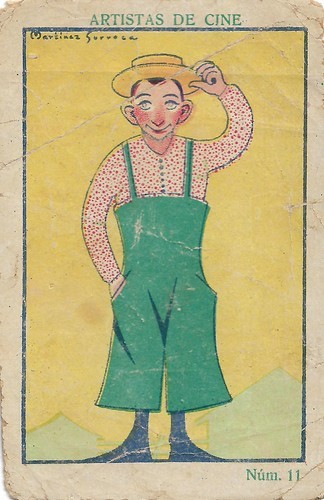
Spanish collectors card by Chocolates Amatller, Barcelona, in the 'Artistas de cine' series, no. 11: Larry Semon. Image: Martinez Surroca.
Sources: (IMDb), Wikipedia (English and Italian), and .

Italian postcard by G. Vettori, Bologna, no. 2051. Caption: Lary (sic) Semon (Ridolini). Sent by mail in 1925.

Italian postcard by G.B. Falci Editore, Milano, no. 128. Photo: Vitagraph, New York. Caption: Ridolini Imperatore. Larry Semon (Ridolini) in A Pair of Kings (Larry Semon, Norman Taurog, 1922).

Italian postcard by G.B. Falci Editore, Milano, no. 325. Caption: Ridolini "al Tabarin". Larry Semon (Ridolini) and Kathleen Myers in The Midnight Cabaret (Larry Semon, 1923).
Laurel and Hardy
Born in West Point, Mississippi in 1889, Larry Semon was the son of a travelling Jewish vaudeville magician Zera Semon, who billed himself as "Zera the Great". His mother, Irene Semon (née Rea) worked as his assistant. Along with his older sister, Semon joined his parents' act until his father's death.
After completing his education in Savannah, Georgia, Semon moved to New York City, where he worked for The New York Sun and later The New York Morning Telegraph as a cartoonist, comics artist, and graphic artist.
While working as an artist, Semon appeared in monologues in vaudeville, where he attracted the attention of Vitagraph Studios. In 1915, he was offered a contract with the company. He quickly proved himself and was promoted to director for the Hughie Mack series of comedies. His background in magic helped him create interesting new gags for the comedian.
When Mack left the studio in 1917, Semon took over the starring role himself. His first screen appearance was in Boats and Boldness (Larry Semon, 1917), a Western in which he played an unbelievable outlaw with an easy gun. In a short time, having refined his technique and delineated the psychological profile of the clown who entertains without making people think, with his one-roll comedies where action, acrobatics, gags in bursts, simple but exhilarating, whose rhythm cut off the breath, he became a favourite with the public.
His one-reelers were quite successful, and Vitagraph sent him to California to participate in its new West Coast operation. He produced as well as wrote, starred in, and directed his own films, at the same time also producing films for other comics. He usually played a white-faced goof in derby hat and overalls who would enter any given setting (a bakery, a restaurant, a construction site, a prison camp, etc.) and cause chaos, with people being covered with debris and property being destroyed.
He became very popular in Europe. In Italy he came to fame as 'Ridolini', in France he was known as 'Zigoto', in Spain he was 'Jaimito'. Once he had developed his characteristic mask with its floured face and very high-waisted trousers, he was easily identified with the traditional circus clown of old tradition. The European public already appreciated such film clowns as the French André Deed ("Cretinetti") and the Italian Ferdinand Guillaume ("Polidor" or "Tontolini").
His short slapstick comedies were made and released quickly and prolifically, making Semon very familiar to moviegoers. In 1918 Semon began featuring in his films a young comedian named Stan Laurel, and their successful pairing seemed to portend a new comedy team. However, for reasons that were never made quite clear, Laurel left the partnership in its infancy.
Coincidentally, within a year, Laurel's future partner Oliver Hardy would join Semon's troupe, eventually becoming a prominent member. As Semon's fame grew, his films expanded from one reel (about 12 minutes) to two reels, and Semon was given a free hand in making them. This became a dangerous policy because Semon became notorious for being expensive and extravagant: his two-reel comedies could easily cost more than an average five-reel feature film.

Italian postcard by G.B. Falci Editore, Milano, no. 124. Photo: Vitagraph, New York. Caption: Ridolini "Imperatore". Larry Semon (Ridolini) in A Pair of Kings (Larry Semon, Norman Taurog, 1922).

Italian postcard by G.B. Falci Editore, Milano, no. 125. Photo: Vitagraph, New York. Caption: Ridolini "Imperatore". Larry Semon (Ridolini) in A Pair of Kings (Larry Semon, Norman Taurog, 1922).

Italian postcard by G.B. Falci Editore, Milano, no. 126. Photo: Vitagraph, New York. Caption: Ridolini "Imperatore". Larry Semon (Ridolini) in A Pair of Kings (Larry Semon, Norman Taurog, 1922).
Airplane chases, exploding barns, falling water towers, and auto wrecks
As a former cartoonist, Larry Semon staged similarly cartoony sight gags, using elaborate special effects. No gag was too big for Semon. He loved chase sequences involving airplanes (sometimes using three in a film), exploding barns, falling water towers, auto wrecks and/or explosions, and liberal use of substances in which to douse people.
A typical Semon comedy might involve barrels of flour, sacks of soot, gallons of ink, gobs of jam, or pits filled with mud. For example, in Semon's The Bell Hop (Larry Semon, Norman Taurog, 1921), a man sleeping under the spray of a malfunctioning fountain imagines he is swimming in the ocean, and in his sleep, he dives off the bed, through the floor, and into a vat of paint in the lobby below.
Oliver Hardy recalled in an interview that Semon when staging his comedy short The Sawmill (Larry Semon, Norman Taurog, 1922) in a lumber camp, would not use traditional, painted stage sets. Instead, Semon insisted on building permanent log cabins complete with modern conveniences. The production budget soared, and his bosses at Vitagraph finally demanded that Semon become his own producer and underwrite his productions personally.
Semon tried to reverse his money problems by entering the more lucrative field of feature films but was none too successful. In a new partnership with producer I.E. Chadwick's Chadwick Pictures, Semon returned to two-reelers. He then embarked on what would turn out to be a disastrous dream project - an adaptation of L. Frank Baum's 'The Wonderful Wizard of Oz'.
Jim Beaver at IMDb : "The film boasted a superb cast, with Semon at the helm, and while it was wildly expensive it was enormously promising. Yet Semon failed utterly to capitalize on that promise, and the film (The Wizard of Oz (1925)) turned out to be a trite and inept run-of-the-mill comedy that seemed only to share a title and character names with Baum's beloved story, instead of the classic film it could have been."
A gangster role in Josef von Sternberg's Underworld (1927) was impressive, but a mere ripple. Larry went back in short subjects released through Educational Pictures. These also failed. After filing for bankruptcy in March 1928, Semon returned to vaudeville. While traveling on the vaudeville circuit, he suffered a nervous breakdown and went back to Los Angeles.
After returning to Los Angeles, Semon was admitted to a sanatorium in Victorville, California, where at the age of 39, he died of pneumonia and tuberculosis in 1928. His wife Dorothy Dwan was reported to be at his bedside when he died.
In its obituary for Semon, the trade paper Variety speculated that ongoing stress related to his dire financial circumstances was a contributing factor in his demise, alluding to The Wizard of Oz (1925) as the major cause of his money woes: "This screen disaster caused Mr. Semon no end of worry and repeated efforts to recoup only added to his discomfiture. Last March he filed a voluntary petition in bankruptcy, listing debts at nearly $500,000. Ceaseless worry undermined his health making him an easy victim of pneumonia."

Italian postcard by G.B. Falci Editore, Milano, no. 127. Caption: Ridolini Imperatore. Larry Semon (Ridolini) and Lucille Carlisle in A Pair of Kings (Larry Semon, Norman Taurog, 1922).

Italian postcard by G.B. Falci Editore, Milano, no. 285. Caption: Ridolini "al Tabarin". Larry Semon (Ridolini) in Trouble Brewing (James D. Davis, Larry Semon, 1924).

Spanish collectors card by Chocolates Amatller, Barcelona, in the 'Artistas de cine' series, no. 11: Larry Semon. Image: Martinez Surroca.
Sources: (IMDb), Wikipedia (English and Italian), and .
Published on March 30, 2022 22:00
March 29, 2022
Eva Ingeborg Scholz (1928-2022)
On 21 March 2022, German film and television actress Eva Ingeborg Scholz (1928-2022) passed away. Since her East-German debut in 1948, she played in more than 110 film and television productions. Scholz was 94.
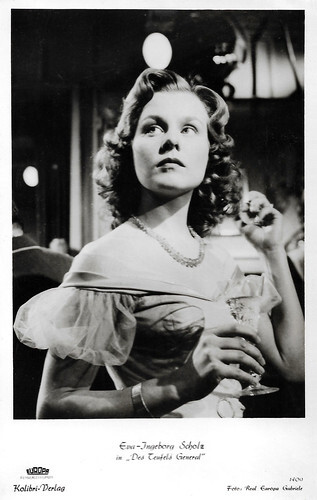
West-German postcard by Kolibri-Verlag, no. 1400. Photo: Real / Europa Film-Verleih / Gabriele. Eva Ingeborg Scholz in Des Teufels General/The Devil's General (Helmut Käutner, 1955).
Expressive eyes, and a strong on-screen presence
Eva Ingeborg Scholz was born in 1928 in Brandenburg, Prussia. She attended the Max Reinhardt School and acted at the Schlosspark Theatre and the Renaissance Theatre from 1947 to 1950.
From 1950 to 1953 she was engaged at the Komödie Berlin, after which she was part of the ensemble at the Münchner Kammerspiele. As an ensemble member, she covered both comedic and dramatic assignments.
She made her film debut in the title role of the East German film 1-2-3 Corona (Hans Müller, 1948) opposite Lutz Moik . It was a post-war love story with a circus setting, filmed at Ufa's Babelsberg studio.
I.S. Mowis at IMDb : "Though diminutive and rather unimposing in stature, she had expressive eyes, and, as it turned out, possessed a strong on-screen presence." From then on, she appeared regularly in films, including a performance as a young lodger in Peter Lorre 's only directorial effort, the West-German drama Der Verlorene/The Lost One (1951).
Scholz alternated leading roles in light comedies and operettas such as Pension Schöller (Georg Jacoby, 1952) and Ball im Savoy/Ball at the Savoy (Paul Martin, 1955)) with high profile supporting parts in dramas. She did her best acting in films with a wartime theme, such as a supporting role opposite Curd Jürgens in Des Teufels General/The Devil's General (Helmut Käutner, 1955), based on the play by Carl Zuckmayer.
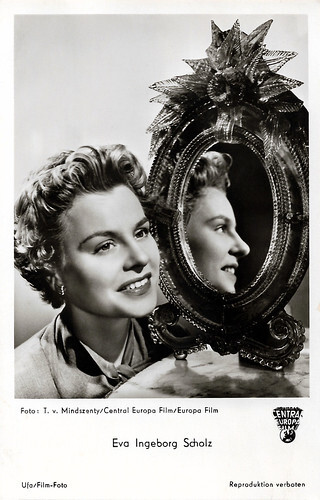
West-German postcard by Ufa/Film-Foto, Berlin-Tempelhof, no. 1652. Photo: T. v. Mindszenty / Central Europa Film / Europa Film. Eva Ingeborg Scholz in Ball im Savoy/Ball at the Savoy (Paul Martin, 1955).
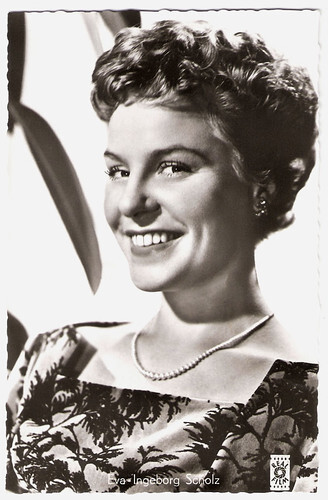
West-German postcard by Kolibri-Verlag G,m.b.H., Minden/Westf., no. 1635. Photo: Real / Rank-Film / v Mindszenty. Eva Ingeborg Scholz in Unternehmen Schlafsack/Operation Sleeping Bag (Arthur Maria Rabenalt, 1955).
Disney and Fassbinder
From the early 1960s, Eva Ingeborg Scholz appeared increasingly on television, where she remained active until the age of 90 years in 2018. She appeared in popular television Krimi series like Tatort, Derrick, Der Alte/The Old Fox, and SOKO Stuttgart/Stuttgart Homicide.
In 2018, she won the Deutscher Schauspielpreis (German Actors Award) for her supporting role in the Tatort episode Die Liebe, ein seltsames Spiel (2017).
Eva-Ingeborg Scholz also worked as a dubbing artist and lent her voice to the title character of the animated film Cinderella (Clyde Geronimi, Wilfred Jackson, Hamilton Luske, 1950) and to Alice's sister in Alice in Wonderland (Clyde Geronimi, Wilfred Jackson, Hamilton Luske, 1951).
Among her later films are the Disney production Emil and the Detectives (Peter Tewksbury, 1964), based on the novel by Erich Kästner, in which she played Emil's mother, and Rainer Werner Fassbinder 's Der amerikanische Soldat/The American Soldier (1970). One of her final films was the comedy Die Apothekerin/The Pharmacist (Rainer Kaufmann, 1997) with Katja Riemann .
She was married twice. Her first husband was screenwriter Georg Hurdalek with whom she had a son, Stefan Hurdalek (1951). In 1953, she married actor Wilfried Seyferth but he died a year later in a car accident. Their daughter is actress Katharina Seyferth (1954). Eva Ingeborg Scholz lived and worked in Gräfelfing near Munich. She died in March 2022 at the age of 94.
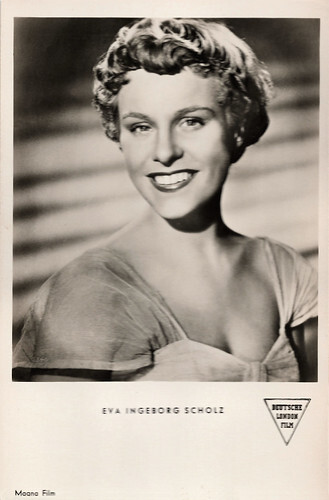
West-German postcard by Kunst und Bild, Berlin, no. A 566. Photo: Magna Film / Deutsche London Film. Eva Ingeborg Scholz in Pension Schöller (Georg Jacoby, 1952).
Sources: (IMDb), Wikipedia (German and English), and .

West-German postcard by Kolibri-Verlag, no. 1400. Photo: Real / Europa Film-Verleih / Gabriele. Eva Ingeborg Scholz in Des Teufels General/The Devil's General (Helmut Käutner, 1955).
Expressive eyes, and a strong on-screen presence
Eva Ingeborg Scholz was born in 1928 in Brandenburg, Prussia. She attended the Max Reinhardt School and acted at the Schlosspark Theatre and the Renaissance Theatre from 1947 to 1950.
From 1950 to 1953 she was engaged at the Komödie Berlin, after which she was part of the ensemble at the Münchner Kammerspiele. As an ensemble member, she covered both comedic and dramatic assignments.
She made her film debut in the title role of the East German film 1-2-3 Corona (Hans Müller, 1948) opposite Lutz Moik . It was a post-war love story with a circus setting, filmed at Ufa's Babelsberg studio.
I.S. Mowis at IMDb : "Though diminutive and rather unimposing in stature, she had expressive eyes, and, as it turned out, possessed a strong on-screen presence." From then on, she appeared regularly in films, including a performance as a young lodger in Peter Lorre 's only directorial effort, the West-German drama Der Verlorene/The Lost One (1951).
Scholz alternated leading roles in light comedies and operettas such as Pension Schöller (Georg Jacoby, 1952) and Ball im Savoy/Ball at the Savoy (Paul Martin, 1955)) with high profile supporting parts in dramas. She did her best acting in films with a wartime theme, such as a supporting role opposite Curd Jürgens in Des Teufels General/The Devil's General (Helmut Käutner, 1955), based on the play by Carl Zuckmayer.

West-German postcard by Ufa/Film-Foto, Berlin-Tempelhof, no. 1652. Photo: T. v. Mindszenty / Central Europa Film / Europa Film. Eva Ingeborg Scholz in Ball im Savoy/Ball at the Savoy (Paul Martin, 1955).

West-German postcard by Kolibri-Verlag G,m.b.H., Minden/Westf., no. 1635. Photo: Real / Rank-Film / v Mindszenty. Eva Ingeborg Scholz in Unternehmen Schlafsack/Operation Sleeping Bag (Arthur Maria Rabenalt, 1955).
Disney and Fassbinder
From the early 1960s, Eva Ingeborg Scholz appeared increasingly on television, where she remained active until the age of 90 years in 2018. She appeared in popular television Krimi series like Tatort, Derrick, Der Alte/The Old Fox, and SOKO Stuttgart/Stuttgart Homicide.
In 2018, she won the Deutscher Schauspielpreis (German Actors Award) for her supporting role in the Tatort episode Die Liebe, ein seltsames Spiel (2017).
Eva-Ingeborg Scholz also worked as a dubbing artist and lent her voice to the title character of the animated film Cinderella (Clyde Geronimi, Wilfred Jackson, Hamilton Luske, 1950) and to Alice's sister in Alice in Wonderland (Clyde Geronimi, Wilfred Jackson, Hamilton Luske, 1951).
Among her later films are the Disney production Emil and the Detectives (Peter Tewksbury, 1964), based on the novel by Erich Kästner, in which she played Emil's mother, and Rainer Werner Fassbinder 's Der amerikanische Soldat/The American Soldier (1970). One of her final films was the comedy Die Apothekerin/The Pharmacist (Rainer Kaufmann, 1997) with Katja Riemann .
She was married twice. Her first husband was screenwriter Georg Hurdalek with whom she had a son, Stefan Hurdalek (1951). In 1953, she married actor Wilfried Seyferth but he died a year later in a car accident. Their daughter is actress Katharina Seyferth (1954). Eva Ingeborg Scholz lived and worked in Gräfelfing near Munich. She died in March 2022 at the age of 94.

West-German postcard by Kunst und Bild, Berlin, no. A 566. Photo: Magna Film / Deutsche London Film. Eva Ingeborg Scholz in Pension Schöller (Georg Jacoby, 1952).
Sources: (IMDb), Wikipedia (German and English), and .
Published on March 29, 2022 22:00
March 28, 2022
Simone de Oliveira
Simone de Oliveira (1938), also known as Simone, is one of the great divas of Portugal. The accomplished singer represented Portugal at the Eurovision Song Contest twice, in 1965 and 1969. In an era ruled by dictatorial regimen, the lyrics of her evergreen 'Desfolhada' touched Portuguese hearts deeply. Simone also has decades of acting experience in films, theatre, and soap operas. Tonight, 29 March 2022, she gives her farewell performance at the Coliseo in Lissabon. Although we here at EFSP are fans of many film stars, some people have a special place in our hearts. Simone de Oliveira is one of them. We met her in 2009 and since then we are fans.
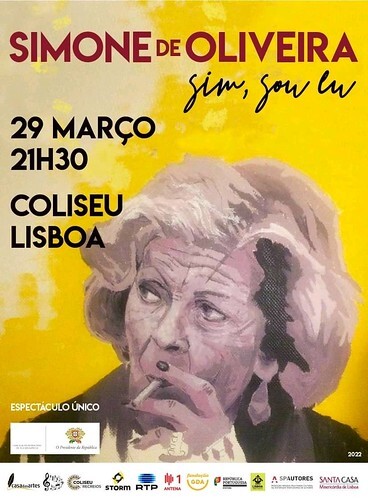
Portuguese advertisement. 19 March, Coliseu, Lisboa: Simone de Oliveira.
A surprise meeting
First, our memory of Simone. In July 2009, we spent a week in Lissabon. We stayed in a former cinema, the Eden, at the Avenida da Liberdade. The Eden was one of the grand movie palaces on the Avenida when classical Hollywood cinema ruled. The Eden closed in 1989 and in 1991 it was used as a location in Wim Wenders film Until the End of the World. In 2001 the building was converted into a huge four-star hotel while retaining part of the original facade.
Every night we took an old tram up the hill to the Bairro Alto where there are many old bars and restaurants. One day someone suggested we visit a special restaurant that was frequented by many gays, lesbians, and other interesting people. When we arrived at the restaurant, the waiter told us that it was unfortunately full. We chatted a bit and told the waiter where we were coming from. The waiter smiled. He was a huge fan of the city of Amsterdam and said there might be a table next to the kitchen.
That was fine with us. A table was cleared and a few regulars kindly moved over. We ended up sitting next to an elegant older blonde, who was drinking a huge bubble of whiskey while chain-smoking. It became a night to remember. The food was delicious, the wine was even better and the company was excellent. We had a lot of fun with the waiter and the other guests.
The waiter kept putting on unintelligible but beautiful music for us by a Portuguese singer. Sometimes it was cheerful, sometimes melancholic. At the end of the evening, I asked who the singer was. He showed me his CD of Simone and pointed at our neighbour. It was her! We applauded.
The next day I immediately bought her album 'Perfil'. When I showed it to a Portuguese friend and told her that we had met this lady the night before, our friend almost fainted. Simone is a true legend in Portugal, as big as Barbra Streisand in the US. Of course, we went looking for postcards of her. Fortunately, we finally were able to find one.

Portuguese card by Decca.
Descendant of an African King
Simone de Macedo de Oliveira was born in 1938 in Lisbon, Portugal. Her father was Guy de Macedo de Oliveira, and her mother Maria do Carmo Lopes da Silva. He was a descendant of an African King of São Tomé e Príncipe in the nineteenth-century Portuguese territory.
Simone started singing in high school. When she was 19 she had a depression. Her doctor told her that she needed to find something to do. Simone decided to go to the Centro de Preparação de Artistas da Emissora Naional (Artists Preparation Center of National Emission).
The first time Simone sang in public was at the Festival da Canção Portuguesa (Portuguese Song Festival) in 1958. She placed third with the song 'Olhos nos Olhos' (Eyes in Eyes).
In the following decade, she performed several times at the popular Festival da Canção Portuguesa. In 1965 she won the festival with the song 'Sol de Inverno' (Winter's Sun) and represented Portugal at the Eurovision Song Contest 1965.
Simone sings 'Sol de Inverno' at the Eurovision Song Contest 1965. Source: RTP (YouTube).
Important Stage Actress
Simone also became an important stage actress in Portugal.
In 1962 she had made her theater debut, and she appeared in plays like: 'O Contracto' (The Contract), 'A menina Alice e o Inspector' (Miss Alice and the Inspector), 'A Tragédia da Rua das Flores' (The Tragedy of Flowers Street), and 'Conheci Miguel Torga' (I meet Miguel Torga).
A great popular success in Portugal was 'Passa por mim no Rossio'.
Another success was the homage to the singer Madalena Iglésias who represented Portugal at the Eurovision Song Contest in 1966 in the musical play 'What happened to Madalena Iglésias?' in which Simone played the leading role.
Simone reached the breaking point of her singing career in 1969 with the song 'Desfolhada portuguesa', with lyrics by José Carlos Ary dos Santos and music by Nuno Nazareth Fernandes.
This song was a great success in Portugal, with innovative lyrics in Portugal at the time of the dictatorship of António de Oliveira Salazar. The song represented Portugal at the Eurovision Song Contest 1969 in Madrid. Despite its popularity in Portugal, this song was not successful at the ESC, getting only 4 votes.
After singing 'Desfolhada Portuguesa' she lost her voice for years. During these years she worked in journalism, radio, and hosted TV shows.
Simone de Oliveira sings Desfolhada Portuguesa at the Eurovision Song Contest 1969. Source: Eurovision Portugal (YouTube).
Breast Cancer Survivor
Simone returned to the stages in 1973, with a deeper, still potent, voice, and in 1979 she won the Festival da Nova Canção de Lisboa (New Song Lisbon Festival) with the song 'Sempre que tu vens é Primavera' (Every time you come it's Spring).
She starred on stage and also appeared in four films: Canção da saudade (Henrique Campos, 1964), the action thriller Operação diamante (Pedro Martins, 1967), Cântico final (Manuel Guimarães, 1976) and the drama A estrangeira (João Mário Grilo, 1983) with Fernando Rey.
In 1987 she successfully fought breast cancer, and in 1997 she celebrated her 40 years of career. Simone also appeared regularly on television, where she hosted many shows and acted in soap operas like Tu e Eu (2006) and Vila Faia (2008-2009), and many other series.
In 2009 Simone returned to the spotlight, with a new album, 'Perfil', including 36 of her most memorable hits. At the Festival da Canção de 2010 (the 2010 Portuguese Song Contest), she once again performed 'Desfolhada', wearing the same dress she had worn 40 years before when she won the Festival in 1969. In 2011, at the XVI edition of the Golden Globes (Portugal), she received the Golden Globe of Merit and Excellence from Dr. Pinto Balsemão.
Simone de Oliveira was married twice: first to António José Coimbra Mano and later to actor Varela Silva. With her first husband, she had two children: Maria Eduarda and António Pedro. She has two ex-stepdaughters from Varela Silva’s first marriage (to Celeste Rodrigues, and she has two grandsons.
In March 2021, Simone de Oliveira announced that she had decided to put an end to her career and would give one last performance. Finally, after a long delay by Covid, that's possible and today, 29 March 2022, Simone will perform and bid farewell. Thank you for your wonderful music, great diva!
Tribute to Simone de Oliveira at the Festival da Canção 2018. Source: EFestival da Canção (YouTube).
Sources: Nelson Costa (Oikotimes.com), Wikipedia (English and Portuguese), and .

Portuguese advertisement. 19 March, Coliseu, Lisboa: Simone de Oliveira.
A surprise meeting
First, our memory of Simone. In July 2009, we spent a week in Lissabon. We stayed in a former cinema, the Eden, at the Avenida da Liberdade. The Eden was one of the grand movie palaces on the Avenida when classical Hollywood cinema ruled. The Eden closed in 1989 and in 1991 it was used as a location in Wim Wenders film Until the End of the World. In 2001 the building was converted into a huge four-star hotel while retaining part of the original facade.
Every night we took an old tram up the hill to the Bairro Alto where there are many old bars and restaurants. One day someone suggested we visit a special restaurant that was frequented by many gays, lesbians, and other interesting people. When we arrived at the restaurant, the waiter told us that it was unfortunately full. We chatted a bit and told the waiter where we were coming from. The waiter smiled. He was a huge fan of the city of Amsterdam and said there might be a table next to the kitchen.
That was fine with us. A table was cleared and a few regulars kindly moved over. We ended up sitting next to an elegant older blonde, who was drinking a huge bubble of whiskey while chain-smoking. It became a night to remember. The food was delicious, the wine was even better and the company was excellent. We had a lot of fun with the waiter and the other guests.
The waiter kept putting on unintelligible but beautiful music for us by a Portuguese singer. Sometimes it was cheerful, sometimes melancholic. At the end of the evening, I asked who the singer was. He showed me his CD of Simone and pointed at our neighbour. It was her! We applauded.
The next day I immediately bought her album 'Perfil'. When I showed it to a Portuguese friend and told her that we had met this lady the night before, our friend almost fainted. Simone is a true legend in Portugal, as big as Barbra Streisand in the US. Of course, we went looking for postcards of her. Fortunately, we finally were able to find one.

Portuguese card by Decca.
Descendant of an African King
Simone de Macedo de Oliveira was born in 1938 in Lisbon, Portugal. Her father was Guy de Macedo de Oliveira, and her mother Maria do Carmo Lopes da Silva. He was a descendant of an African King of São Tomé e Príncipe in the nineteenth-century Portuguese territory.
Simone started singing in high school. When she was 19 she had a depression. Her doctor told her that she needed to find something to do. Simone decided to go to the Centro de Preparação de Artistas da Emissora Naional (Artists Preparation Center of National Emission).
The first time Simone sang in public was at the Festival da Canção Portuguesa (Portuguese Song Festival) in 1958. She placed third with the song 'Olhos nos Olhos' (Eyes in Eyes).
In the following decade, she performed several times at the popular Festival da Canção Portuguesa. In 1965 she won the festival with the song 'Sol de Inverno' (Winter's Sun) and represented Portugal at the Eurovision Song Contest 1965.
Simone sings 'Sol de Inverno' at the Eurovision Song Contest 1965. Source: RTP (YouTube).
Important Stage Actress
Simone also became an important stage actress in Portugal.
In 1962 she had made her theater debut, and she appeared in plays like: 'O Contracto' (The Contract), 'A menina Alice e o Inspector' (Miss Alice and the Inspector), 'A Tragédia da Rua das Flores' (The Tragedy of Flowers Street), and 'Conheci Miguel Torga' (I meet Miguel Torga).
A great popular success in Portugal was 'Passa por mim no Rossio'.
Another success was the homage to the singer Madalena Iglésias who represented Portugal at the Eurovision Song Contest in 1966 in the musical play 'What happened to Madalena Iglésias?' in which Simone played the leading role.
Simone reached the breaking point of her singing career in 1969 with the song 'Desfolhada portuguesa', with lyrics by José Carlos Ary dos Santos and music by Nuno Nazareth Fernandes.
This song was a great success in Portugal, with innovative lyrics in Portugal at the time of the dictatorship of António de Oliveira Salazar. The song represented Portugal at the Eurovision Song Contest 1969 in Madrid. Despite its popularity in Portugal, this song was not successful at the ESC, getting only 4 votes.
After singing 'Desfolhada Portuguesa' she lost her voice for years. During these years she worked in journalism, radio, and hosted TV shows.
Simone de Oliveira sings Desfolhada Portuguesa at the Eurovision Song Contest 1969. Source: Eurovision Portugal (YouTube).
Breast Cancer Survivor
Simone returned to the stages in 1973, with a deeper, still potent, voice, and in 1979 she won the Festival da Nova Canção de Lisboa (New Song Lisbon Festival) with the song 'Sempre que tu vens é Primavera' (Every time you come it's Spring).
She starred on stage and also appeared in four films: Canção da saudade (Henrique Campos, 1964), the action thriller Operação diamante (Pedro Martins, 1967), Cântico final (Manuel Guimarães, 1976) and the drama A estrangeira (João Mário Grilo, 1983) with Fernando Rey.
In 1987 she successfully fought breast cancer, and in 1997 she celebrated her 40 years of career. Simone also appeared regularly on television, where she hosted many shows and acted in soap operas like Tu e Eu (2006) and Vila Faia (2008-2009), and many other series.
In 2009 Simone returned to the spotlight, with a new album, 'Perfil', including 36 of her most memorable hits. At the Festival da Canção de 2010 (the 2010 Portuguese Song Contest), she once again performed 'Desfolhada', wearing the same dress she had worn 40 years before when she won the Festival in 1969. In 2011, at the XVI edition of the Golden Globes (Portugal), she received the Golden Globe of Merit and Excellence from Dr. Pinto Balsemão.
Simone de Oliveira was married twice: first to António José Coimbra Mano and later to actor Varela Silva. With her first husband, she had two children: Maria Eduarda and António Pedro. She has two ex-stepdaughters from Varela Silva’s first marriage (to Celeste Rodrigues, and she has two grandsons.
In March 2021, Simone de Oliveira announced that she had decided to put an end to her career and would give one last performance. Finally, after a long delay by Covid, that's possible and today, 29 March 2022, Simone will perform and bid farewell. Thank you for your wonderful music, great diva!
Tribute to Simone de Oliveira at the Festival da Canção 2018. Source: EFestival da Canção (YouTube).
Sources: Nelson Costa (Oikotimes.com), Wikipedia (English and Portuguese), and .
Published on March 28, 2022 22:00
March 27, 2022
Mady Christians
Austrian-born stage actress Mady Christians (1892-1951) was a star of the German silent cinema and appeared in Austrian, French, British, and Hollywood films too.
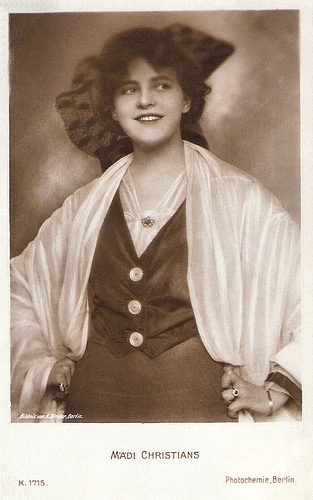
German postcard by Photochemie, Berlin, no. K. 1715. Photo: Alex Binder, Berlin.
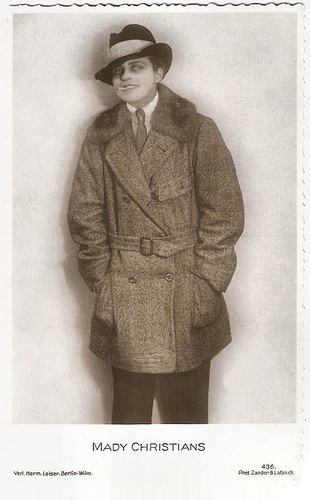
German postcard by Verlag Hermann Leiser. Berlin-Wilm., no. 436. Photo: Zander & Labisch.
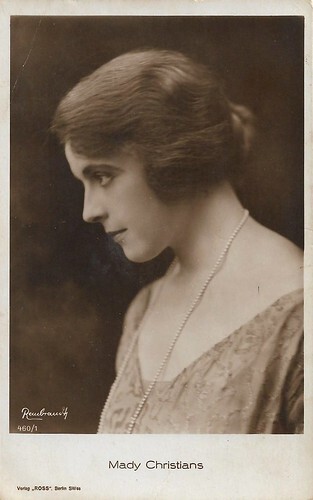
German postcard by Ross Verlag, no. 460/1, 1919-1924. Photo: Rembrandt.
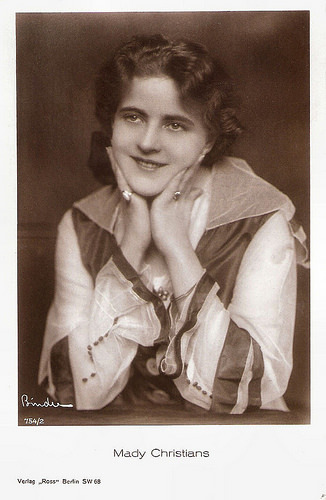
German postcard by Ross Verlag, Berlin, no. 754/2, 1925-1926. Photo: Alex Binder, Berlin.
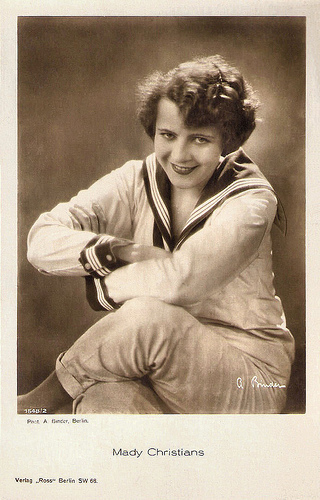
German postcard by Ross Verlag, no. 1548/2, 1927-1928. Photo: Alex Binder, Berlin.
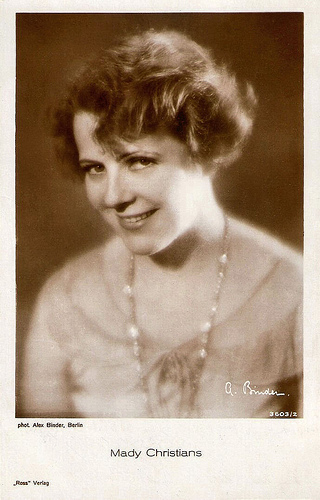
German postcard by Ross Verlag, no. 3603/2, 1928-1929. Photo: Alex Binder, Berlin.
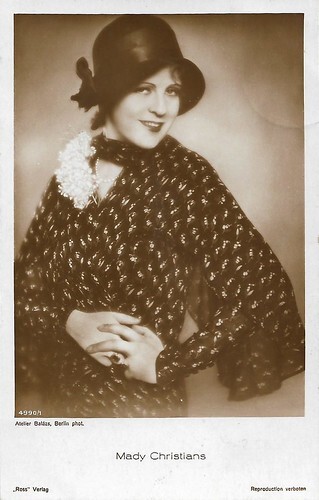
German postcard by Ross Verlag, no. 4990/1, 1929-1930. Photo: Atelier Balazs, Berlin.
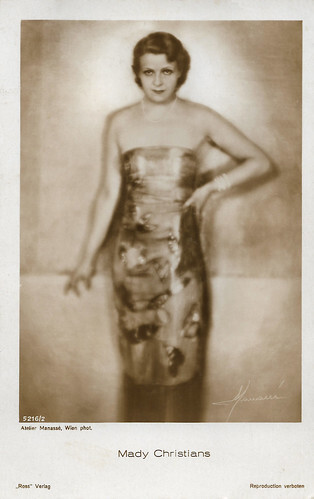
German postcard by Ross Verlag, no. 5216/2, 1930-1931. Photo: Atelier Manassé, Wien.
The Man Without a Name
Mady Christians was born as Marguerita Maria Christians in Vienna, Austria-Hungary (now Austria) in 1892. She was the daughter of opera singer Bertha Klein and actor Rudolph Christians. When her father took over a German-speaking theater in New York in 1912, the whole family went to the USA, where Mady made her film debut in Audrey (Robert G. Vignola, 1916) as Margarete Christians.
Because of World War I, Mady and her mother returned mother to Europe and she studied in Berlin with Max Reinhardt . She worked as a stage actress, but soon she was monopolised by the new cinema world.
She played leads in silent films like Die fremde Frau/The Strange Woman (Hubert Moest, 1917) with Hedda Vernon , Nachtschatten/Night Shadows (Friedrich Zelnik aka Frederic Zelnik, 1918), and Die Gesunkenen/The Down-and-outs (Fred Sauer, 1919). Her breakthrough was her part in the serial Der Mann ohne Namen/The Man Without A Name (Georg Jacoby, 1921) with Harry Liedtke as the thief Peter Voss.
In the following years, she appeared in several classics of the Weimar cinema such as Das Weib des Pharao/Pharoah's Wife (Ernst Lubitsch, 1922), Ein Glas Wasser/One Glass of Water (Ludwig Berger, 1923), Die Finanzen des Großherzogs/Finances of the Grand Duke (F.W. Murnau, 1924), Michael (Carl Theodor Dreyer, 1924), Ein Walzertraum/The Waltz Dream (Ludwig Berger, 1925) and in the two-part costume drama Königin Luise/Queen Louise (Karl Grune, 1927-1928).
In 1928 she founded with director Ludwig Berger the Länder-Film Company in Berlin, but the company was already finished by 1931. She acted in the British production The Runaway Princess (Anthony Asquith, Fritz Wendhausen, 1929) and in the French Mon coeur incognito/My Heart is Incognito (André-Paul Antoine, Manfred Noa, 1930) opposite Jean Angelo , an alternative language version of Leutnant warst Du einst bei deinen Husaren (Manfred Noa, 1930) with Gustav Diessl . The German sound film offered her only little work, but she did appear in Das Schicksal der Renate Langen/The Fate of Renate Langen (Rudolf Walther-Fein, 1931) and Friederike/Frederica (Fritz Friedmann-Frederich, 1932).
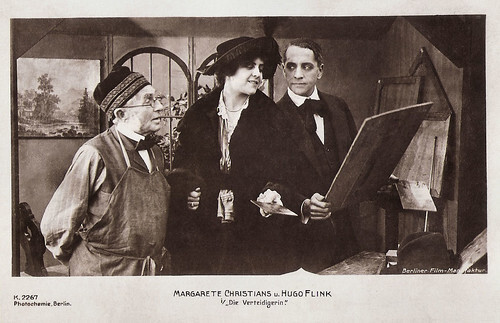
German postcard by Photochemie, no. K. 2267. Photo: Berliner Film-Manufaktur. Mady Christians (here: Margarethe Christians) and Hugo Flink in Die Verteidigerin/The Defender (Friedrich Zelnik, 1918).
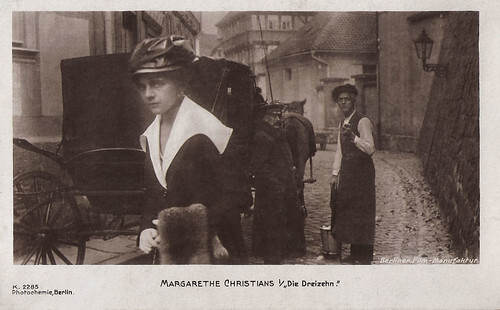
German postcard by Photochemie, no. K. 2285. Photo: Berliner Film-Manufaktur. Mady Christians (here: Margarethe Christians) in Die Dreizehn/The Thirteen (Alfred Halm, 1918).
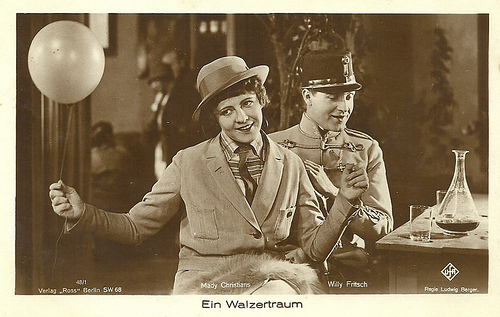
German postcard by Ross Verlag, no. 48/1. Mady Christians and Willy Fritsch in the Ufa-film Ein Walzertraum (Ludwig Berger, 1925).
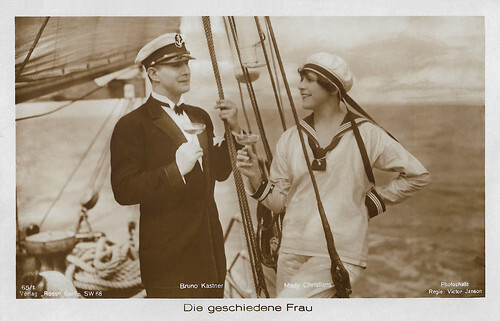
German postcard by Ross Verlag, no. 65/1. Photo: Aafa-Film. Mady Christians and Bruno Kastner in Die geschiedene Frau/The Divorcée (Victor Janson, 1926).
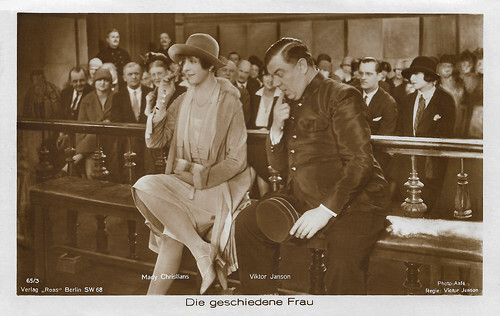
German postcard by Ross Verlag, no. 65/3. Photo: Aafa-Film. Mady Christians and Viktor Janson in Die geschiedene Frau/The Divorcée (Victor Janson, 1926).
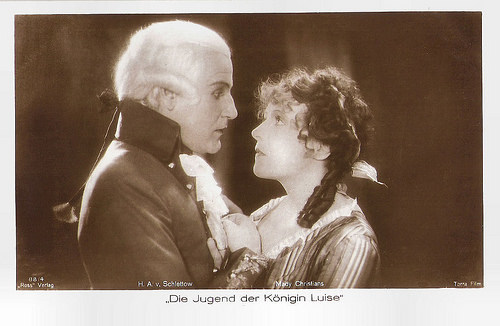
German postcard by Ross Verlag, no. 88/4. Photo: Terra Film. Publicity still for Königin Luise, 1. Teil - Die Jugend der Königin Luise/Queen Louise (Karl Grune, 1927) with Hans Adalbert Schlettow .
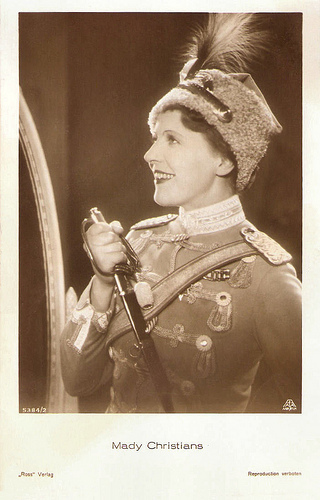
German postcard by Ross Verlag, no. 5384/2, 1930-1931. Photo: AAFA Film. Publicity still for Leutnant warst Du einst bei deinen Husaren/Lieutenant were you once with your Hussar (Manfred Noa, 1930).
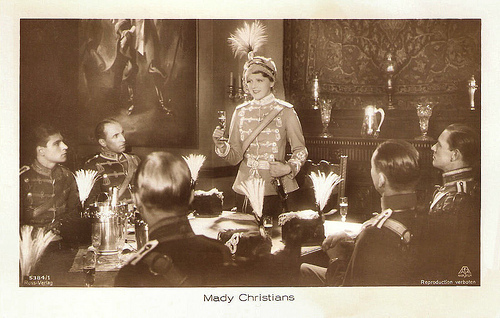
German postcard by Ross Verlag, no. 5384/1, 1930-1931. Photo: AAFA Film. Publicity still for Leutnant warst Du einst bei deinen Husaren/Lieutenant were you once with your Hussar (Manfred Noa, 1930).
I Remember Mama
After the assumption of power by the Nazis in 1933, Mady Christians emigrated to the United States. In the following decades, she shuttled between Hollywood and Broadway.
In Hollywood, she starred in The Only Girl (Frederick Hollander/Friedrich Holländer, 1934) with Charles Boyer . She appeared in several popular pictures like A Wicked Woman (Charles Brabin, 1934), Escapade (Robert Z. Leonard, 1935) with William Powell, Come and Get It (Howard Hawks a.o., 1936), Seventh Heaven (Henry King, 1937) with James Stewart , and Tender Comrade (Edward Dmytryk, 1943) with Ginger Rogers .
In films, she tended to play supporting character parts, while on stage she continued to find leading roles. On Broadway, she originated the title role in the play I Remember Mama (1944). In 1945 she became a drama teacher at Columbia University.
Her last movie roles were in Letter from an Unknown Woman (Max Ophüls, 1948) and All My Sons (Irving Reis, 1948) based on the play by Arthur Miller, in which she co-starred with Burt Lancaster and Edward G. Robinson .
In 1950 she was blacklisted after being labelled a communist sympathizer during the McCarthy-era ‘witch trials’. Mady Christians died in 1951 in Norwalk, Connecticut, from a cerebral haemorrhage.
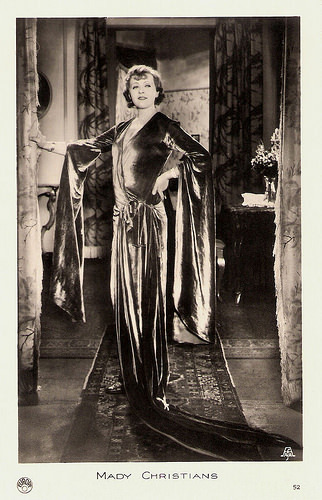
French postcard by Europe, no. 52. Photo: Aafa.
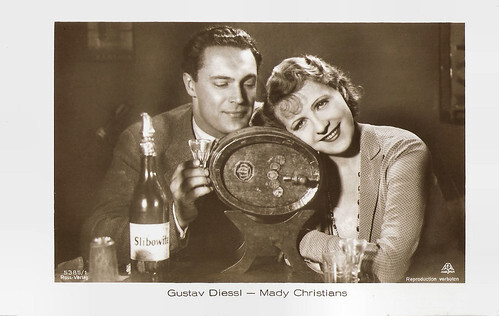
German postcard by Ross Verlag, no. 5385/1, 1930-1931. Photo: Aafa-Film. Gustav Diessl and Mady Christians in Leutnant warst Du einst bei deinen Husaren/Lieutenant were you once with your Hussar (Manfred Noa, 1930).
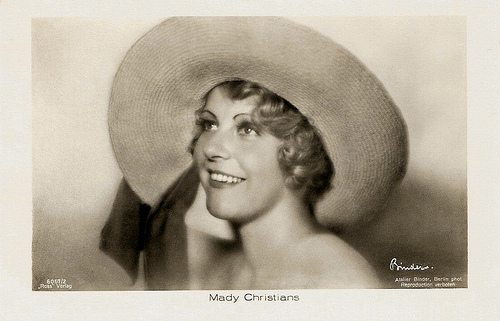
German postcard by Ross Verlag, no. 6067/2, 1931-1932. Photo: Alex Binder, Berlin.
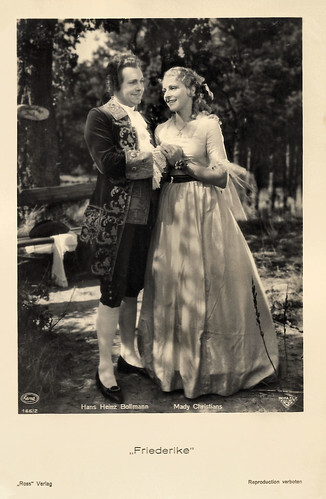
German postcard by Ross Verlag, no. 166/2. Photo: Indra-Film. Mady Christians and Hans Heinz Bollmann in Friederike/Frederica (Fritz Friedmann-Frederich, 1932).
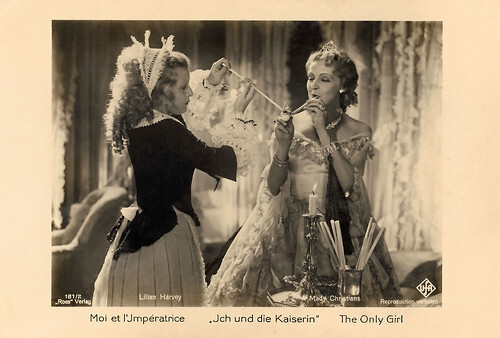
German postcard by Ross Verlag, no. 181/2. Photo: Ufa. Lilian Harvey and Mady Christians in Ich und die Kaiserin (1933).
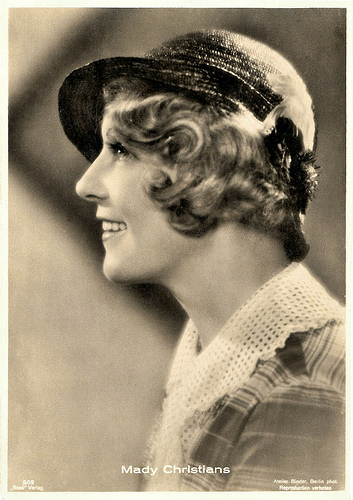
German postcard by Ross Verlag, no. 609 (Ross Luxus Series). Photo: Atelier Binder, Berlin.
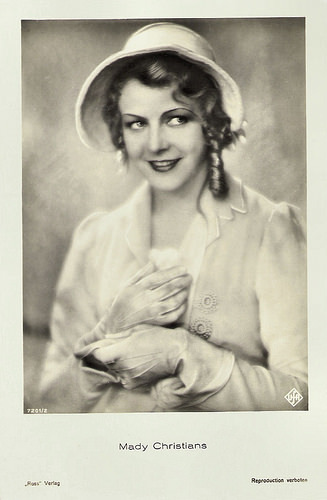
German postcard by Ross Verlag, Berlin, no. 7201/2, 1932-1933. Photo: Ufa.
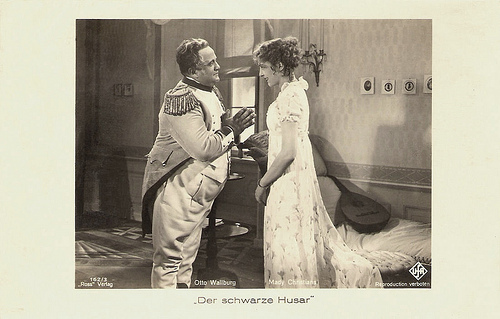
German postcard by Ross Verlag, no. 152/3 Photo: Ufa. Publicity still for Der Schwarze Husar/The Black Hussar (Gerhard Lamprecht, 1932) with Otto Wallburg .
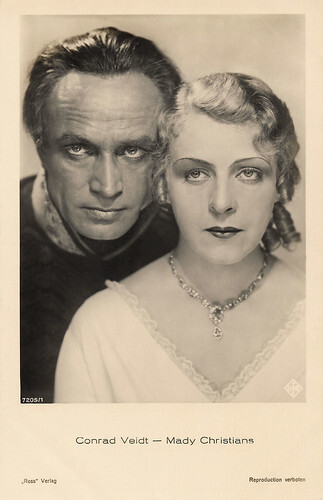
German postcard by Ross Verlag, Berlin, no. 7205/1. Photo: Ufa. Conrad Veidt and Mady Christians in Der schwarze Husar/The Black Hussar (Gerhard Lamprecht, 1932).
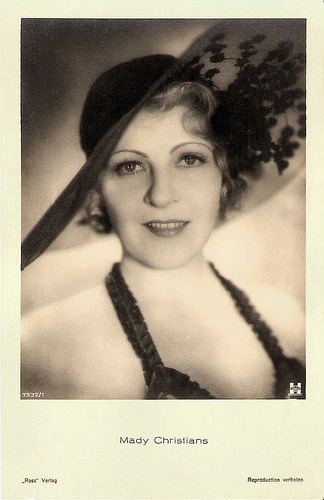
German postcard by Ross Verlag, no. 7532/1, 1932-1933. Photo: Hisa-Film. Publicity still for Manolescu, der Fürst der Diebe/Manolescu, the King of Thieves (Georg C. Klaren, Willi Wolff, 1933).
Source: Thomas Staedeli (Cyranos), (IMDb), AllMovie, Wikipedia, and .

German postcard by Photochemie, Berlin, no. K. 1715. Photo: Alex Binder, Berlin.

German postcard by Verlag Hermann Leiser. Berlin-Wilm., no. 436. Photo: Zander & Labisch.

German postcard by Ross Verlag, no. 460/1, 1919-1924. Photo: Rembrandt.

German postcard by Ross Verlag, Berlin, no. 754/2, 1925-1926. Photo: Alex Binder, Berlin.

German postcard by Ross Verlag, no. 1548/2, 1927-1928. Photo: Alex Binder, Berlin.

German postcard by Ross Verlag, no. 3603/2, 1928-1929. Photo: Alex Binder, Berlin.

German postcard by Ross Verlag, no. 4990/1, 1929-1930. Photo: Atelier Balazs, Berlin.

German postcard by Ross Verlag, no. 5216/2, 1930-1931. Photo: Atelier Manassé, Wien.
The Man Without a Name
Mady Christians was born as Marguerita Maria Christians in Vienna, Austria-Hungary (now Austria) in 1892. She was the daughter of opera singer Bertha Klein and actor Rudolph Christians. When her father took over a German-speaking theater in New York in 1912, the whole family went to the USA, where Mady made her film debut in Audrey (Robert G. Vignola, 1916) as Margarete Christians.
Because of World War I, Mady and her mother returned mother to Europe and she studied in Berlin with Max Reinhardt . She worked as a stage actress, but soon she was monopolised by the new cinema world.
She played leads in silent films like Die fremde Frau/The Strange Woman (Hubert Moest, 1917) with Hedda Vernon , Nachtschatten/Night Shadows (Friedrich Zelnik aka Frederic Zelnik, 1918), and Die Gesunkenen/The Down-and-outs (Fred Sauer, 1919). Her breakthrough was her part in the serial Der Mann ohne Namen/The Man Without A Name (Georg Jacoby, 1921) with Harry Liedtke as the thief Peter Voss.
In the following years, she appeared in several classics of the Weimar cinema such as Das Weib des Pharao/Pharoah's Wife (Ernst Lubitsch, 1922), Ein Glas Wasser/One Glass of Water (Ludwig Berger, 1923), Die Finanzen des Großherzogs/Finances of the Grand Duke (F.W. Murnau, 1924), Michael (Carl Theodor Dreyer, 1924), Ein Walzertraum/The Waltz Dream (Ludwig Berger, 1925) and in the two-part costume drama Königin Luise/Queen Louise (Karl Grune, 1927-1928).
In 1928 she founded with director Ludwig Berger the Länder-Film Company in Berlin, but the company was already finished by 1931. She acted in the British production The Runaway Princess (Anthony Asquith, Fritz Wendhausen, 1929) and in the French Mon coeur incognito/My Heart is Incognito (André-Paul Antoine, Manfred Noa, 1930) opposite Jean Angelo , an alternative language version of Leutnant warst Du einst bei deinen Husaren (Manfred Noa, 1930) with Gustav Diessl . The German sound film offered her only little work, but she did appear in Das Schicksal der Renate Langen/The Fate of Renate Langen (Rudolf Walther-Fein, 1931) and Friederike/Frederica (Fritz Friedmann-Frederich, 1932).

German postcard by Photochemie, no. K. 2267. Photo: Berliner Film-Manufaktur. Mady Christians (here: Margarethe Christians) and Hugo Flink in Die Verteidigerin/The Defender (Friedrich Zelnik, 1918).

German postcard by Photochemie, no. K. 2285. Photo: Berliner Film-Manufaktur. Mady Christians (here: Margarethe Christians) in Die Dreizehn/The Thirteen (Alfred Halm, 1918).

German postcard by Ross Verlag, no. 48/1. Mady Christians and Willy Fritsch in the Ufa-film Ein Walzertraum (Ludwig Berger, 1925).

German postcard by Ross Verlag, no. 65/1. Photo: Aafa-Film. Mady Christians and Bruno Kastner in Die geschiedene Frau/The Divorcée (Victor Janson, 1926).

German postcard by Ross Verlag, no. 65/3. Photo: Aafa-Film. Mady Christians and Viktor Janson in Die geschiedene Frau/The Divorcée (Victor Janson, 1926).

German postcard by Ross Verlag, no. 88/4. Photo: Terra Film. Publicity still for Königin Luise, 1. Teil - Die Jugend der Königin Luise/Queen Louise (Karl Grune, 1927) with Hans Adalbert Schlettow .

German postcard by Ross Verlag, no. 5384/2, 1930-1931. Photo: AAFA Film. Publicity still for Leutnant warst Du einst bei deinen Husaren/Lieutenant were you once with your Hussar (Manfred Noa, 1930).

German postcard by Ross Verlag, no. 5384/1, 1930-1931. Photo: AAFA Film. Publicity still for Leutnant warst Du einst bei deinen Husaren/Lieutenant were you once with your Hussar (Manfred Noa, 1930).
I Remember Mama
After the assumption of power by the Nazis in 1933, Mady Christians emigrated to the United States. In the following decades, she shuttled between Hollywood and Broadway.
In Hollywood, she starred in The Only Girl (Frederick Hollander/Friedrich Holländer, 1934) with Charles Boyer . She appeared in several popular pictures like A Wicked Woman (Charles Brabin, 1934), Escapade (Robert Z. Leonard, 1935) with William Powell, Come and Get It (Howard Hawks a.o., 1936), Seventh Heaven (Henry King, 1937) with James Stewart , and Tender Comrade (Edward Dmytryk, 1943) with Ginger Rogers .
In films, she tended to play supporting character parts, while on stage she continued to find leading roles. On Broadway, she originated the title role in the play I Remember Mama (1944). In 1945 she became a drama teacher at Columbia University.
Her last movie roles were in Letter from an Unknown Woman (Max Ophüls, 1948) and All My Sons (Irving Reis, 1948) based on the play by Arthur Miller, in which she co-starred with Burt Lancaster and Edward G. Robinson .
In 1950 she was blacklisted after being labelled a communist sympathizer during the McCarthy-era ‘witch trials’. Mady Christians died in 1951 in Norwalk, Connecticut, from a cerebral haemorrhage.

French postcard by Europe, no. 52. Photo: Aafa.

German postcard by Ross Verlag, no. 5385/1, 1930-1931. Photo: Aafa-Film. Gustav Diessl and Mady Christians in Leutnant warst Du einst bei deinen Husaren/Lieutenant were you once with your Hussar (Manfred Noa, 1930).

German postcard by Ross Verlag, no. 6067/2, 1931-1932. Photo: Alex Binder, Berlin.

German postcard by Ross Verlag, no. 166/2. Photo: Indra-Film. Mady Christians and Hans Heinz Bollmann in Friederike/Frederica (Fritz Friedmann-Frederich, 1932).

German postcard by Ross Verlag, no. 181/2. Photo: Ufa. Lilian Harvey and Mady Christians in Ich und die Kaiserin (1933).

German postcard by Ross Verlag, no. 609 (Ross Luxus Series). Photo: Atelier Binder, Berlin.

German postcard by Ross Verlag, Berlin, no. 7201/2, 1932-1933. Photo: Ufa.

German postcard by Ross Verlag, no. 152/3 Photo: Ufa. Publicity still for Der Schwarze Husar/The Black Hussar (Gerhard Lamprecht, 1932) with Otto Wallburg .

German postcard by Ross Verlag, Berlin, no. 7205/1. Photo: Ufa. Conrad Veidt and Mady Christians in Der schwarze Husar/The Black Hussar (Gerhard Lamprecht, 1932).

German postcard by Ross Verlag, no. 7532/1, 1932-1933. Photo: Hisa-Film. Publicity still for Manolescu, der Fürst der Diebe/Manolescu, the King of Thieves (Georg C. Klaren, Willi Wolff, 1933).
Source: Thomas Staedeli (Cyranos), (IMDb), AllMovie, Wikipedia, and .
Published on March 27, 2022 22:00
March 26, 2022
Escenas Selectas de Cinematografìa
In the silent film era, there were many wonderful series of collectors cards in Spain. Often they were a supplement when you bought a box of chocolates or your favourite film magazine. An example is 'Escenas selectas de cinematografìa', a series of mini collectors cards that presented film scenes, which give an interesting view of the American and European film production in the early 1920s. The cards have short descriptions of the film plot on the back and were presented by several manufacturers, including the companies Chocolates Guillèn in Barcelona, and Piera y Brugueras in Tarasa (Barcelona). The latter produced 'Chocolates, Bombones y Caramelos' (Chocolates, candies, and sweets).
Series A
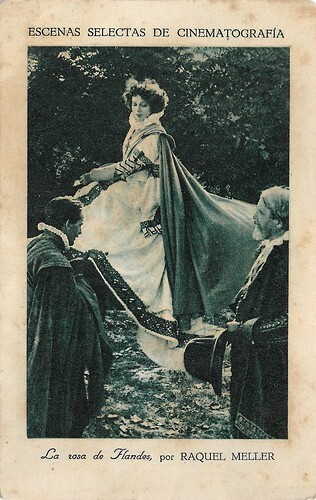
Spanish minicard in the Escenas selectas de cinematografía series, series A, no. 1. Raquel Meller and André Roanne in Les Opprimés/Flanders under Philip II (Henry Roussel, 1923), released in Spain as La Rosa de Flandes. It was the first film shot at Hippolyte Kempeneer's Mechelen studios in Belgium.
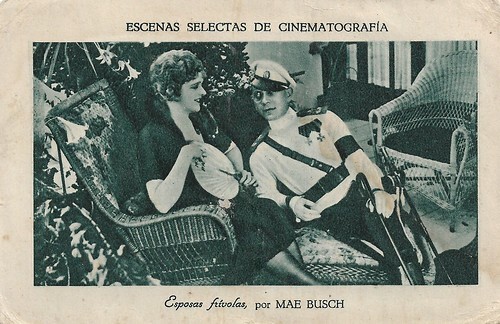
Spanish minicard in the Escenas selectas de cinematografía series, series A, no. 2, for Chocolate Guillèn. Erich von Stroheim in Foolish Wives (Von Stroheim, 1922). The lady depicted is not Mae Busch but Miss Dupont.
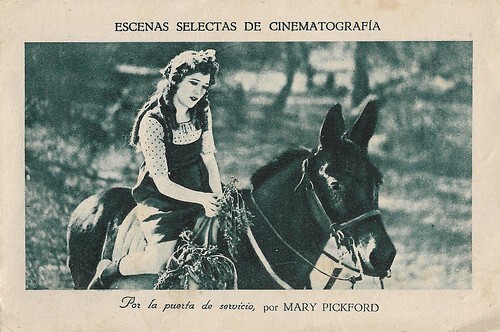
Spanish minicard in the Escenas selectas de cinematografía series, series A, no. 4. Mary Pickford in Through the Back Door (Alfred E. Green, Jack Pickford, 1921). The Spanish title is Por la puerta de servicio.
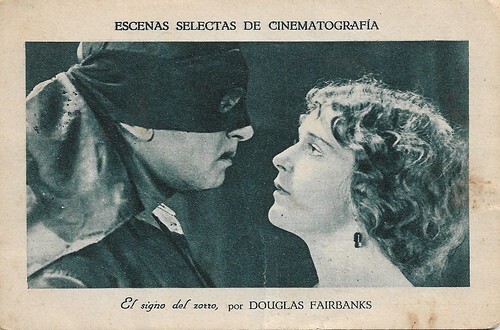
Spanish minicard in the Escenas selectas de cinematografía series, series A, no. 5, for Chocolates Guillèn, Barcelona. Douglas Fairbanks in The Mark of Zorro (Fred Niblo, 1920). The woman is probably Marguerite de la Motte and the Spanish title was El signo del zorro.
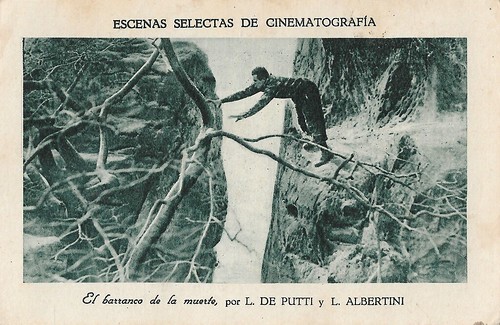
Spanish collectors card in the Escenas selectas de cinematografia series, series A, no. 6. Luciano Albertini, and Lya De Putti in Die Schlucht des Todes/The Ravine of Death (Luciano Albertini, Francis A. Bertoni, 1923). The Spanish release title of the film is El barranco de la muerte.
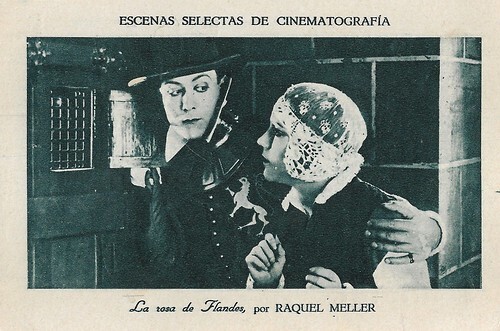
Spanish minicard in the Escenas selectas de cinematografía series, series A, no. 7. Raquel Meller and André Roanne in Les Opprimés/Flanders under Philip II (Henry Roussel, 1923), released in Spain as 'La Rosa de Flandes'.
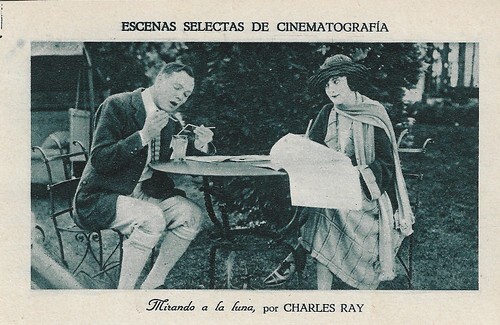
Spanish collectors card in the Escenas selectas de cinematografia series, series A, no. 8. Charles Ray and Viola Dana (?) in Mirando la luna (Looking at the moon). It's unknown which American film this is. It was shown in Madrid, Spain in November-December 1925.
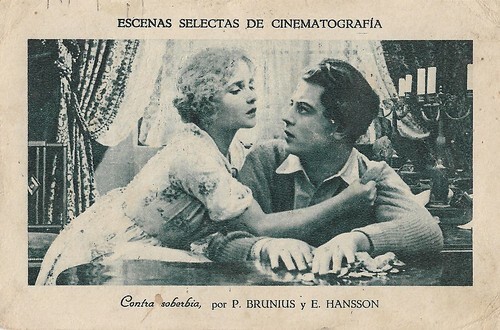
Spanish collectors card in the Escenas selectas de cinematografia series, series A, no. 9. Einar Hanson and Mary Johnson in Gunnar Hedes saga/Snowbound (Mauritz Stiller, 1923). The Spanish title of the film is 'Contra soberbia' (Against Pride). NB As on the card above, Hanson's name is misspelled as Hansson and although Pauline Brunius plays Hede's mother in the film, she is not the woman on the card.
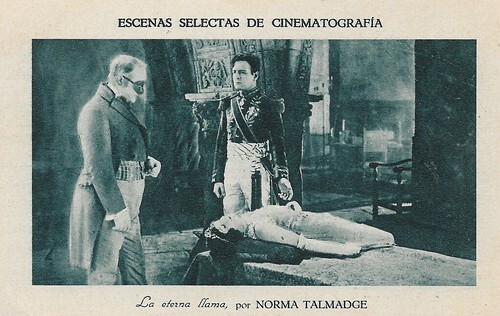
Spanish collectors card in the Escenas selectas de cinematografia series, series A, no. 10. Norma Talmadge and Conway Tearle in The Eternal Flame (Frank Lloyd, 1922). The Spanish title of the film is El eterna llama.
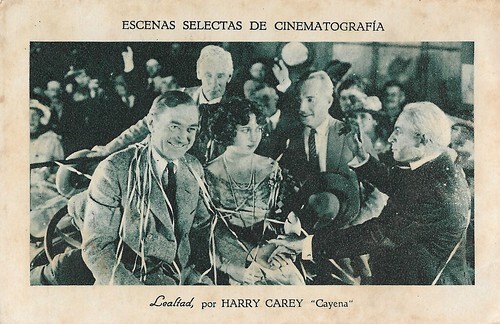
Spanish collectors card in the Escenas selectas de cinematografia series, series A, no. 12. Harry Carey in Lealtad (Loyalty). Cayena may be a misspelling of Carey's regular character Cheyenne Harry.
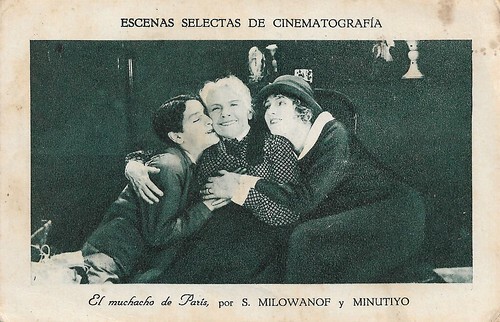
Spanish collectors card in the Escenas selectas de cinematografia series, series A, no. 13. Sandra Milovanoff , Berthe Jalabert and René Poyen in Le Gamin de Paris/Paris Urchin (Louis Feuillade, 1923). The Spanish release title of the film is El muchacho de Paris. Poyen's comic character Bout-de-Zan at Gaumont - some ten years before this film - was called Minutiyo in Spain.

Spanish minicard in the Escenas selectas de cinematografía series, series A, no. 14. Richard Talmadge in The Cub Reporter (John Francis Dillon, 1922), presented in Spain as Ricardito reporter.
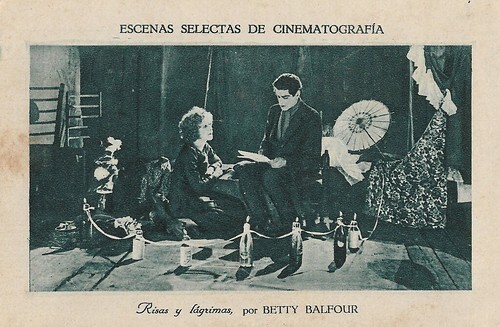
Spanish minicard in the Escenas selectas de cinematografía series, series A, no. 15. Betty Balfour as Tip-Toes and Harry Jonas as the Boy in Love, Life and Laughter (George Pearson, 1923), released in Spain as Risas y lagrimas (Laughter and Tears). Long presumed lost, Love, Life and Laughter (George Pearson, 1923) was found in the Netherlands in 2014 by the Eye Filmmuseum. A copy of the British production was found in the inventory of bioscoop/theater De Vries (cinema/theatre De Vries), a former cinema in Hattem, the Netherlands. The film was listed as one of the British Film Institute's '75 Most Wanted' lost films. Eye restored the film. Plot: Tip-Toes (Balfour) is a chorus girl in a garret. She befriends a lonely young boy who dreams of being a writer, while she dreams of being a music-hall star. They agree to meet at midnight in two years' time in their slum tenement to see which of their dreams has come true.
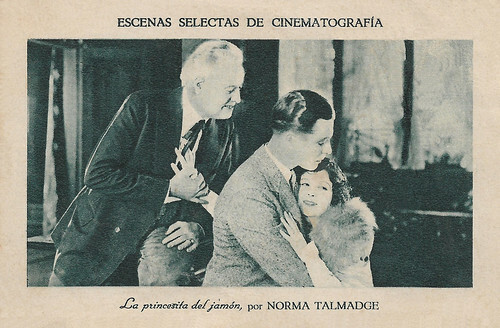
Spanish minicard in the Escenas selectas de cinematografía series, series A, no. 16. Photo: Norma Talmadge Film. Norma Talmadge , Harrison Ford, and Howard Truesdale in The Wonderful Thing (Herbert Brenon, 1921), presented in Spain as 'La princesita del jamón' (The Ham Princess).
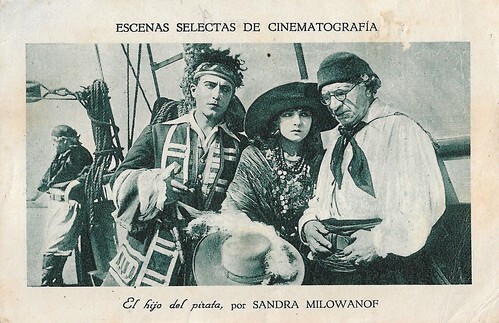
Spanish collectors card in the Escenas selectas de cinematografia series, series A, no. 17. Aimé Simon-Girard , Sandra Milovanoff , and Bernard Derigal in Le fils du filibustier/The buccaneer's son (Louis Feuillade, 1922). The Spanish title of the film is 'El hijo del pirata'.
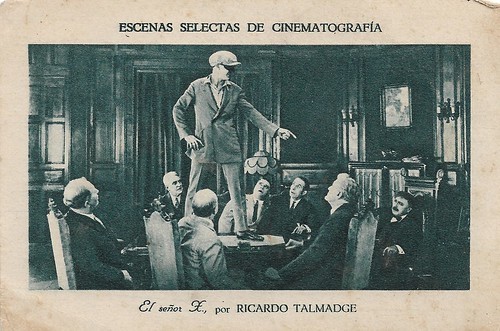
Spanish collectors card in the Escenas selectas de cinematografia series, Serie A, no. 20. Richard Talmadge in El senor X, probably The Mysterious Stranger (Jack Nelson, 1925).
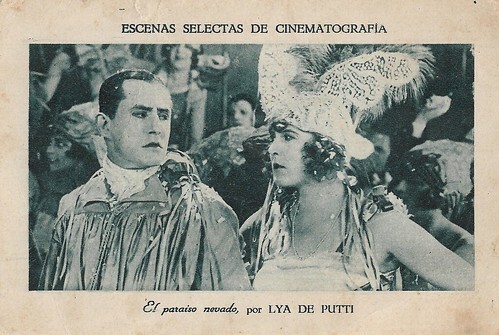
Spanish collectors card in the Escenas selectas de cinematografia series, series A, no. 21. Although the card indicates that this is Lya De Putti in El paraiso nevado (The Snowy Paradise), we have our doubts. The film was shown in Spain in 1924, but we haven't identified yet its original, probably German title. Marlene Pilaete: "I was puzzled by the “El paraiso nevado” Spanish card on Flickr. I think that the lady on the card doesn’t look like Lya De Putti. Maybe that card has nothing to do with her and is rather related to the 1923 German movie “Das Paradies im Schnee”, directed by Georg Jacoby. The title matches with “El paraiso nevado”. According to the synopsis I found on Wikipedia, there is a carnival scene in it, which may explain the funny costumes worn by the two characters and the presence of what seems to be confetti and streamers. The man could be Bruno Kastner and the lady could be either Lona Schmidt or Elga Brink." We think Marlene is right.
Series B

Spanish collectors card in the Escenas selectas de cinematografia series, series B, no. 1. Norma Talmadge and Conway Tearle in The Eternal Flame (Frank Lloyd, 1922). The Spanish title of the film is El eterna llama.
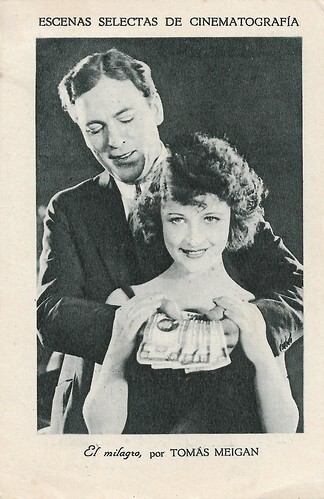
Spanish minicard in the Escenas selectas de cinematografía series, series B, no. 2, for Juan Garcia, Chocolates Gavilan, Alicante. Thomas Meighan in The Miracle Man (George Loan Tucker, 1919). The woman could be Betty Compson and the Spanish title is El milagro.
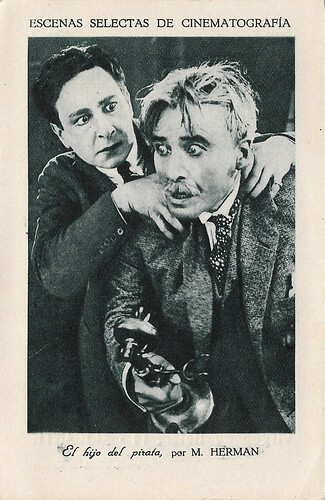
Spanish minicard in the Escenas selectas de cinematografía series, series B, no. 3, for Juan Garcia, Chocolates Gavilan, Alicante. Fernand Herrmann and Bernard Derigal in Le fils du flibustier/The buccaneer's son (Louis Feuillade, 1922). The Spanish title is El hijo del pirata.
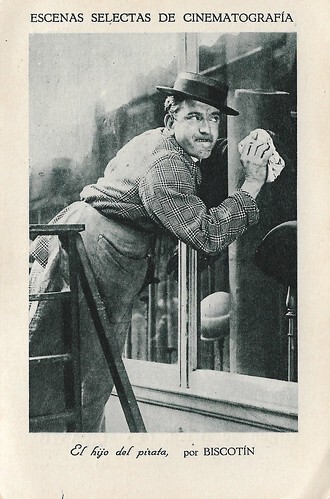
Spanish minicard in the Escenas selectas de cinematografía series, series B, no. 4, for Juan Garcia, Chocolates Gavilan, Alicante. Georges Biscot in Le fils du flibustier/The buccaneer's son (Louis Feuillade, 1922). The Spanish title is El hijo del pirata.
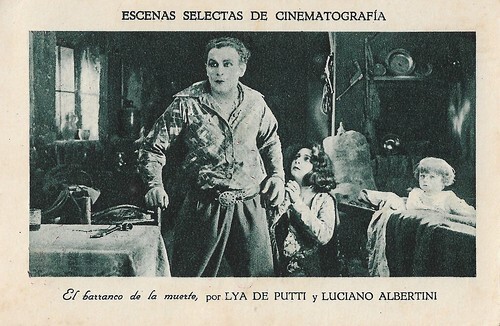
Spanish collectors card in the Escenas selectas de cinematografia series, series B, no. 5. Luciano Albertini and Lya De Putti in Die Schlucht des Todes/The Ravine of Death (Luciano Albertini, Francis A. Bertoni, 1923). The Spanish release title of the film is El barranco de la muerte.
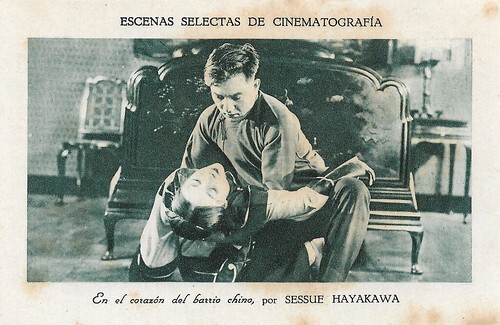
Spanish collectors card in the Escenas selectas de cinematografia series, series B, no. 6. Sessue Hayakawa , in En el corazon del barrio chino (In the heart of Chinatown). It probably refers to The Swamp (Colin Campbell, 1921), in which Hayakawa wears the same costume and hairdo.
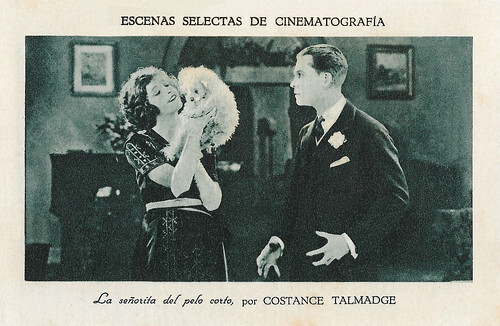
Spanish collectors card in the Escenas selectas de cinematografia series, series B, no. 7. Photo: Constance Talmadge Film. Constance Talmadge and Harrison Ford in Wedding Bells (Chester Withey, 1921), released in Spain as La senorita del pelo corto.
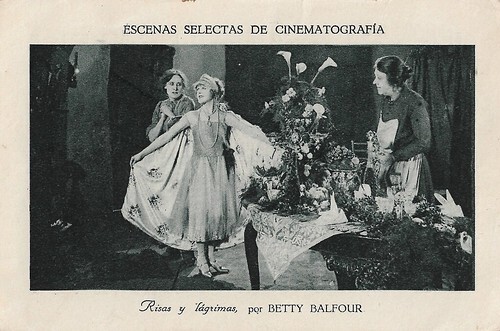
Spanish collectors card in the Escenas selectas de cinematografia series, series B, no. 8. Betty Balfour in Love, Life and Laughter (George Pearson, 1923), released in Spain as Risas y lagrimas (Laughter and Tears).
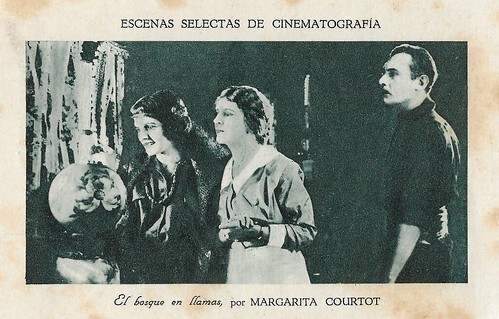
Spanish collectors card in the Escenas selectas de cinematografia series, series B, no. 9. Marguerite Courtot and Lew Cody in Jacqueline, or Blazing Barriers (Dell Henderson, 1923). The Spanish title of the film is El bosque en llamas (The forest in flames).
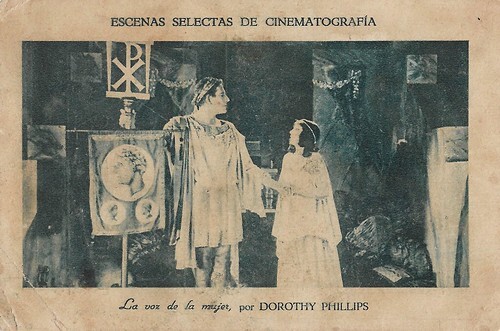
Spanish collectors card in the Escenas selectas de cinematografia series, series B, no. 10. Dorothy Philips in Man-Woman-Marriage (Alan Holubar, 1921). The Spanish title of the film is La voz de la mujer (The voice of women).
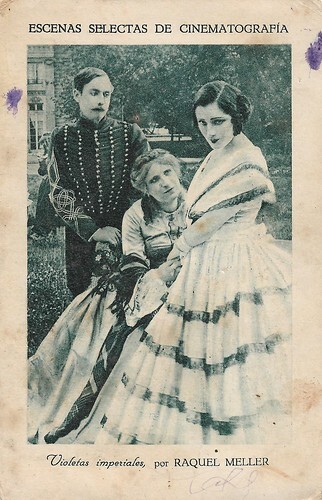
Spanish minicard in the Escenas selectas de cinematografía series, series B, no. 11, for Chocolates Guillèn, Barcelona. Raquel Meller in Violettes impériales/Imperial violets (Henry Roussel, 1924). To the right of her, André Roanne . Spanish title is Violetas imperiales.
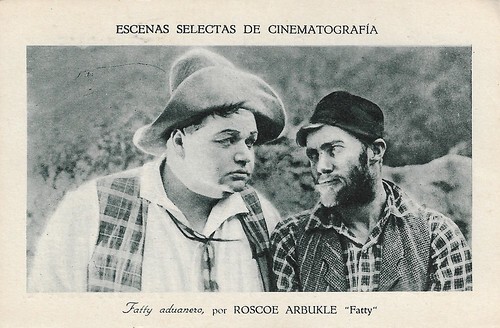
Spanish minicard in the Escenas selectas de cinematografía series, series B, no. 12, for Juan Garcia, Chocolates Gavilan, Alicante. Roscoe Arbuckle in Moonshine (Roscoe 'Fatty' Arbuckle, 1918). To the right of him, Al St. John as The Mountain Man. The Spanish title is Fatty aduanero. With thanks to Steve Massa for the identification.
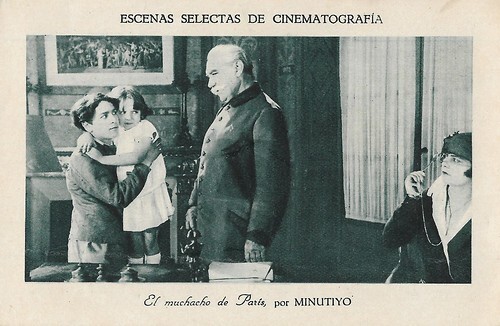
Spanish minicard in the Escenas selectas de cinematografía series, series B, no. 13, for Juan Garcia, Chocolates Gavilan, Alicante. René Poyen (Bout de Zan) as war orphan Joseph (left) in Le gamin de Paris/Paris urchin (Louis Feuillade, 1923). The little girl in Poyen's arms was Bouboule as Gaby, the general was played by Adolphe Candé, and the lady at right, Madame de Mersange, by Renée van Delly. Spanish title is El muchacho de Paris. As a child star, René Poyen was known in France as Bout de Zan and in Spain as Minutiyo.
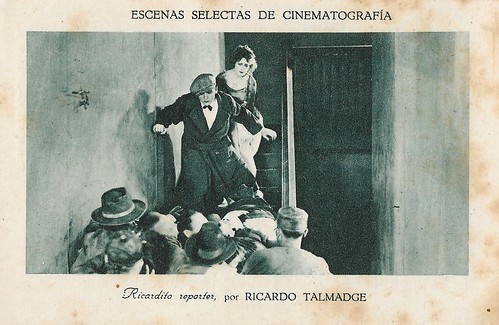
Spanish minicard in the Escenas selectas de cinematografía series, series B, no. 14. Richard Talmadge in The Cub Reporter (John Francis Dillon, 1922), presented in Spain as Ricardito reporter.
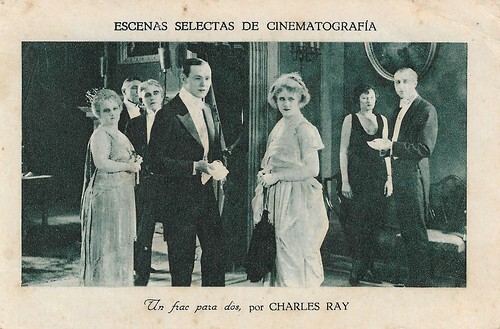
Spanish collectors card in the Escenas selectas de cinematografia series, series B, no. 15. Charles Ray in A Tailor-Made Man (Joseph De Grasse, 1922). This comedy was released in Spain in 1923 as Un frac para dos.
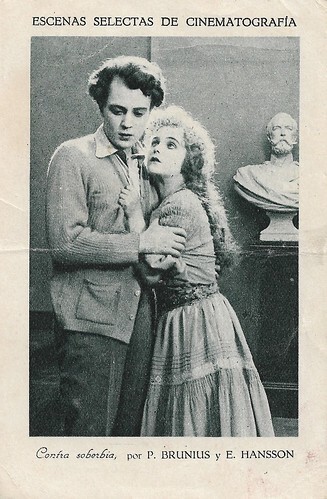
Spanish collectors card in the Escenas selectas de cinematografia series, series B, no. 17. Einar Hanson and Mary Johnson in Gunnar Hedes saga/Snowbound (Mauritz Stiller, 1923). The Spanish title of the film is Contra soberbia (Against Pride). Hanson's name is misspelled on the card as Hansson and although Pauline Brunius plays in this film Hede's mother, she is not the woman on this card.
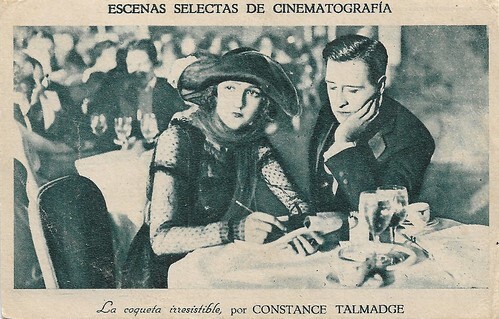
Spanish minicard in the Escenas selectas de cinematografia series by Chocolates Piera y Brugueras, Tarrasa (Barcelona), series B, no. 19. Constance Talmadge and Conway Tearle in A Virtuous Vamp (David Kirkland, 1919). The Spanish title is La coqueta irresistibile. With thanks to Erhanizzet Oncel for the identification.
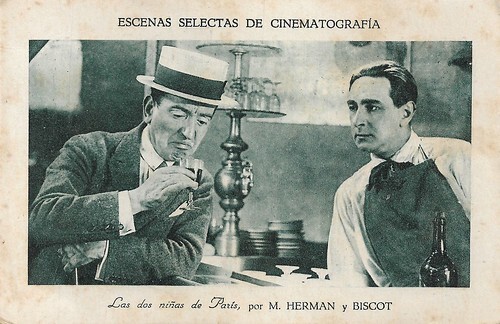
Spanish collectors card in the Escenas selectas de cinematografía series, series B, no. 20. Photo: Gaumont. Georges Biscot and Fernand Herrmann in Les deux gamines/The two kids (Louis Feuillade, 1921), presented in Spain as Las dos niñas de París.
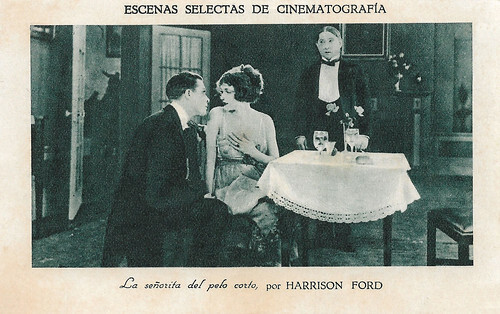
Spanish collectors card by Escenas selectas de cinematografia, series B, no. 21. Photo: Constance Talmadge Film. Harrison Ford and Constance Talmadge in Wedding Bells (Chester Withey, 1921), released in Spain as La senorita del pelo corto.
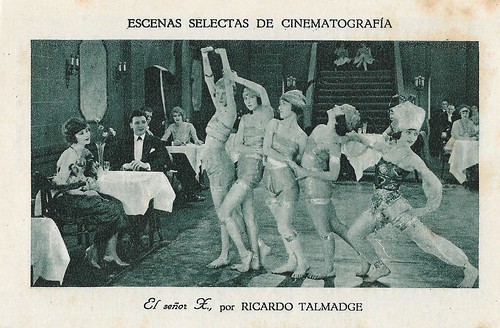
Spanish collectors card in the Escenas selectas de cinematografia series, serie B, no. ?. Richard Talmadge in El senor X, probably The Mysterious Stranger (Jack Nelson, 1925).
Sources: IMDb and Marlene Pilaete.
Series A

Spanish minicard in the Escenas selectas de cinematografía series, series A, no. 1. Raquel Meller and André Roanne in Les Opprimés/Flanders under Philip II (Henry Roussel, 1923), released in Spain as La Rosa de Flandes. It was the first film shot at Hippolyte Kempeneer's Mechelen studios in Belgium.

Spanish minicard in the Escenas selectas de cinematografía series, series A, no. 2, for Chocolate Guillèn. Erich von Stroheim in Foolish Wives (Von Stroheim, 1922). The lady depicted is not Mae Busch but Miss Dupont.

Spanish minicard in the Escenas selectas de cinematografía series, series A, no. 4. Mary Pickford in Through the Back Door (Alfred E. Green, Jack Pickford, 1921). The Spanish title is Por la puerta de servicio.

Spanish minicard in the Escenas selectas de cinematografía series, series A, no. 5, for Chocolates Guillèn, Barcelona. Douglas Fairbanks in The Mark of Zorro (Fred Niblo, 1920). The woman is probably Marguerite de la Motte and the Spanish title was El signo del zorro.

Spanish collectors card in the Escenas selectas de cinematografia series, series A, no. 6. Luciano Albertini, and Lya De Putti in Die Schlucht des Todes/The Ravine of Death (Luciano Albertini, Francis A. Bertoni, 1923). The Spanish release title of the film is El barranco de la muerte.

Spanish minicard in the Escenas selectas de cinematografía series, series A, no. 7. Raquel Meller and André Roanne in Les Opprimés/Flanders under Philip II (Henry Roussel, 1923), released in Spain as 'La Rosa de Flandes'.

Spanish collectors card in the Escenas selectas de cinematografia series, series A, no. 8. Charles Ray and Viola Dana (?) in Mirando la luna (Looking at the moon). It's unknown which American film this is. It was shown in Madrid, Spain in November-December 1925.

Spanish collectors card in the Escenas selectas de cinematografia series, series A, no. 9. Einar Hanson and Mary Johnson in Gunnar Hedes saga/Snowbound (Mauritz Stiller, 1923). The Spanish title of the film is 'Contra soberbia' (Against Pride). NB As on the card above, Hanson's name is misspelled as Hansson and although Pauline Brunius plays Hede's mother in the film, she is not the woman on the card.

Spanish collectors card in the Escenas selectas de cinematografia series, series A, no. 10. Norma Talmadge and Conway Tearle in The Eternal Flame (Frank Lloyd, 1922). The Spanish title of the film is El eterna llama.

Spanish collectors card in the Escenas selectas de cinematografia series, series A, no. 12. Harry Carey in Lealtad (Loyalty). Cayena may be a misspelling of Carey's regular character Cheyenne Harry.

Spanish collectors card in the Escenas selectas de cinematografia series, series A, no. 13. Sandra Milovanoff , Berthe Jalabert and René Poyen in Le Gamin de Paris/Paris Urchin (Louis Feuillade, 1923). The Spanish release title of the film is El muchacho de Paris. Poyen's comic character Bout-de-Zan at Gaumont - some ten years before this film - was called Minutiyo in Spain.

Spanish minicard in the Escenas selectas de cinematografía series, series A, no. 14. Richard Talmadge in The Cub Reporter (John Francis Dillon, 1922), presented in Spain as Ricardito reporter.

Spanish minicard in the Escenas selectas de cinematografía series, series A, no. 15. Betty Balfour as Tip-Toes and Harry Jonas as the Boy in Love, Life and Laughter (George Pearson, 1923), released in Spain as Risas y lagrimas (Laughter and Tears). Long presumed lost, Love, Life and Laughter (George Pearson, 1923) was found in the Netherlands in 2014 by the Eye Filmmuseum. A copy of the British production was found in the inventory of bioscoop/theater De Vries (cinema/theatre De Vries), a former cinema in Hattem, the Netherlands. The film was listed as one of the British Film Institute's '75 Most Wanted' lost films. Eye restored the film. Plot: Tip-Toes (Balfour) is a chorus girl in a garret. She befriends a lonely young boy who dreams of being a writer, while she dreams of being a music-hall star. They agree to meet at midnight in two years' time in their slum tenement to see which of their dreams has come true.

Spanish minicard in the Escenas selectas de cinematografía series, series A, no. 16. Photo: Norma Talmadge Film. Norma Talmadge , Harrison Ford, and Howard Truesdale in The Wonderful Thing (Herbert Brenon, 1921), presented in Spain as 'La princesita del jamón' (The Ham Princess).

Spanish collectors card in the Escenas selectas de cinematografia series, series A, no. 17. Aimé Simon-Girard , Sandra Milovanoff , and Bernard Derigal in Le fils du filibustier/The buccaneer's son (Louis Feuillade, 1922). The Spanish title of the film is 'El hijo del pirata'.

Spanish collectors card in the Escenas selectas de cinematografia series, Serie A, no. 20. Richard Talmadge in El senor X, probably The Mysterious Stranger (Jack Nelson, 1925).

Spanish collectors card in the Escenas selectas de cinematografia series, series A, no. 21. Although the card indicates that this is Lya De Putti in El paraiso nevado (The Snowy Paradise), we have our doubts. The film was shown in Spain in 1924, but we haven't identified yet its original, probably German title. Marlene Pilaete: "I was puzzled by the “El paraiso nevado” Spanish card on Flickr. I think that the lady on the card doesn’t look like Lya De Putti. Maybe that card has nothing to do with her and is rather related to the 1923 German movie “Das Paradies im Schnee”, directed by Georg Jacoby. The title matches with “El paraiso nevado”. According to the synopsis I found on Wikipedia, there is a carnival scene in it, which may explain the funny costumes worn by the two characters and the presence of what seems to be confetti and streamers. The man could be Bruno Kastner and the lady could be either Lona Schmidt or Elga Brink." We think Marlene is right.
Series B

Spanish collectors card in the Escenas selectas de cinematografia series, series B, no. 1. Norma Talmadge and Conway Tearle in The Eternal Flame (Frank Lloyd, 1922). The Spanish title of the film is El eterna llama.

Spanish minicard in the Escenas selectas de cinematografía series, series B, no. 2, for Juan Garcia, Chocolates Gavilan, Alicante. Thomas Meighan in The Miracle Man (George Loan Tucker, 1919). The woman could be Betty Compson and the Spanish title is El milagro.

Spanish minicard in the Escenas selectas de cinematografía series, series B, no. 3, for Juan Garcia, Chocolates Gavilan, Alicante. Fernand Herrmann and Bernard Derigal in Le fils du flibustier/The buccaneer's son (Louis Feuillade, 1922). The Spanish title is El hijo del pirata.

Spanish minicard in the Escenas selectas de cinematografía series, series B, no. 4, for Juan Garcia, Chocolates Gavilan, Alicante. Georges Biscot in Le fils du flibustier/The buccaneer's son (Louis Feuillade, 1922). The Spanish title is El hijo del pirata.

Spanish collectors card in the Escenas selectas de cinematografia series, series B, no. 5. Luciano Albertini and Lya De Putti in Die Schlucht des Todes/The Ravine of Death (Luciano Albertini, Francis A. Bertoni, 1923). The Spanish release title of the film is El barranco de la muerte.

Spanish collectors card in the Escenas selectas de cinematografia series, series B, no. 6. Sessue Hayakawa , in En el corazon del barrio chino (In the heart of Chinatown). It probably refers to The Swamp (Colin Campbell, 1921), in which Hayakawa wears the same costume and hairdo.

Spanish collectors card in the Escenas selectas de cinematografia series, series B, no. 7. Photo: Constance Talmadge Film. Constance Talmadge and Harrison Ford in Wedding Bells (Chester Withey, 1921), released in Spain as La senorita del pelo corto.

Spanish collectors card in the Escenas selectas de cinematografia series, series B, no. 8. Betty Balfour in Love, Life and Laughter (George Pearson, 1923), released in Spain as Risas y lagrimas (Laughter and Tears).

Spanish collectors card in the Escenas selectas de cinematografia series, series B, no. 9. Marguerite Courtot and Lew Cody in Jacqueline, or Blazing Barriers (Dell Henderson, 1923). The Spanish title of the film is El bosque en llamas (The forest in flames).

Spanish collectors card in the Escenas selectas de cinematografia series, series B, no. 10. Dorothy Philips in Man-Woman-Marriage (Alan Holubar, 1921). The Spanish title of the film is La voz de la mujer (The voice of women).

Spanish minicard in the Escenas selectas de cinematografía series, series B, no. 11, for Chocolates Guillèn, Barcelona. Raquel Meller in Violettes impériales/Imperial violets (Henry Roussel, 1924). To the right of her, André Roanne . Spanish title is Violetas imperiales.

Spanish minicard in the Escenas selectas de cinematografía series, series B, no. 12, for Juan Garcia, Chocolates Gavilan, Alicante. Roscoe Arbuckle in Moonshine (Roscoe 'Fatty' Arbuckle, 1918). To the right of him, Al St. John as The Mountain Man. The Spanish title is Fatty aduanero. With thanks to Steve Massa for the identification.

Spanish minicard in the Escenas selectas de cinematografía series, series B, no. 13, for Juan Garcia, Chocolates Gavilan, Alicante. René Poyen (Bout de Zan) as war orphan Joseph (left) in Le gamin de Paris/Paris urchin (Louis Feuillade, 1923). The little girl in Poyen's arms was Bouboule as Gaby, the general was played by Adolphe Candé, and the lady at right, Madame de Mersange, by Renée van Delly. Spanish title is El muchacho de Paris. As a child star, René Poyen was known in France as Bout de Zan and in Spain as Minutiyo.

Spanish minicard in the Escenas selectas de cinematografía series, series B, no. 14. Richard Talmadge in The Cub Reporter (John Francis Dillon, 1922), presented in Spain as Ricardito reporter.

Spanish collectors card in the Escenas selectas de cinematografia series, series B, no. 15. Charles Ray in A Tailor-Made Man (Joseph De Grasse, 1922). This comedy was released in Spain in 1923 as Un frac para dos.

Spanish collectors card in the Escenas selectas de cinematografia series, series B, no. 17. Einar Hanson and Mary Johnson in Gunnar Hedes saga/Snowbound (Mauritz Stiller, 1923). The Spanish title of the film is Contra soberbia (Against Pride). Hanson's name is misspelled on the card as Hansson and although Pauline Brunius plays in this film Hede's mother, she is not the woman on this card.

Spanish minicard in the Escenas selectas de cinematografia series by Chocolates Piera y Brugueras, Tarrasa (Barcelona), series B, no. 19. Constance Talmadge and Conway Tearle in A Virtuous Vamp (David Kirkland, 1919). The Spanish title is La coqueta irresistibile. With thanks to Erhanizzet Oncel for the identification.

Spanish collectors card in the Escenas selectas de cinematografía series, series B, no. 20. Photo: Gaumont. Georges Biscot and Fernand Herrmann in Les deux gamines/The two kids (Louis Feuillade, 1921), presented in Spain as Las dos niñas de París.

Spanish collectors card by Escenas selectas de cinematografia, series B, no. 21. Photo: Constance Talmadge Film. Harrison Ford and Constance Talmadge in Wedding Bells (Chester Withey, 1921), released in Spain as La senorita del pelo corto.

Spanish collectors card in the Escenas selectas de cinematografia series, serie B, no. ?. Richard Talmadge in El senor X, probably The Mysterious Stranger (Jack Nelson, 1925).
Sources: IMDb and Marlene Pilaete.
Published on March 26, 2022 22:00
March 25, 2022
The Sheik and sons
The American silent film The Sheik (George Melford, 1921) caused a sensation and made Rudolph Valentino a sex symbol. It nearly singlehandedly founded the genre of 'oriental romance' Hollywood films. The Sheik is about Lady Diana Mayo (Agnes Eyres) a free-spirited English woman who is kidnapped in the North African town of Biskra by Sheik Ahmed Ben Hassan with whom she eventually falls in love. In the original 1919 novel by Edith Maude Hull, Diana falls in love with the sheik precisely because he rapes her. In the film, however, this rape is only hinted at. Although set in Algeria, the film was shot entirely in the United States. In 1926, also starring Valentino, an even more popular sequel was made under the title The Son of the Sheik (George Fitzmaurice, 1926). The Sheik craze led to several imitations and parodies.
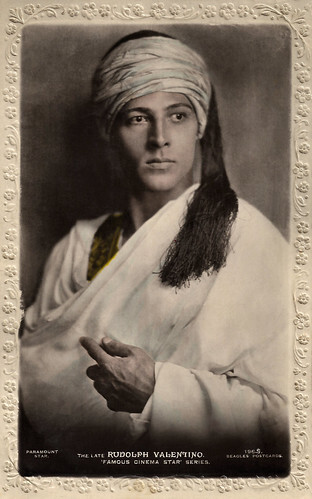
British postcard in the Famous Cinema Star Series by Beagles, no. 196.S. Photo: Paramount. Rudolph Valentino in The Sheik (George Fitzmaurice, 1921). Valentino wore the same costume in The Son of the Sheik, so we doubted for which of the two films this still was taken. However, Paramount was the producer of The Sheik.
Rudolph Valentino (1895-1926) was Hollywood's ultimate 'Latin Lover'. The Italian-born American actor starred in several well-known silent films including The Four Horsemen of the Apocalypse (1921), The Sheik (1922), Blood and Sand (1922), The Eagle (1925), and The Son of the Sheik (1926). His early death at age 31 caused mass hysteria among his female fans and propelled him into iconic status.
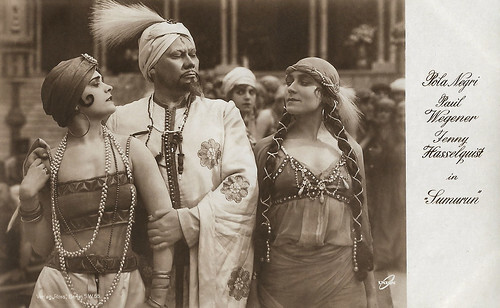
German postcard by Ross Verlag, Berlin. Photo: Union Film. Publicity still for Sumurun (Ernst Lubitsch, 1920) with Pola Negri , Paul Wegener and Jenny Hasselqvist .
Ernst Lubitsch's silent film Sumurun (1920) tells the story of the favourite slave girl (Hasselquist) of a tyrannical sheik (Wegener), who falls in love with a cloth merchant (Harry Liedtke). Meanwhile, a hunchback clown (Lubitsch himself) suffers unrequited love for a traveling dancer (Negri) who wants to join the harem.
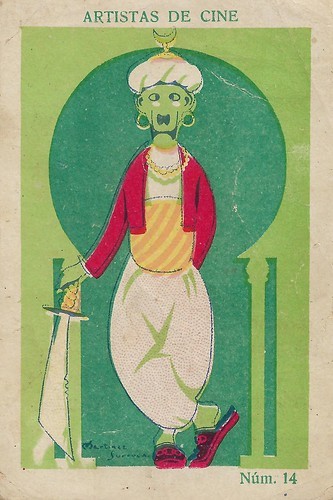
Spanish collectors card by Chocolates Amatller, Barcelona, in the 'Artistas de cine' series, no. 14: Ben Turpin. Image: Martinez Surroca. Ben Turpin played a sheik in The Shriek of Araby (F. Richard Jones, 1923).
Cross-eyed silent comedian Ben Turpin (1869-1940) was not born that way. Supposedly his right eye slipped out of alignment while playing the role of the similarly afflicted Happy Hooligan in vaudeville and it never adjusted. Ironically, it was this disability that would enhance his comic value and make him a top name in the silent film era. Turpin's true forte was impersonating the most dashingly romantic and sophisticated stars of the day and turning them into clumsy oafs. He also invented a Hollywood tradition by being the first actor to receive a pie in his face.
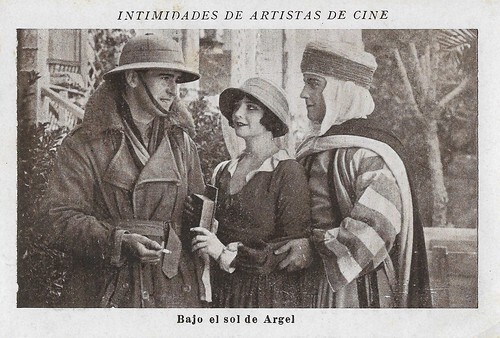
Spanish minicard in the Series 'Intimidades de artistas de cine'. Caption: Under the Algerian sun. Director Rex Ingram , his wife, and female lead Alice Terry , and male star Ramon Novarro during the shooting of The Arab (1924). Ingram was keen on realism, so he shot portions of the film on location in Algiers and hired real Bedouins as extras.
Mexican-American actor Ramon Novarro (1899-1968) was a popular Latin Lover of the 1920s and early 1930s. In the 1920s he made several films under the direction of Ingram, including The Prisoner of Zenda (1922) and Scaramouche (1923). Yet, his biggest claim of fame remains his lead in the mega-epic Ben-Hur (Fred Niblo, 1925).
Alice Terry (1900–1987) appeared in almost 40 films between 1916 and 1933. Though a brunette, Terry's trademark look was her blonde hair, for which she wore wigs from 1920 onwards. Her most acclaimed role is the leading lady in The Four Horsemen of the Apocalypse (Rex Ingram, 1921) starring Rudolph Valentino. Ingram, who married her in 1921, would shoot her in many of his films and often paired her to Novarro. Terry proved also in films without her husband’s direction she was a legitimate star. In 1923 the couple moved to the French Riviera, where they set up a small studio in Nice and made several films on location in North Africa, Spain, and Italy.
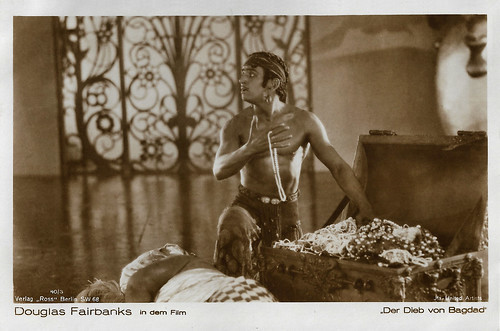
German postcard by Ross Verlag, Berlin, no. 40/3. Photo: IFA / United Artists. Douglas Fairbanks in The Thief of Bagdad (Raoul Walsh, 1924).
Douglas Fairbanks was the star of the magical adventure The Thief of Bagdad (1924), directed by Raoul Walsh. This Arabian Nights fantasy tells the story of a recalcitrant thief who falls in love with the beautiful daughter of the Caliph of Baghdad. The imaginative special effects, including a flying carpet, a magic rope, fearsome monsters, and the massive Arabian-style sets are still amazing. The Thief of Bagdad was a box-office failure in 1924, but now it is seen as one of the great silent Hollywood films and one of Fairbanks's greatest works.
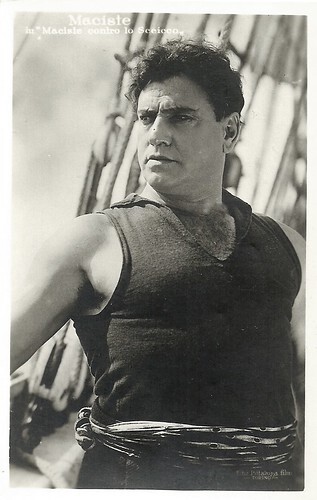
Italian postcard. Photo: Pittaluga Films, Torino (Turin). Bartolomeo Pagano as Maciste in the Italian silent film Maciste contro lo sceicco/Maciste Against the Sheik (Mario Camerini, 1926).
Bartolomeo Pagano (1878-1947) was an Italian actor in Italian and German silent films. His name is forever attached to the character of the strong man Maciste.
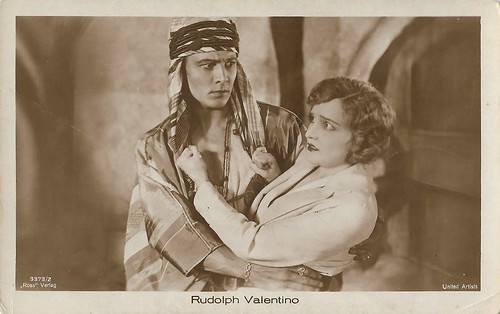
German postcard by Ross Verlag, no. 3373/2. Photo: United Artists. Agnes Ayres and Rudolph Valentino in The Son of the Sheik (George Fitzmaurice, 1926), retaking a scene from the original Paramount production The Sheik (George Melford, 1921).
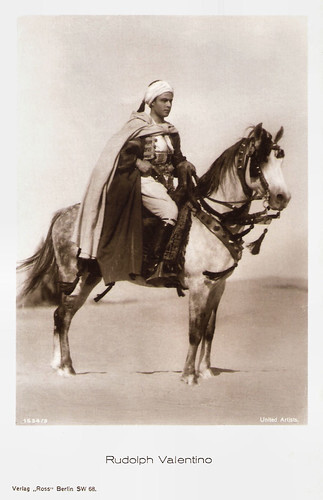
German postcard by Ross Verlag, no. 1534/3, 1927-1928. Photo: United Artists. Rudolph Valentino in The Son of the Sheik (George Fitzmaurice, 1926).
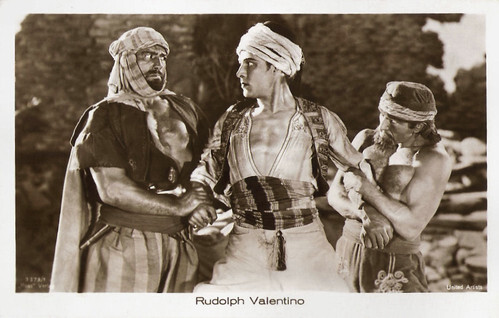
German postcard by Ross Verlag, no. 3373/1, 1928-1929. Photo: United Artists. Rudolph Valentino in The Son of the Sheik (George Fitzmaurice, 1926).
Full-blooded, romantic, silent melodrama at its very best
The Sheik (George Melford, 1920) was a major success with audiences and set new attendance records where it premiered. In its first week of release, it set attendance records at two of New York's major theaters, the Rialto and the Rivoli. The New York Telegraph estimated that in the first few weeks 125,000 people had seen the film. The film’s power over the public imagination relied on American fantasies of the Orient as a place of billowing sands, luxurious silks, and heated primal romance
Due to the film's success, Jesse Lasky declared the last week of November 1921 as "The Sheik Week", and screened the film at 250 theatres in the United States on 20 November 1921. The Sheik became so popular that the word came to be used to mean a young man on the prowl. The object of a Sheik's desire was dubbed "a Sheba". The film ran for six months in Sydney, Australia, as well as 42 weeks in one theatre in France. It was the first Valentino film to show in his native Italy.
Within the first year of its release, The Sheik exceeded $1 million in ticket sales while the film was made for under $200,000. The Sheik helped to solidify Valentino's image as one of the first male sex symbols of the cinema and made him an international star. While he was a popular draw with female audiences, some male audiences mocked his onscreen persona and questioned his masculinity.
The popular song 'The Sheik of Araby' was written in response to the film. The Sheik became widely copied over the years. Burning Sands (George Melford, 1922) with Milton Sills , The Tents of Allah (Charles Logue, 1923) with Monte Blue , A Son of the Sahara (Edwin Carewe, René Plaissetty, 1924), Rex Ingram 's The Arab (1924), which starred Ramón Novarro , and Felix the Cat Shatters the Sheik (Otto Messmer, 1926). The Shriek of Araby ( F. Richard Jones, 1923) starring Ben Turpin, the Baby Peggy short Peg o' the Movies (Alfred J. Goulding, 1923), and the Oswald the Lucky Rabbit cartoon The Shriek (William Nolan, 1933) were also parodies of The Sheik.
Rudolph Valentino would later attempt to portray roles that went against his 'Sheik' image with limited success. In 1925, he signed with United Artists. In an effort to capitalize on the success that Valentino had achieved with The Sheik, United Artists' president Joseph M. Schenck bought the rights to Edith Maude Hull's novel 'Son of the Sheik' and cast Valentino in the dual role of father and son.
Donna Hill in her essay 'The Son of the Sheik': "Valentino might have chafed a bit at reprising the role, but he recognised the necessity of doing it. Sequels were not yet common in 1926, but all signs pointed to the film being a sure-fire winner." The novel was adapted for the screen by Frances Marion and Fred de Gresac. Hill: "Set Design was handled by William Cameron Menzies, now famous for The Thief of Bagdad, who worked magic within budget confines, making a lush world out of little more than decorative fabrics and fake – albeit artistic – palm trees."
The Son of the Sheik (George Fitzmaurice, 1926) was shot on location in California and in the Yuma Desert in Arizona which substituted for the Sahara dunes. Hill: "Conditions there were little better than the actual Sahara: 110o heat during the day, barely cooling at night. The cast and crew camped in tents. The prop master, Irving Sindler, recorded in his diary that unlike co-stars Montagu Love and Vilma Banky , Valentino worked uncomplainingly in the brutal conditions. He actually seemed to be enjoying himself; home movie footage documents a pith helmeted Valentino racing around the sands on his horse, appearing to have a wonderful time."
At AllMovie , Hans J. Wollstein loves the result: "Son of the Sheik is full-blooded, romantic, silent melodrama at its very best and played with complete sincerity by everyone involved, with the exception of a couple of minor characters provided for comic relief. More than anything that would follow in the fast-approaching sound era, this desert romance relied thoroughly on sex appeal. Valentino's own, of course, bordered on mythical proportions, but Vilma Banky was awarded just as many loving close-ups and she photographed luminously. The culmination of all this cinematic lust remains Valentino, on his indigo horse, kidnapping dancing girl Banky, whom he mistakenly accuses of having betrayed him."
The Son of the Sheik went into general release nearly two weeks after his death from peritonitis at the age of 31. However, Valentino lived only long enough to witness the film’s success in Los Angeles and New York. He was promoting it when he fell ill and died at the age of 31, but lived long enough to know it was going to be a box office hit. The film grossed $1,000,000 within the first year of its release. Eventually, it more than doubled that. Donna Hill: "lines snaked down busy metropolitan streets attesting to the flappers and sheiks who yearned for a final glimpse of the Latin lover in what is arguably his best-remembered film."
Had Valentino lived, Son of the Sheik would undoubtedly have put him back on top. Years later, the film rights of The Sheik were bought by producer Edward Small who recreated segments of The Sheik in the biographical picture Valentino (Lewis Allen, 1951), starring Anthony Dexter as Valentino, who Small announced would star in a remake of The Sheik, but which was never made. Harum Scarum (1965), which starred Elvis Presley, was inspired by the film.
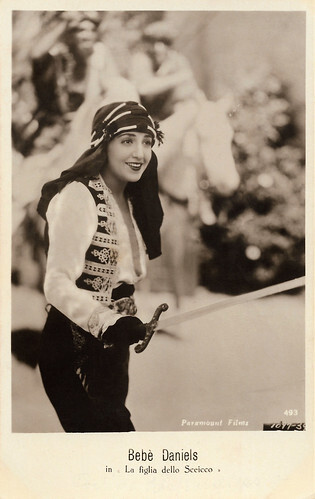
Italian postcard by G.B. Falci Editore, Milano, no. 493. Photo: Paramount Films. Bebe Daniels in She's a Sheik (Clarence G. Badger, 1927).
Bebe Daniels (1901-1971) was an American actress, singer, dancer, writer, and producer. She began her career in Hollywood during the silent film era as a child actress and later as the love interest of Harold Lloyd in dozens of short comedies. Cecil B. de Mille made her a silent star and later she sang and danced in early musicals like Rio Rita (1929) and 42nd Street (1933). In Great Britain, she gained further fame on stage, radio, and television. In her long career, Bebe Daniels appeared in 230 films.
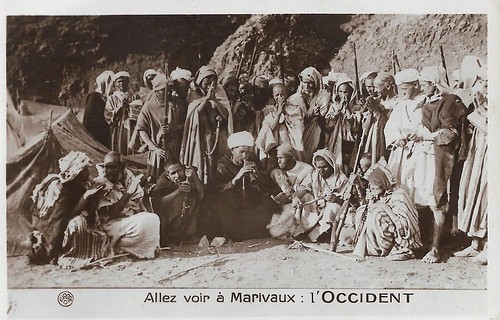
French postcard by Europe, no. 41. Publicity still for the French silent film L'Occident (Henri Fescourt, 1927, released 1928). The card makes publicity for the film's premiere screening at the Paris cinema Marivaux. Caption from La Petite Illustration, 398, 1928: "The hour of prayer of the tribe of Zerrath-Hama."
L'Occident/The West (1927) was based on the play by Henri Kistemaeckers (who also scripted the film), produced by Société des Cinéromans, and distributed by Pathé Consortium Cinéma. The leading actors were Lucien Dalsace, Claudia Victrix, and Jaque Catelain. The sets were by Robert Gys. The film premiered in France on 26 September 1928 at the Paris cinema Marivaux.
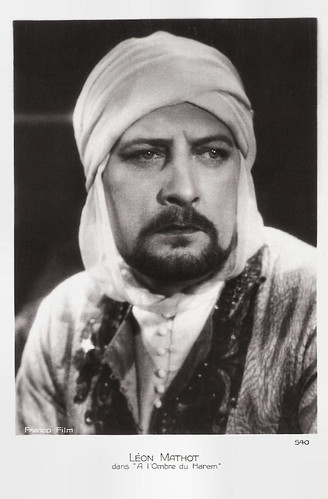
French postcard by Cinémagazine-Edition, no. 540. Photo: Franco Film. Léon Mathot in the French silent film Dans l'ombre du harem/In the Shadow of the Harem (Léon Mathot, André Liabel, 1928). The title on the postcard is slightly incorrect.
French actor and director Léon Mathot (1886-1968) became well-known for his role as Edmond Dantès in the French serial Le Comte de Monte-Cristo (Henri Pouctal, 1918). Mathot was one of the most popular stars of French silent film of the 1920s with such films as L'Empereur des pauvres (René Leprince, 1922) and Coeur fidèle (Jean Epstein, 1923). From 1927, he also became a film director, directing over 20 films.
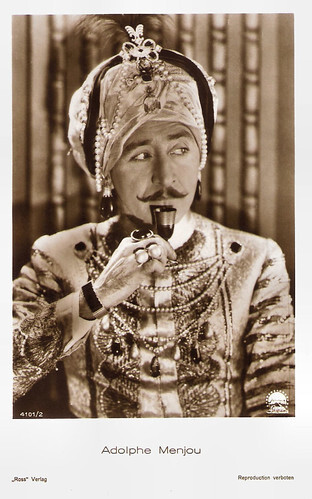
German postcard by Ross Verlag, no. 4101/2, 1929-1930. Photo: Paramount. Adolphe Menjou in His Tiger Wife (Hobart Henley, 1928).
Suave and debonair American actor Adolphe Menjou (1890-1963) with his trademark waxy black moustache was one of Hollywood's most distinguished stars and one of America's 'Best Dressed Men'. He started as a matinée idol in the silent cinema in such classics as The Sheik (George Melford, 1920), Ernst Lubitsch's The Marriage Circle (1924). His sound films included Morocco (1931) with Marlene Dietrich and Gary Cooper, A Star is Born (1937), and Stanley Kubrick's Paths of Glory (1957) with Kirk Douglas. In 1931, he was nominated for an Oscar for The Front Page (1931).
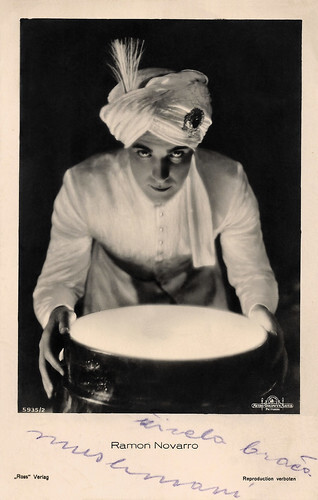
German postcard by Ross Verlag, no. 5935/2, 1930-1931. Photo: Metro-Goldwyn-Mayer (MGM). Ramon Novarro in A Night in Cairo/ The Barbarian (Sam Wood, 1933).
Mexican-American actor Ramon Novarro (1899-1968) was a popular Latin Lover of the 1920s and early 1930s.
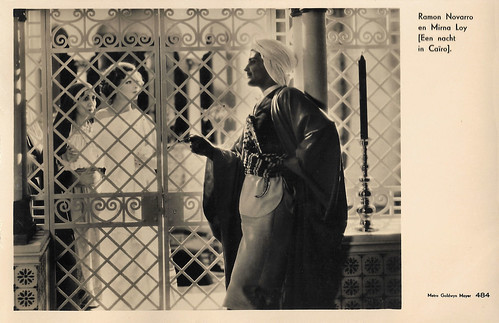
Dutch postcard, no. 484. Photo: Metro-Goldwyn-Mayer. Ramon Novarro and Myrna Loy in The Barbarian (Sam Wood, 1933).
Myrna Loy (1905-1993) was an American film, television, and stage actress. She was originally typecast in exotic roles, often as a vamp or a woman of Asian descent, but her career prospects improved greatly following her portrayal of Nora Charles in The Thin Man (W.S. Van Dyke, 1934). Suddenly she was 'Queen of the Movies' and remained so until the late 1940s.
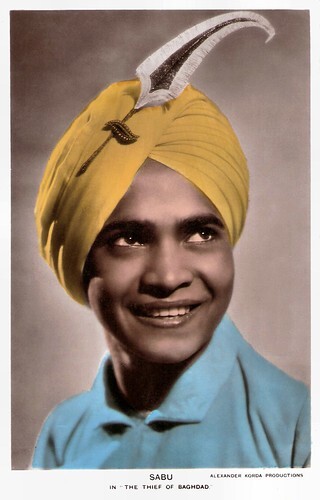
British postcard in the Colourgraph Series, London, no. C. 338. Photo: Alexander Korda Productions. Sabu in The Thief of Baghdad (Ludwig Berger, Michael Powell, Tim Whelan, 1940).
British Indian actor Sabu (1924-1963) had 'a smile as broad as the Ganges and charm enough to lure the stripes off a tiger'. He became an instant star with the release of the British film Elephant Boy in 1937. His succession of tropical Technicolor treats delighted audiences before and during WW II.
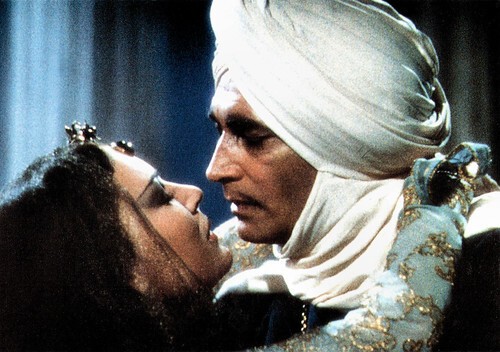
Italian programme card for Il Cinema Ritrovata 2011. Photo: June Deprez and Conrad Veidt in The Thief of Bagdad (Ludwig Berger, Michael Powell, Tim Whelan, Alexander Korda, Zoltan Korda, William Cameron Menzies, 1940).
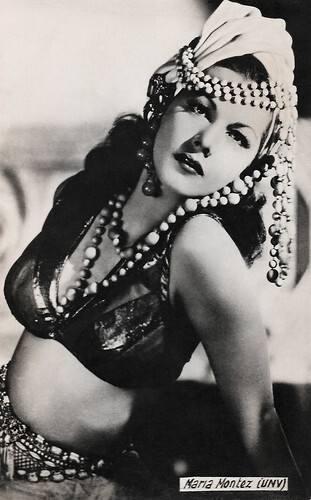
Spanish card, 1948. Photo: Universal. María Montez in Arabian Nights (John Rawlins, 1942).
Dominican film actress María Montez (1912-1951) gained fame and popularity as a tempestuous Latino beauty in Hollywood movies of the 1940s. In a series of exotic adventures filmed in Technicolor, she starred as Arabian princesses, jungle goddesses, and highborn gypsies, dressed in fanciful costumes and sparkling jewels. Over her career, ‘The Queen of Technicolor’ appeared in 26 films, of which five were made in Europe.
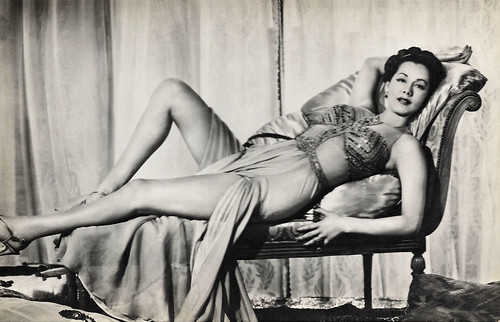
Spanish postcard by Archivo Bermejo, Barcelona. Photo: Universal. María Montez in Sudan (John Rawlins, 1945).
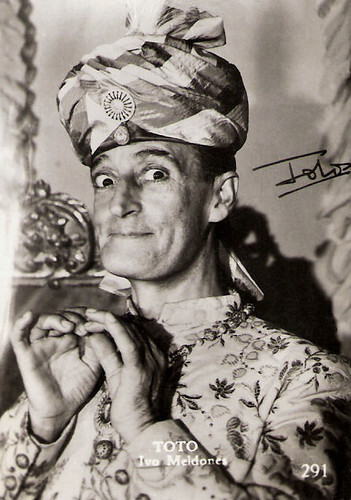
Small Italian collectors card, no. 291. Photo: Ivo Meldones. Totò in Totò sceicco/Toto the Sheik (Mario Mattoli, 1950).
Totò (1898–1967) was one of the most popular Italian film stars ever, nicknamed il principe della risata (the prince of laughter). He starred in about 100 films, many of which are still frequently broadcast on Italian television. Totò is an heir of the Commedia dell'Arte tradition and can be compared to Buster Keaton and Charlie Chaplin. His style and some of his recurring jokes and gestures are universally known in Italy.
Sources: Donna Hill (Library of Congress), Sophie Hammond (Inquiries), Hans J. Wollstein (AllMovie), Wikipedia (Dutch, German and English), and IMDb.

British postcard in the Famous Cinema Star Series by Beagles, no. 196.S. Photo: Paramount. Rudolph Valentino in The Sheik (George Fitzmaurice, 1921). Valentino wore the same costume in The Son of the Sheik, so we doubted for which of the two films this still was taken. However, Paramount was the producer of The Sheik.
Rudolph Valentino (1895-1926) was Hollywood's ultimate 'Latin Lover'. The Italian-born American actor starred in several well-known silent films including The Four Horsemen of the Apocalypse (1921), The Sheik (1922), Blood and Sand (1922), The Eagle (1925), and The Son of the Sheik (1926). His early death at age 31 caused mass hysteria among his female fans and propelled him into iconic status.

German postcard by Ross Verlag, Berlin. Photo: Union Film. Publicity still for Sumurun (Ernst Lubitsch, 1920) with Pola Negri , Paul Wegener and Jenny Hasselqvist .
Ernst Lubitsch's silent film Sumurun (1920) tells the story of the favourite slave girl (Hasselquist) of a tyrannical sheik (Wegener), who falls in love with a cloth merchant (Harry Liedtke). Meanwhile, a hunchback clown (Lubitsch himself) suffers unrequited love for a traveling dancer (Negri) who wants to join the harem.

Spanish collectors card by Chocolates Amatller, Barcelona, in the 'Artistas de cine' series, no. 14: Ben Turpin. Image: Martinez Surroca. Ben Turpin played a sheik in The Shriek of Araby (F. Richard Jones, 1923).
Cross-eyed silent comedian Ben Turpin (1869-1940) was not born that way. Supposedly his right eye slipped out of alignment while playing the role of the similarly afflicted Happy Hooligan in vaudeville and it never adjusted. Ironically, it was this disability that would enhance his comic value and make him a top name in the silent film era. Turpin's true forte was impersonating the most dashingly romantic and sophisticated stars of the day and turning them into clumsy oafs. He also invented a Hollywood tradition by being the first actor to receive a pie in his face.

Spanish minicard in the Series 'Intimidades de artistas de cine'. Caption: Under the Algerian sun. Director Rex Ingram , his wife, and female lead Alice Terry , and male star Ramon Novarro during the shooting of The Arab (1924). Ingram was keen on realism, so he shot portions of the film on location in Algiers and hired real Bedouins as extras.
Mexican-American actor Ramon Novarro (1899-1968) was a popular Latin Lover of the 1920s and early 1930s. In the 1920s he made several films under the direction of Ingram, including The Prisoner of Zenda (1922) and Scaramouche (1923). Yet, his biggest claim of fame remains his lead in the mega-epic Ben-Hur (Fred Niblo, 1925).
Alice Terry (1900–1987) appeared in almost 40 films between 1916 and 1933. Though a brunette, Terry's trademark look was her blonde hair, for which she wore wigs from 1920 onwards. Her most acclaimed role is the leading lady in The Four Horsemen of the Apocalypse (Rex Ingram, 1921) starring Rudolph Valentino. Ingram, who married her in 1921, would shoot her in many of his films and often paired her to Novarro. Terry proved also in films without her husband’s direction she was a legitimate star. In 1923 the couple moved to the French Riviera, where they set up a small studio in Nice and made several films on location in North Africa, Spain, and Italy.

German postcard by Ross Verlag, Berlin, no. 40/3. Photo: IFA / United Artists. Douglas Fairbanks in The Thief of Bagdad (Raoul Walsh, 1924).
Douglas Fairbanks was the star of the magical adventure The Thief of Bagdad (1924), directed by Raoul Walsh. This Arabian Nights fantasy tells the story of a recalcitrant thief who falls in love with the beautiful daughter of the Caliph of Baghdad. The imaginative special effects, including a flying carpet, a magic rope, fearsome monsters, and the massive Arabian-style sets are still amazing. The Thief of Bagdad was a box-office failure in 1924, but now it is seen as one of the great silent Hollywood films and one of Fairbanks's greatest works.

Italian postcard. Photo: Pittaluga Films, Torino (Turin). Bartolomeo Pagano as Maciste in the Italian silent film Maciste contro lo sceicco/Maciste Against the Sheik (Mario Camerini, 1926).
Bartolomeo Pagano (1878-1947) was an Italian actor in Italian and German silent films. His name is forever attached to the character of the strong man Maciste.

German postcard by Ross Verlag, no. 3373/2. Photo: United Artists. Agnes Ayres and Rudolph Valentino in The Son of the Sheik (George Fitzmaurice, 1926), retaking a scene from the original Paramount production The Sheik (George Melford, 1921).

German postcard by Ross Verlag, no. 1534/3, 1927-1928. Photo: United Artists. Rudolph Valentino in The Son of the Sheik (George Fitzmaurice, 1926).

German postcard by Ross Verlag, no. 3373/1, 1928-1929. Photo: United Artists. Rudolph Valentino in The Son of the Sheik (George Fitzmaurice, 1926).
Full-blooded, romantic, silent melodrama at its very best
The Sheik (George Melford, 1920) was a major success with audiences and set new attendance records where it premiered. In its first week of release, it set attendance records at two of New York's major theaters, the Rialto and the Rivoli. The New York Telegraph estimated that in the first few weeks 125,000 people had seen the film. The film’s power over the public imagination relied on American fantasies of the Orient as a place of billowing sands, luxurious silks, and heated primal romance
Due to the film's success, Jesse Lasky declared the last week of November 1921 as "The Sheik Week", and screened the film at 250 theatres in the United States on 20 November 1921. The Sheik became so popular that the word came to be used to mean a young man on the prowl. The object of a Sheik's desire was dubbed "a Sheba". The film ran for six months in Sydney, Australia, as well as 42 weeks in one theatre in France. It was the first Valentino film to show in his native Italy.
Within the first year of its release, The Sheik exceeded $1 million in ticket sales while the film was made for under $200,000. The Sheik helped to solidify Valentino's image as one of the first male sex symbols of the cinema and made him an international star. While he was a popular draw with female audiences, some male audiences mocked his onscreen persona and questioned his masculinity.
The popular song 'The Sheik of Araby' was written in response to the film. The Sheik became widely copied over the years. Burning Sands (George Melford, 1922) with Milton Sills , The Tents of Allah (Charles Logue, 1923) with Monte Blue , A Son of the Sahara (Edwin Carewe, René Plaissetty, 1924), Rex Ingram 's The Arab (1924), which starred Ramón Novarro , and Felix the Cat Shatters the Sheik (Otto Messmer, 1926). The Shriek of Araby ( F. Richard Jones, 1923) starring Ben Turpin, the Baby Peggy short Peg o' the Movies (Alfred J. Goulding, 1923), and the Oswald the Lucky Rabbit cartoon The Shriek (William Nolan, 1933) were also parodies of The Sheik.
Rudolph Valentino would later attempt to portray roles that went against his 'Sheik' image with limited success. In 1925, he signed with United Artists. In an effort to capitalize on the success that Valentino had achieved with The Sheik, United Artists' president Joseph M. Schenck bought the rights to Edith Maude Hull's novel 'Son of the Sheik' and cast Valentino in the dual role of father and son.
Donna Hill in her essay 'The Son of the Sheik': "Valentino might have chafed a bit at reprising the role, but he recognised the necessity of doing it. Sequels were not yet common in 1926, but all signs pointed to the film being a sure-fire winner." The novel was adapted for the screen by Frances Marion and Fred de Gresac. Hill: "Set Design was handled by William Cameron Menzies, now famous for The Thief of Bagdad, who worked magic within budget confines, making a lush world out of little more than decorative fabrics and fake – albeit artistic – palm trees."
The Son of the Sheik (George Fitzmaurice, 1926) was shot on location in California and in the Yuma Desert in Arizona which substituted for the Sahara dunes. Hill: "Conditions there were little better than the actual Sahara: 110o heat during the day, barely cooling at night. The cast and crew camped in tents. The prop master, Irving Sindler, recorded in his diary that unlike co-stars Montagu Love and Vilma Banky , Valentino worked uncomplainingly in the brutal conditions. He actually seemed to be enjoying himself; home movie footage documents a pith helmeted Valentino racing around the sands on his horse, appearing to have a wonderful time."
At AllMovie , Hans J. Wollstein loves the result: "Son of the Sheik is full-blooded, romantic, silent melodrama at its very best and played with complete sincerity by everyone involved, with the exception of a couple of minor characters provided for comic relief. More than anything that would follow in the fast-approaching sound era, this desert romance relied thoroughly on sex appeal. Valentino's own, of course, bordered on mythical proportions, but Vilma Banky was awarded just as many loving close-ups and she photographed luminously. The culmination of all this cinematic lust remains Valentino, on his indigo horse, kidnapping dancing girl Banky, whom he mistakenly accuses of having betrayed him."
The Son of the Sheik went into general release nearly two weeks after his death from peritonitis at the age of 31. However, Valentino lived only long enough to witness the film’s success in Los Angeles and New York. He was promoting it when he fell ill and died at the age of 31, but lived long enough to know it was going to be a box office hit. The film grossed $1,000,000 within the first year of its release. Eventually, it more than doubled that. Donna Hill: "lines snaked down busy metropolitan streets attesting to the flappers and sheiks who yearned for a final glimpse of the Latin lover in what is arguably his best-remembered film."
Had Valentino lived, Son of the Sheik would undoubtedly have put him back on top. Years later, the film rights of The Sheik were bought by producer Edward Small who recreated segments of The Sheik in the biographical picture Valentino (Lewis Allen, 1951), starring Anthony Dexter as Valentino, who Small announced would star in a remake of The Sheik, but which was never made. Harum Scarum (1965), which starred Elvis Presley, was inspired by the film.

Italian postcard by G.B. Falci Editore, Milano, no. 493. Photo: Paramount Films. Bebe Daniels in She's a Sheik (Clarence G. Badger, 1927).
Bebe Daniels (1901-1971) was an American actress, singer, dancer, writer, and producer. She began her career in Hollywood during the silent film era as a child actress and later as the love interest of Harold Lloyd in dozens of short comedies. Cecil B. de Mille made her a silent star and later she sang and danced in early musicals like Rio Rita (1929) and 42nd Street (1933). In Great Britain, she gained further fame on stage, radio, and television. In her long career, Bebe Daniels appeared in 230 films.

French postcard by Europe, no. 41. Publicity still for the French silent film L'Occident (Henri Fescourt, 1927, released 1928). The card makes publicity for the film's premiere screening at the Paris cinema Marivaux. Caption from La Petite Illustration, 398, 1928: "The hour of prayer of the tribe of Zerrath-Hama."
L'Occident/The West (1927) was based on the play by Henri Kistemaeckers (who also scripted the film), produced by Société des Cinéromans, and distributed by Pathé Consortium Cinéma. The leading actors were Lucien Dalsace, Claudia Victrix, and Jaque Catelain. The sets were by Robert Gys. The film premiered in France on 26 September 1928 at the Paris cinema Marivaux.

French postcard by Cinémagazine-Edition, no. 540. Photo: Franco Film. Léon Mathot in the French silent film Dans l'ombre du harem/In the Shadow of the Harem (Léon Mathot, André Liabel, 1928). The title on the postcard is slightly incorrect.
French actor and director Léon Mathot (1886-1968) became well-known for his role as Edmond Dantès in the French serial Le Comte de Monte-Cristo (Henri Pouctal, 1918). Mathot was one of the most popular stars of French silent film of the 1920s with such films as L'Empereur des pauvres (René Leprince, 1922) and Coeur fidèle (Jean Epstein, 1923). From 1927, he also became a film director, directing over 20 films.

German postcard by Ross Verlag, no. 4101/2, 1929-1930. Photo: Paramount. Adolphe Menjou in His Tiger Wife (Hobart Henley, 1928).
Suave and debonair American actor Adolphe Menjou (1890-1963) with his trademark waxy black moustache was one of Hollywood's most distinguished stars and one of America's 'Best Dressed Men'. He started as a matinée idol in the silent cinema in such classics as The Sheik (George Melford, 1920), Ernst Lubitsch's The Marriage Circle (1924). His sound films included Morocco (1931) with Marlene Dietrich and Gary Cooper, A Star is Born (1937), and Stanley Kubrick's Paths of Glory (1957) with Kirk Douglas. In 1931, he was nominated for an Oscar for The Front Page (1931).

German postcard by Ross Verlag, no. 5935/2, 1930-1931. Photo: Metro-Goldwyn-Mayer (MGM). Ramon Novarro in A Night in Cairo/ The Barbarian (Sam Wood, 1933).
Mexican-American actor Ramon Novarro (1899-1968) was a popular Latin Lover of the 1920s and early 1930s.

Dutch postcard, no. 484. Photo: Metro-Goldwyn-Mayer. Ramon Novarro and Myrna Loy in The Barbarian (Sam Wood, 1933).
Myrna Loy (1905-1993) was an American film, television, and stage actress. She was originally typecast in exotic roles, often as a vamp or a woman of Asian descent, but her career prospects improved greatly following her portrayal of Nora Charles in The Thin Man (W.S. Van Dyke, 1934). Suddenly she was 'Queen of the Movies' and remained so until the late 1940s.

British postcard in the Colourgraph Series, London, no. C. 338. Photo: Alexander Korda Productions. Sabu in The Thief of Baghdad (Ludwig Berger, Michael Powell, Tim Whelan, 1940).
British Indian actor Sabu (1924-1963) had 'a smile as broad as the Ganges and charm enough to lure the stripes off a tiger'. He became an instant star with the release of the British film Elephant Boy in 1937. His succession of tropical Technicolor treats delighted audiences before and during WW II.

Italian programme card for Il Cinema Ritrovata 2011. Photo: June Deprez and Conrad Veidt in The Thief of Bagdad (Ludwig Berger, Michael Powell, Tim Whelan, Alexander Korda, Zoltan Korda, William Cameron Menzies, 1940).

Spanish card, 1948. Photo: Universal. María Montez in Arabian Nights (John Rawlins, 1942).
Dominican film actress María Montez (1912-1951) gained fame and popularity as a tempestuous Latino beauty in Hollywood movies of the 1940s. In a series of exotic adventures filmed in Technicolor, she starred as Arabian princesses, jungle goddesses, and highborn gypsies, dressed in fanciful costumes and sparkling jewels. Over her career, ‘The Queen of Technicolor’ appeared in 26 films, of which five were made in Europe.

Spanish postcard by Archivo Bermejo, Barcelona. Photo: Universal. María Montez in Sudan (John Rawlins, 1945).

Small Italian collectors card, no. 291. Photo: Ivo Meldones. Totò in Totò sceicco/Toto the Sheik (Mario Mattoli, 1950).
Totò (1898–1967) was one of the most popular Italian film stars ever, nicknamed il principe della risata (the prince of laughter). He starred in about 100 films, many of which are still frequently broadcast on Italian television. Totò is an heir of the Commedia dell'Arte tradition and can be compared to Buster Keaton and Charlie Chaplin. His style and some of his recurring jokes and gestures are universally known in Italy.
Sources: Donna Hill (Library of Congress), Sophie Hammond (Inquiries), Hans J. Wollstein (AllMovie), Wikipedia (Dutch, German and English), and IMDb.
Published on March 25, 2022 23:00
March 24, 2022
Harrison Ford
Harrison Ford (1884-1957) was an American stage and film actor. He was a leading Broadway theatre performer and a star of the silent film era.

French postcard by Cinémagazine Edition, Paris, no. 328. On the card is his name written as 'Harrisson Ford' (sic).
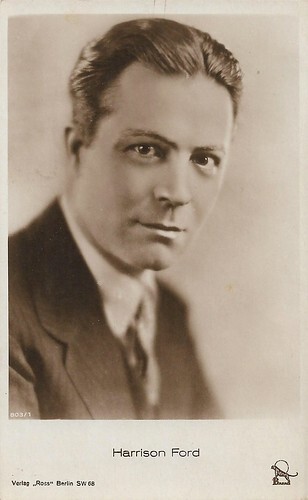
German postcard by Verlag Ross, Berlin, no. 803/1, 1925-1926. Photo: British American Films A.G. (Bafag).
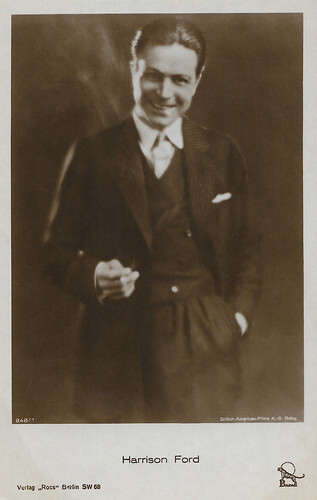
German postcard by Ross Verlag, no. 848/1, 1925-1926. Photo: British American Films A.G. Bafag.
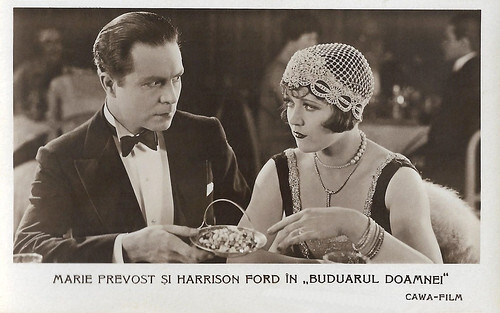
Romanian postcard. Photo: Cawa-Film / Christie Film. Harrison Ford and Marie Prevost in the comedy Up in Mabel's Room (E. Mason Hopper, 1926). The Romanian title 'Buduarul doamnei' translates as 'A Lady's Boudoir'.
Strongheart
Harrison Edward Ford was born in Kansas City, Missouri, in 1884. Ford has no known relation to the later film actor of the same name.
He began his acting career on the stage. He made his Broadway debut in 1904 in Richard Harding Davis's 'Ranson's Folly'.
He went on to appear in productions of William C. DeMille's 'Strongheart' and 'Glorious Betsy' by Rida Johnson Young. This production lasted only 24 performances but the play was later adapted for an Oscar-nominated film of the same name.
He also appeared in Bayard Veiller's 'The Fight', which quickly closed; Edgar Wallace's 'The Switchboard'; Edward Locke's 'The Bubble'; and Edgar Selwyn's 'Rolling Stones'. In 1909, Ford married New York stage actress Beatrice Prentice.

Spanish collectors card by Escenas selectas de cinematografia, series A, no. 16. Photo: Norma Talmadge Film. Norma Talmadge , Harrison Ford, and Howard Truesdale in The Wonderful Thing (Herbert Brenon, 1921), presented in Spain as 'La princesita del jamón' (The Ham Princess).

Spanish collectors card by Escenas selectas de cinematografia, series B, no. 7. Photo: Constance Talmadge Film. Harrison Ford and Constance Talmadge in Wedding Bells (Chester Withey, 1921), released in Spain as 'La senorita del pelo corto'.

Spanish collectors card by Escenas selectas de cinematografia, series B, no. 21. Photo: Constance Talmadge Film. Harrison Ford and Constance Talmadge in Wedding Bells (Chester Withey, 1921), released in Spain as 'La senorita del pelo corto'.
Food for Scandal
Harrison Ford turned to film in 1915 and moved to Hollywood. He became a leading man opposite stars such as Constance Talmadge , Norma Talmadge , Marie Prevost , Marion Davies , Marguerite De La Motte, and Clara Bow.
For director James Cruze, he appeared in such films as Hawthorne of the U.S.A. (James Cruze, 1919) with Wallace Reid , and Food for Scandal (James Cruze, 1920) with Wanda Hawley.
Ford's film career ended with the advent of sound film. His final film, and only talkie, Love in High Gear (Frank R. Strayer, 1932). He returned to acting in the theatre, and also directed productions at the Little Theater of the Verdugos in Glendale, California.
During World War II, he toured with the United Service Organizations (USO). According to IMDb , Ford was a recluse: "he shunned personal publicity and Hollywood itself."
In 1951, he was struck by a car driven by a teen girl while out walking. He never recovered from the severe injuries received and spent the rest of his life at the Motion Picture & Television Country House and Hospital in Woodland Hills, California, and died there in 1957, at the age of 73. He was buried in the Forest Lawn Memorial Park Cemetery in Glendale. For his contribution to the motion picture industry, Harrison Ford has a star on the Hollywood Walk of Fame in front of the Musso & Frank Grill at 6665 Hollywood Blvd.
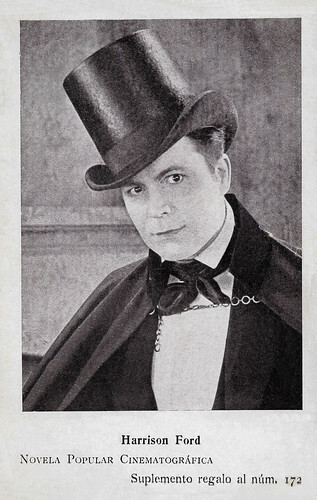
Spanish collectors card by Novela Popular Cinematográfica, gift supplement to no. 172.
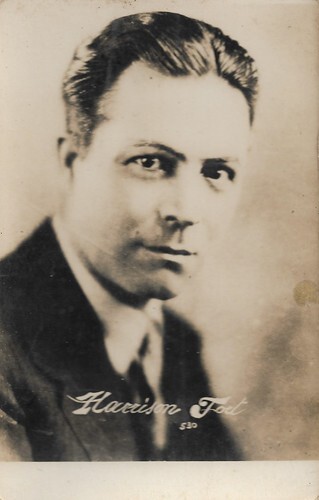
Spanish postcard, no. 530. The same photo was also on a Ross Verlag postcard, no. 803/1.
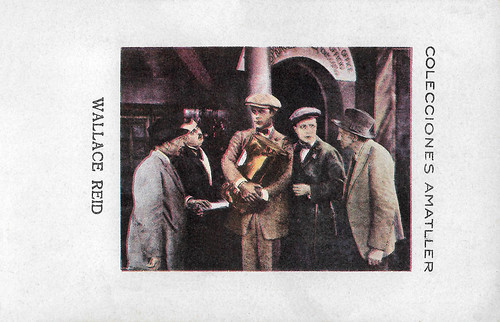
Spanish collectors card by Chocolate Amatller, series CC, artist 35, no. 77. Wallace Reid and Harrison Ford in Hawthorne of the U.S.A. (James Cruze, 1919). It is one of the few surviving films with Reid.
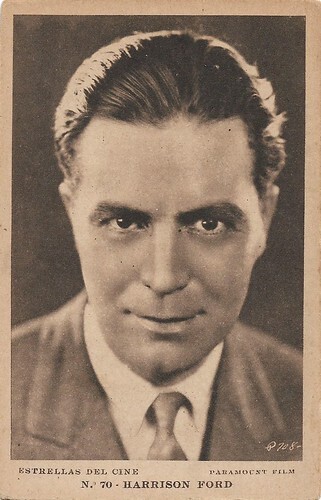
Spanish postcard in the series Estrella del cine, no. 70. Photo: Paramount Film, no. P 708.
Sources: Wikipedia and .

French postcard by Cinémagazine Edition, Paris, no. 328. On the card is his name written as 'Harrisson Ford' (sic).

German postcard by Verlag Ross, Berlin, no. 803/1, 1925-1926. Photo: British American Films A.G. (Bafag).

German postcard by Ross Verlag, no. 848/1, 1925-1926. Photo: British American Films A.G. Bafag.

Romanian postcard. Photo: Cawa-Film / Christie Film. Harrison Ford and Marie Prevost in the comedy Up in Mabel's Room (E. Mason Hopper, 1926). The Romanian title 'Buduarul doamnei' translates as 'A Lady's Boudoir'.
Strongheart
Harrison Edward Ford was born in Kansas City, Missouri, in 1884. Ford has no known relation to the later film actor of the same name.
He began his acting career on the stage. He made his Broadway debut in 1904 in Richard Harding Davis's 'Ranson's Folly'.
He went on to appear in productions of William C. DeMille's 'Strongheart' and 'Glorious Betsy' by Rida Johnson Young. This production lasted only 24 performances but the play was later adapted for an Oscar-nominated film of the same name.
He also appeared in Bayard Veiller's 'The Fight', which quickly closed; Edgar Wallace's 'The Switchboard'; Edward Locke's 'The Bubble'; and Edgar Selwyn's 'Rolling Stones'. In 1909, Ford married New York stage actress Beatrice Prentice.

Spanish collectors card by Escenas selectas de cinematografia, series A, no. 16. Photo: Norma Talmadge Film. Norma Talmadge , Harrison Ford, and Howard Truesdale in The Wonderful Thing (Herbert Brenon, 1921), presented in Spain as 'La princesita del jamón' (The Ham Princess).

Spanish collectors card by Escenas selectas de cinematografia, series B, no. 7. Photo: Constance Talmadge Film. Harrison Ford and Constance Talmadge in Wedding Bells (Chester Withey, 1921), released in Spain as 'La senorita del pelo corto'.

Spanish collectors card by Escenas selectas de cinematografia, series B, no. 21. Photo: Constance Talmadge Film. Harrison Ford and Constance Talmadge in Wedding Bells (Chester Withey, 1921), released in Spain as 'La senorita del pelo corto'.
Food for Scandal
Harrison Ford turned to film in 1915 and moved to Hollywood. He became a leading man opposite stars such as Constance Talmadge , Norma Talmadge , Marie Prevost , Marion Davies , Marguerite De La Motte, and Clara Bow.
For director James Cruze, he appeared in such films as Hawthorne of the U.S.A. (James Cruze, 1919) with Wallace Reid , and Food for Scandal (James Cruze, 1920) with Wanda Hawley.
Ford's film career ended with the advent of sound film. His final film, and only talkie, Love in High Gear (Frank R. Strayer, 1932). He returned to acting in the theatre, and also directed productions at the Little Theater of the Verdugos in Glendale, California.
During World War II, he toured with the United Service Organizations (USO). According to IMDb , Ford was a recluse: "he shunned personal publicity and Hollywood itself."
In 1951, he was struck by a car driven by a teen girl while out walking. He never recovered from the severe injuries received and spent the rest of his life at the Motion Picture & Television Country House and Hospital in Woodland Hills, California, and died there in 1957, at the age of 73. He was buried in the Forest Lawn Memorial Park Cemetery in Glendale. For his contribution to the motion picture industry, Harrison Ford has a star on the Hollywood Walk of Fame in front of the Musso & Frank Grill at 6665 Hollywood Blvd.

Spanish collectors card by Novela Popular Cinematográfica, gift supplement to no. 172.

Spanish postcard, no. 530. The same photo was also on a Ross Verlag postcard, no. 803/1.

Spanish collectors card by Chocolate Amatller, series CC, artist 35, no. 77. Wallace Reid and Harrison Ford in Hawthorne of the U.S.A. (James Cruze, 1919). It is one of the few surviving films with Reid.

Spanish postcard in the series Estrella del cine, no. 70. Photo: Paramount Film, no. P 708.
Sources: Wikipedia and .
Published on March 24, 2022 23:00
March 23, 2022
Alexander Moissi
Albanian-Austrian Alexander Moissi (1879-1935) was one of the great European stage actors of the early 20th century. The attractive and charismatic women's idol also appeared in several silent and early sound films.
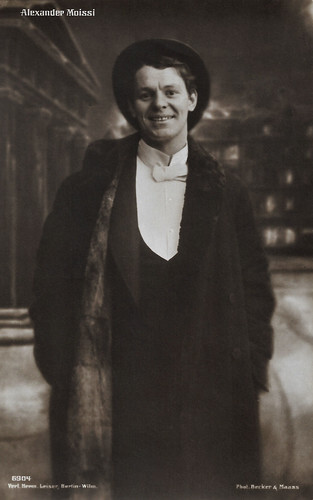
German postcard Verlag Hermann Leiser, Berlin-Wilm. no. 6904. Photo: Becker & Maass.
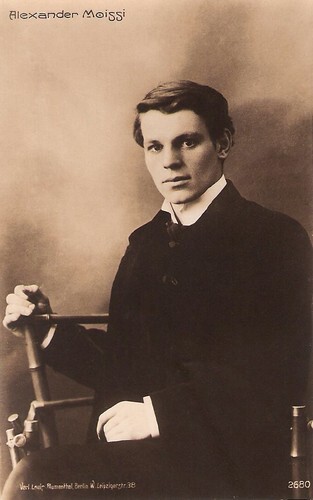
German postcard by Verlag Louis Blumenthal, Berlin, no. 2680.
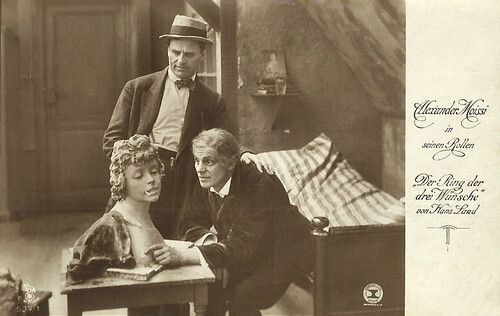
German postcard by Rotophot in the Film-Sterne series, no. 537/1. Photo: Amboss-Film / Dworsky Co. Alexander Moissi and Eduard von Winterstein in Der Ring der drei Wünsche (Arthur Wellin, Amboss-Film, Dworsky Co. 1918). The film was produced by Rudolf Dworsky and scripted by Hans Land (pseudonym of Hugo Landsberger) and Emil Rameau. Plot: A hunchback named Henrik obtains a wishing ring: youth, beauty and health.
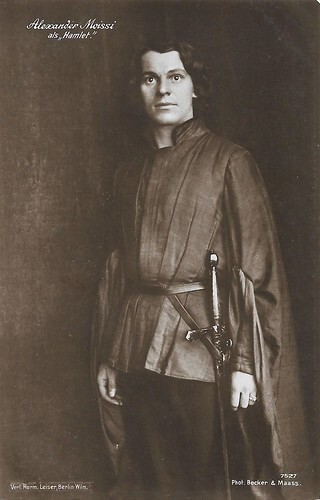
German postcar by Verlag Hermann Leiser, Berlin-Wilm, no. 7527. Photo: Becker & Maass. Alexander Moissi as Hamlet.
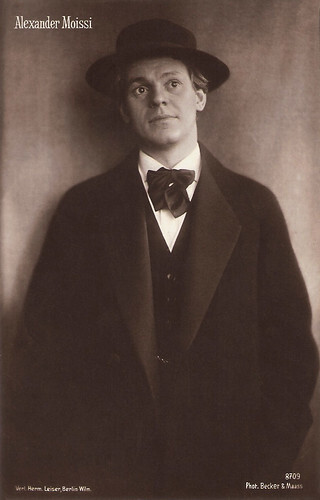
German postcard by Hermann Leiser Verlag, Berlin, no. 8709. Photo: Becker & Maass.
Buried Alive
Alexander Moissi was born as Aleksander Moisiu in Trieste, Austria-Hungary (now Italy) in 1879. He was the fifth and last child of Konstantin Moisiu, a rich Albanian merchant in oil and wheat, and the half Albanian, half Italian Amalia di Rada, the daughter of a Florentine writer and doctor.
After an international childhood in Trieste, Durrës, and Graz, 20-year-old Alexander finally settled with his mother and two sisters in Vienna. There he was spotted by Paul Schlenther, the director of the famous Burgtheater, and by the legendary actor Josef Kainz, who gave him acting lessons.
In 1901 Moissi moved to Prague where he worked for the Neue Deutsche Theater, and in 1904 to Berlin, where he became a protégé of the influential director Max Reinhardt at the Deutsche Theater. Here he had his breakthrough as Oswald in the Henrik Ibsen play 'Ghosts'. He would continue to play the part for more than two decades.
Under Reinhardt he played parts in many William Shakespeare plays including the jester in 'King Lear', Romeo in 'Romeo and Juliet' (1907), and the title role in 'Hamlet' (1909). In 1911, Moissi followed the Reinhardt Ensemble to Russia and was acclaimed in St. Petersburg by critic and dramatist Anatoliy Lunacharsky for his interpretation of Oedipus.
Travelling all over Europe and the Americas, he became a globally known star. His repertoire of leading roles encompassed the whole spectrum of European drama, from Greek tragedy to twentieth-century modernism. He was the first in Europe to interpret characters from Strindberg, Tolstoy, Chekhov, Pirandello, and Hofmannsthal.
His interpretations of Hamlet, Oedipus, Faust, Dubedat in George Bernard Shaw's 'The Doctor's Dilemma', and many others, were celebrated at the time, as were his voice and emotional range. His most famous role was Fedya in Leo Tolstoy's 'Buried Alive (or The Living Corpse)'. He performed this role 1500 times between 1913 and 1935 and more than one-and-a-half million people saw him playing the part.
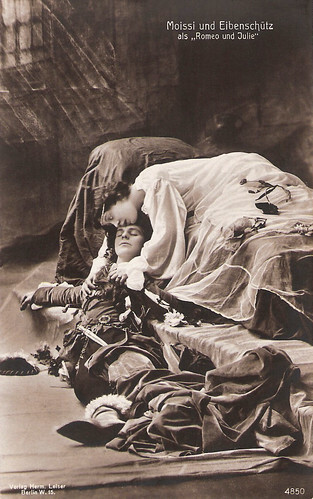
German postcard by Verlag Hermann Leiser, Berlin, no. 4850. Photo: publicity still for Romeo und Julie/Romeo and Juliet with Lia Eibenschütz .
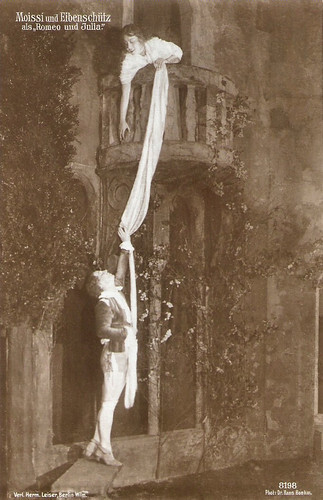
German postcard by Verlag Hermann Leiser, Berlin, no. 8198. Photo: Dr. Hans Boehm. Publicity still for Romeo und Julie/Romeo and Julietwith Lia Eibenschütz .
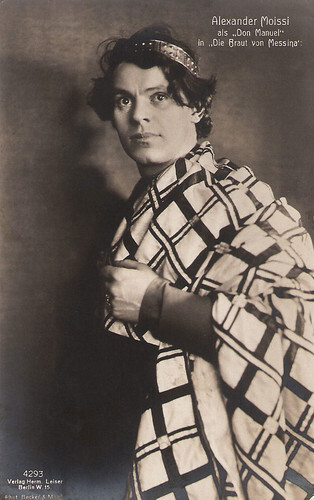
German postcard by Verlag Hermann Leiser, Berlin, no. 4293. Photo: Becker & Maass. Alexander Moissi as Don Manuel in a stage production of 'Die Braut von Messina' (The Bride of Messina) by Friedrich Schiller.
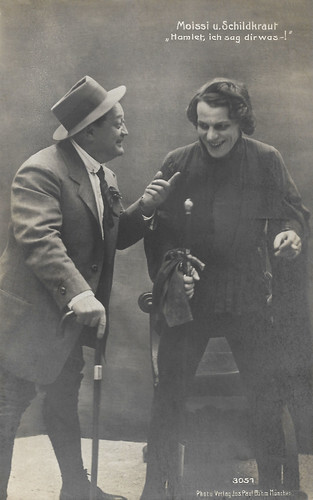
German postcard by Photo Verlag Jos. Paul Böhm, München (Munich), no. 3051. Alexander Moissi (right) and Rudolf Schildkraut in the play 'Hamlet, ich sag dir was!' (1909).
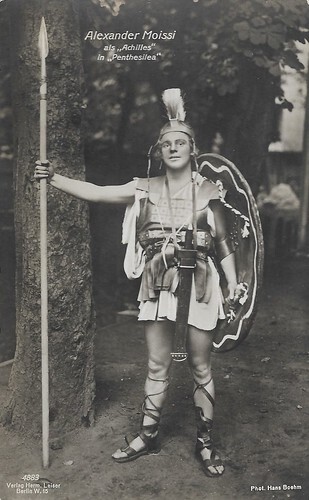
German postcard by Verlag Hermann Leiser, Berlin, no. 4883. Photo: Hans Boehm. Alexander Moissi as Achilles in 'Penthesilea' by Heinrich von Kleist. The play premiered on 23 September 1911 at the Deutsches Theater in Berlin. Gertrud Eysoldt played the title role.
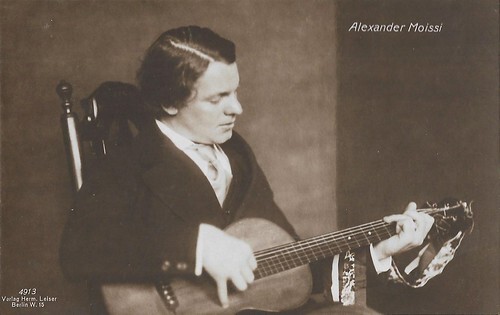
German postcard by Verlag Hermann Leiser, Berlin, no. 4913.
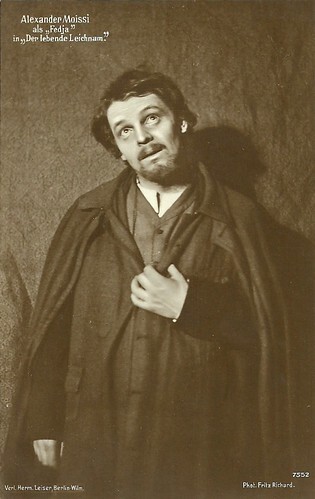
German postcard by Verlag Hermann Leiser, Berlin-Wilm., no. 7552. Photo: Fritz Richard. Alexander Moissi as Fedja in Leo Tolstoy's play 'Der lebende Leichnam' (The Living Corpse).
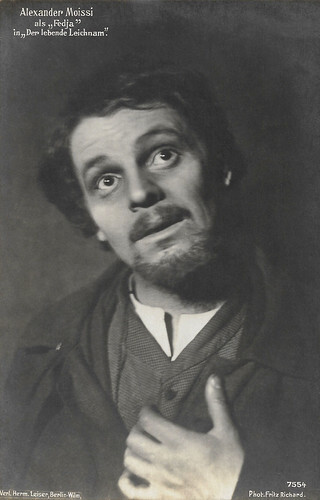
German postcard by Verlag Herm. Leiser, Berlin-Wilm., no. 7554. Photo: Fritz Richard. Alexander Moissi as Fedja in the play 'Der lebende Leichnam' (The Living Corpse or Russian: Живой труп) by Leo Tolstoy.
Prisoner in France
Though primarily a stage actor, Alexander Moissi appeared in 17 films productions between 1913 and 1935.
In 1913 he appeared in Germany in four silent films for the Deutsche Bioscop GmbH: the experimental pantomime Das schwarze Los/The black lot (Emil Albes, John Gottowt, 1913), Meier Helmbrechts Flucht und Ende/Meier Helmbrecht’s Flight and End (Leo Greiner, 1913), Die Augen des Ole Brandis/The Eyes of Ole Brandis (Stellan Rye, 1913), and he had a supporting role in the classic fantasy film Der Student von Prag/The Student of Prague (Stellan Rye, Paul Wegener, 1913) starring Paul Wegener .
Two years later he starred in the films Kulissenzauber/Background magic (Heinrich Bolten-Baeckers, Leo Peukert, 1915) and Sein einziger Sohn/His Only Son (Adolf Gartner, 1915).
It was World War I and in 1915 Moissi was mobilized by the Austrian army. As an airman, he was taken prisoner in France, but he got free five months later through a prisoner exchange. Till 1917 he worked as a stage actor in Switzerland.
In 1918 he starred as Stanislaus in Pique Dame (Arthur Wellin, 1918), a film adaptation of Alexander Pushkin’s short story The Queen of Spades. That same year he appeared opposite Ria Jende in Der Ring der drei Wünsche/The Ring of the Three Wishes (Arthur Wellin, 1918).
The following years he played in such silent films as Erborgtes Glück/Borrowed Happiness (Arthur Wellin, 1919) with Käthe Dorsch , Zwischen Tod und Leben/Between Life and Death (Arthur Wellin, 1919) with Bernhard Goetzke , Figaros Hochzeit/Figaro’s Wedding (Max Mack, 1920) based on the play by Beaumarchais, and Die Nacht der Königin Isabeau/The Night of Queen Isabeau (Robert Wiene, 1920) starring Fern Andra .
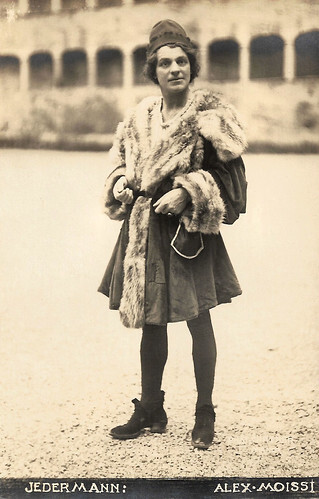
Austrian postcard by Traub, Salzburg. Photo: Atelier K. Hintner. Alexander Moissi as Jedermann in the stage production 'Jedermann' (Everyman) at the Salzburger Festspiele. Max Reinhardt directed Moissi in this production in 1919 and 1920 and from 1926 till 1931.
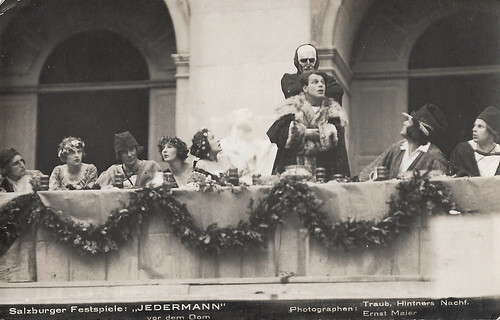
Austrian postcard by Traub, Salzburg. Photo: Ernst Maier (Atelier K. Hintner). Alexander Moissi as Jedermann in the stage production 'Jedermann' (Everyman) at the Salzburger Festspiele, performed before the Salzburg Dom (cathedral). Max Reinhardt directed Moissi in this production in 1919 and 1920 and from 1926 till 1931. Caption: Everyman in front of the cathedral.
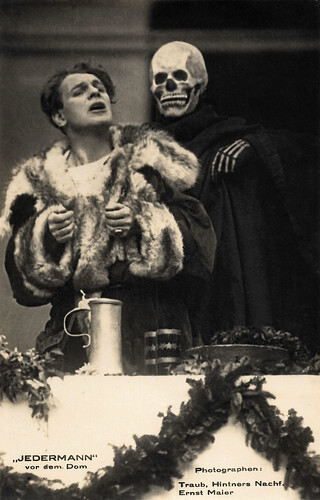
Austrian postcard by Traub, Salzburg. Photo: Ernst Maier (Atelier K. Hintner). Alexander Moissi as Jedermann in the stage production 'Jedermann' (Everyman) at the Salzburger Festspiele. Max Reinhardt directed Moissi in this production in 1919 and 1920 and from 1926 till 1931. Caption: Everyman in front of the cathedral.
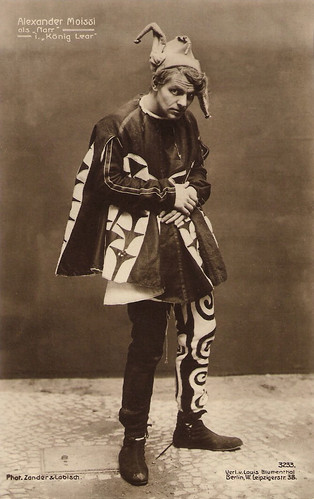
German postcard by Verlag Louis Blumenthal, Berlin, no. 3233. Photo: Zander & Labisch. Alexander Moissi as the Jester in 'König Lear' (King Lear).
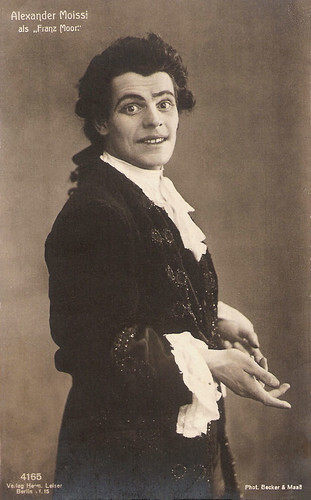
German postcard by Hermann Leiser Verlag, Berlin, no. 4165. Photo: Becker & Maass. Publicity still for a stage production of 'Die Räuber' (The Robbers) by Friedrich Schiller with Moissi as Franz Moor.
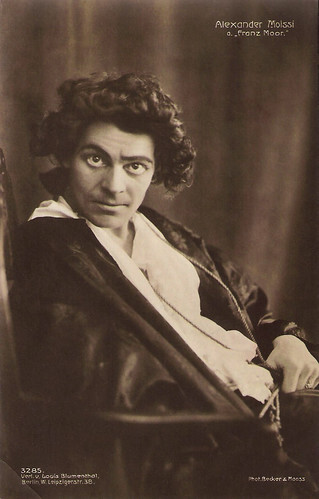
German postcard by Verl. v. Louis Blumenthal, Berlin, no. 3285. Photo: Becker & Maass. Alexander Moissi as Franz Moor in the stage play 'Die Räuber' (The Robbers) by Friedrich Schiller.
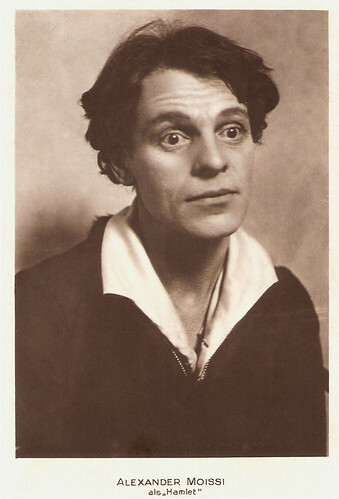
German postcard. Photo: Alexander Moissi as Hamlet a stage production of 'Hamlet' by William Shakespeare.
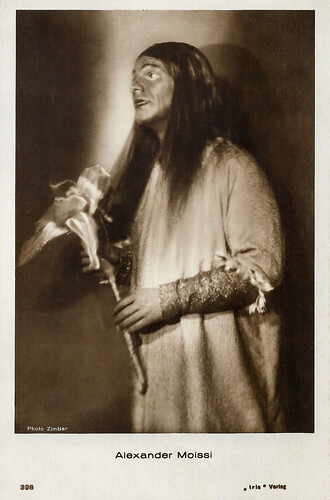
Austrian postcard by Iris-Verlag, no. 328. Photo: Zimler.
Albanian citizen
Alexander Moissi’s last silent film was Kean (Rudolf Biebrach, 1921) based on the play by Alexandre Dumas père. Edmund Kean, born in 1787, was the greatest Shakespearean actor of his day. Remarkable is that Moissi’s first sound film, the Hollywood production Die Königsloge/The Royal Box (Bryan Foy, 1929) also told the story of Edmund Kean. The German-language production by Warner Brothers was not a success.
In the 1920s Moissi had more success in Russia, France, Austria, and Italy than in Germany. After the rise of the Nazis in Germany, Moissi reportedly became an Albanian citizen in 1934 (some sources say that he got an Italian passport). After a successful stage tour through Italy in 1934, Mossi starred in the Italian film production Lorenzino de' Medici/The Magnificent Rogue (Guido Brignone, 1935) with Maria Denis . It would be his final film.
A year later, Alexander Moissi died of pneumonia in Vienna, (some sources say Lugano, Switzerland), and lies buried at the Morcote cemetery overlooking Lake Lugano.
He was married twice. With his first wife, the Viennese actress Maria Moissi he had a daughter, Bettina, who also would become an actress. In 1919 he married actress Johanna Terwin. He is the over-grandfather of German actor Gedeon Burkhard.
In his honor, the High College of Drama in Tirana, and the Professional Theatre of Durrës, Albania, are named ‘Aleksander Moisiu.’ The 60th anniversary of his death was remembered in Albania in 1995 with an Artistic Year dedicated to him; it was sponsored by the Aleksander Moisiu Foundation in Durrës.
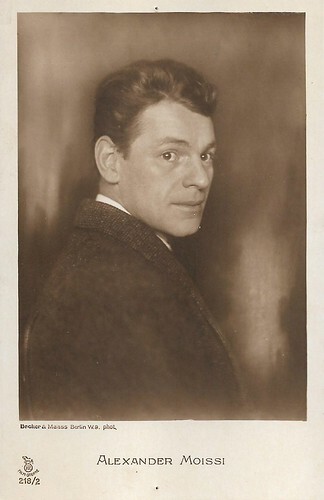
German postcard by Rotophot in the Film-Sterne series, no. 218/2. Photo: Becker & Maass, Berlin.
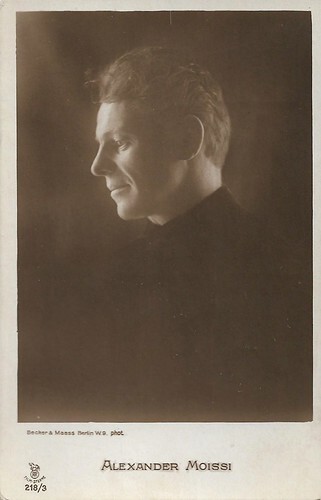
German postcard by Rotophot in the Film-Sterne series, no. 218/3. Photo: Becker & Maass, Berlin.
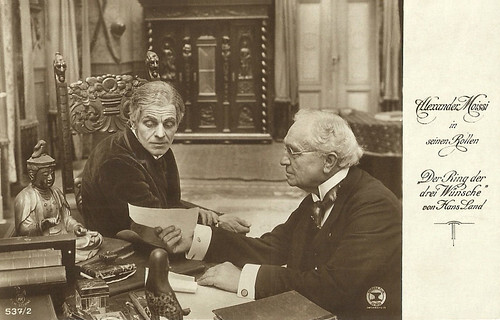
German postcard by Rotophot in the Film-Sterne series, no. 537/2. Photo: Amboss-Film / Dworsky Co. Alexander Moissi (left) in Der Ring der drei Wünsche/The Ring of Three Wishes (Arthur Wellin, 1918).
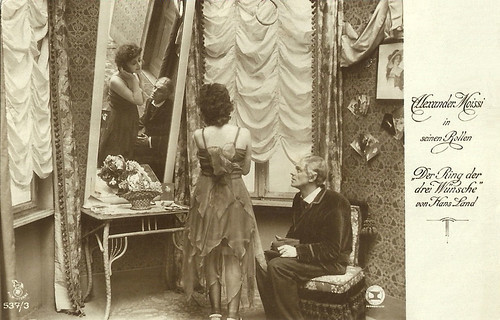
German postcard by Rotophot in the Film-Sterne series, no. 537/3. Photo: Amboss-Film / Dworsky Co. Alexander Moissi and Ria Jende in Der Ring der drei Wünsche/The Ring of Three Wishes (Arthur Wellin, 1918).
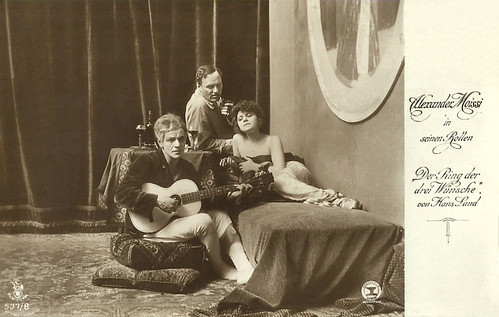
German postcard by Rotophot in the Film-Sterne Series, no. 537/8. Photo: Amboss-Film, Dworsky Co. Alexander Moissi, Ria Jende and Eduard von Winterstein in Der Ring der drei Wünsche (Arthur Wellin, 1918).
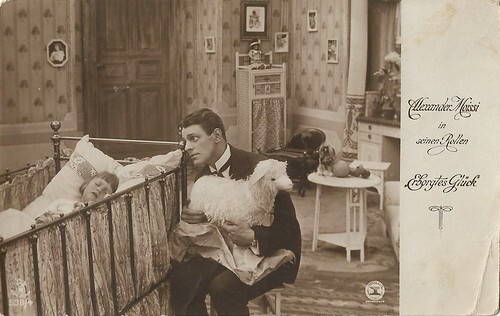
German postcard by Rotophot in the Film-Sterne series, no. 538/4. Photo: Amboss Film. Alexander Moissi in Erborgtes Glück/Borrowed Happiness (Arthur Wellin, 1919).
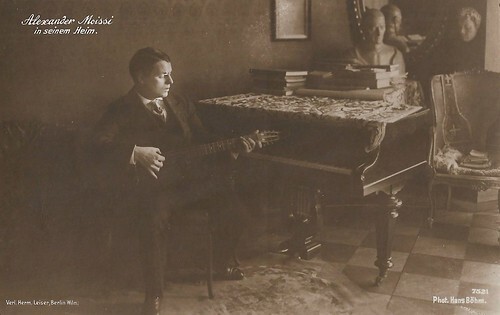
German postcard by Verlag Hermann Leiser, Berlin-Wilm, no. 7521. Photo: Hans Boehm. Caption: Alexander Moissi in seinem Heim (at home).
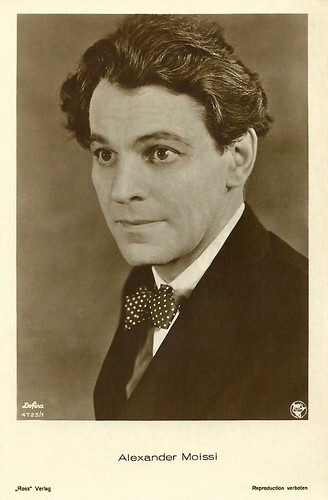
German postcard by Ross Verlag, no. 4725/1, 1929-1930. Photo: Defina.
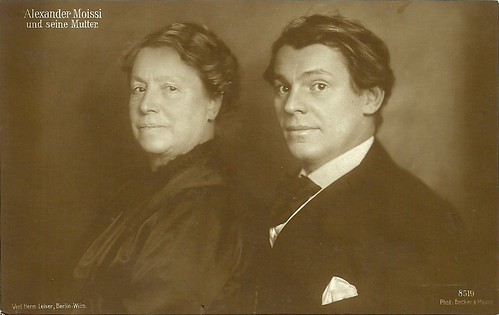
German postcard by Verlag Hermann Leiser, Berlin-Wilm., no. 8519. Photo: Becker & Maass. Caption: Alexander Moissi and his mother.
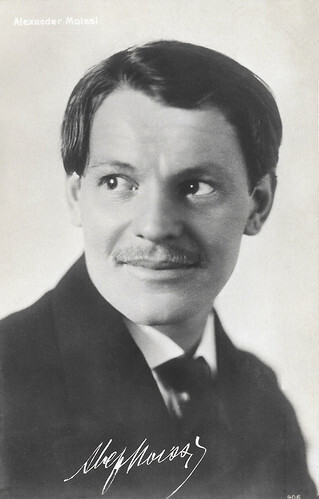
German postcard by Kunst-Verlag L. Murr, München, no. 406. Photo: Friede Hostrup, München.
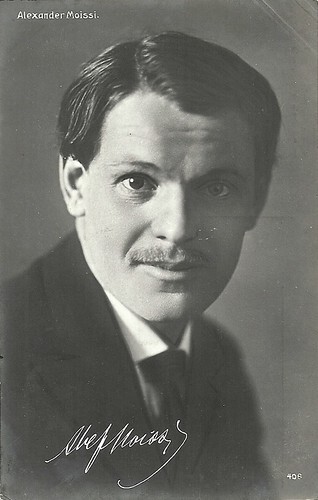
German postcard by Kunst-Verlag L. Murr, München, no. 408. Photo: Friede Hostrup, München.
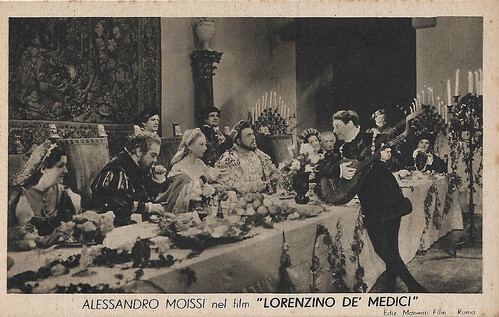
Italian postcard by Ed. Manenti Film, Roma. Alexander Moissi in the Italian historical film Lorenzino de' Medici (Guido Brignone, 1935). The Henry VIII-like figure is the perfidious Duke Alessandro, played by Camillo Pilotto, who covets Lorenzo's (Moissi) sweetheart (Germana Paolieri).
Sources: Stephanie D’heil (Steffi-line - German), Thomas Staedeli (Cyranos), Wikipedia, and .

German postcard Verlag Hermann Leiser, Berlin-Wilm. no. 6904. Photo: Becker & Maass.

German postcard by Verlag Louis Blumenthal, Berlin, no. 2680.

German postcard by Rotophot in the Film-Sterne series, no. 537/1. Photo: Amboss-Film / Dworsky Co. Alexander Moissi and Eduard von Winterstein in Der Ring der drei Wünsche (Arthur Wellin, Amboss-Film, Dworsky Co. 1918). The film was produced by Rudolf Dworsky and scripted by Hans Land (pseudonym of Hugo Landsberger) and Emil Rameau. Plot: A hunchback named Henrik obtains a wishing ring: youth, beauty and health.

German postcar by Verlag Hermann Leiser, Berlin-Wilm, no. 7527. Photo: Becker & Maass. Alexander Moissi as Hamlet.

German postcard by Hermann Leiser Verlag, Berlin, no. 8709. Photo: Becker & Maass.
Buried Alive
Alexander Moissi was born as Aleksander Moisiu in Trieste, Austria-Hungary (now Italy) in 1879. He was the fifth and last child of Konstantin Moisiu, a rich Albanian merchant in oil and wheat, and the half Albanian, half Italian Amalia di Rada, the daughter of a Florentine writer and doctor.
After an international childhood in Trieste, Durrës, and Graz, 20-year-old Alexander finally settled with his mother and two sisters in Vienna. There he was spotted by Paul Schlenther, the director of the famous Burgtheater, and by the legendary actor Josef Kainz, who gave him acting lessons.
In 1901 Moissi moved to Prague where he worked for the Neue Deutsche Theater, and in 1904 to Berlin, where he became a protégé of the influential director Max Reinhardt at the Deutsche Theater. Here he had his breakthrough as Oswald in the Henrik Ibsen play 'Ghosts'. He would continue to play the part for more than two decades.
Under Reinhardt he played parts in many William Shakespeare plays including the jester in 'King Lear', Romeo in 'Romeo and Juliet' (1907), and the title role in 'Hamlet' (1909). In 1911, Moissi followed the Reinhardt Ensemble to Russia and was acclaimed in St. Petersburg by critic and dramatist Anatoliy Lunacharsky for his interpretation of Oedipus.
Travelling all over Europe and the Americas, he became a globally known star. His repertoire of leading roles encompassed the whole spectrum of European drama, from Greek tragedy to twentieth-century modernism. He was the first in Europe to interpret characters from Strindberg, Tolstoy, Chekhov, Pirandello, and Hofmannsthal.
His interpretations of Hamlet, Oedipus, Faust, Dubedat in George Bernard Shaw's 'The Doctor's Dilemma', and many others, were celebrated at the time, as were his voice and emotional range. His most famous role was Fedya in Leo Tolstoy's 'Buried Alive (or The Living Corpse)'. He performed this role 1500 times between 1913 and 1935 and more than one-and-a-half million people saw him playing the part.

German postcard by Verlag Hermann Leiser, Berlin, no. 4850. Photo: publicity still for Romeo und Julie/Romeo and Juliet with Lia Eibenschütz .

German postcard by Verlag Hermann Leiser, Berlin, no. 8198. Photo: Dr. Hans Boehm. Publicity still for Romeo und Julie/Romeo and Julietwith Lia Eibenschütz .

German postcard by Verlag Hermann Leiser, Berlin, no. 4293. Photo: Becker & Maass. Alexander Moissi as Don Manuel in a stage production of 'Die Braut von Messina' (The Bride of Messina) by Friedrich Schiller.

German postcard by Photo Verlag Jos. Paul Böhm, München (Munich), no. 3051. Alexander Moissi (right) and Rudolf Schildkraut in the play 'Hamlet, ich sag dir was!' (1909).

German postcard by Verlag Hermann Leiser, Berlin, no. 4883. Photo: Hans Boehm. Alexander Moissi as Achilles in 'Penthesilea' by Heinrich von Kleist. The play premiered on 23 September 1911 at the Deutsches Theater in Berlin. Gertrud Eysoldt played the title role.

German postcard by Verlag Hermann Leiser, Berlin, no. 4913.

German postcard by Verlag Hermann Leiser, Berlin-Wilm., no. 7552. Photo: Fritz Richard. Alexander Moissi as Fedja in Leo Tolstoy's play 'Der lebende Leichnam' (The Living Corpse).

German postcard by Verlag Herm. Leiser, Berlin-Wilm., no. 7554. Photo: Fritz Richard. Alexander Moissi as Fedja in the play 'Der lebende Leichnam' (The Living Corpse or Russian: Живой труп) by Leo Tolstoy.
Prisoner in France
Though primarily a stage actor, Alexander Moissi appeared in 17 films productions between 1913 and 1935.
In 1913 he appeared in Germany in four silent films for the Deutsche Bioscop GmbH: the experimental pantomime Das schwarze Los/The black lot (Emil Albes, John Gottowt, 1913), Meier Helmbrechts Flucht und Ende/Meier Helmbrecht’s Flight and End (Leo Greiner, 1913), Die Augen des Ole Brandis/The Eyes of Ole Brandis (Stellan Rye, 1913), and he had a supporting role in the classic fantasy film Der Student von Prag/The Student of Prague (Stellan Rye, Paul Wegener, 1913) starring Paul Wegener .
Two years later he starred in the films Kulissenzauber/Background magic (Heinrich Bolten-Baeckers, Leo Peukert, 1915) and Sein einziger Sohn/His Only Son (Adolf Gartner, 1915).
It was World War I and in 1915 Moissi was mobilized by the Austrian army. As an airman, he was taken prisoner in France, but he got free five months later through a prisoner exchange. Till 1917 he worked as a stage actor in Switzerland.
In 1918 he starred as Stanislaus in Pique Dame (Arthur Wellin, 1918), a film adaptation of Alexander Pushkin’s short story The Queen of Spades. That same year he appeared opposite Ria Jende in Der Ring der drei Wünsche/The Ring of the Three Wishes (Arthur Wellin, 1918).
The following years he played in such silent films as Erborgtes Glück/Borrowed Happiness (Arthur Wellin, 1919) with Käthe Dorsch , Zwischen Tod und Leben/Between Life and Death (Arthur Wellin, 1919) with Bernhard Goetzke , Figaros Hochzeit/Figaro’s Wedding (Max Mack, 1920) based on the play by Beaumarchais, and Die Nacht der Königin Isabeau/The Night of Queen Isabeau (Robert Wiene, 1920) starring Fern Andra .

Austrian postcard by Traub, Salzburg. Photo: Atelier K. Hintner. Alexander Moissi as Jedermann in the stage production 'Jedermann' (Everyman) at the Salzburger Festspiele. Max Reinhardt directed Moissi in this production in 1919 and 1920 and from 1926 till 1931.

Austrian postcard by Traub, Salzburg. Photo: Ernst Maier (Atelier K. Hintner). Alexander Moissi as Jedermann in the stage production 'Jedermann' (Everyman) at the Salzburger Festspiele, performed before the Salzburg Dom (cathedral). Max Reinhardt directed Moissi in this production in 1919 and 1920 and from 1926 till 1931. Caption: Everyman in front of the cathedral.

Austrian postcard by Traub, Salzburg. Photo: Ernst Maier (Atelier K. Hintner). Alexander Moissi as Jedermann in the stage production 'Jedermann' (Everyman) at the Salzburger Festspiele. Max Reinhardt directed Moissi in this production in 1919 and 1920 and from 1926 till 1931. Caption: Everyman in front of the cathedral.

German postcard by Verlag Louis Blumenthal, Berlin, no. 3233. Photo: Zander & Labisch. Alexander Moissi as the Jester in 'König Lear' (King Lear).

German postcard by Hermann Leiser Verlag, Berlin, no. 4165. Photo: Becker & Maass. Publicity still for a stage production of 'Die Räuber' (The Robbers) by Friedrich Schiller with Moissi as Franz Moor.

German postcard by Verl. v. Louis Blumenthal, Berlin, no. 3285. Photo: Becker & Maass. Alexander Moissi as Franz Moor in the stage play 'Die Räuber' (The Robbers) by Friedrich Schiller.

German postcard. Photo: Alexander Moissi as Hamlet a stage production of 'Hamlet' by William Shakespeare.

Austrian postcard by Iris-Verlag, no. 328. Photo: Zimler.
Albanian citizen
Alexander Moissi’s last silent film was Kean (Rudolf Biebrach, 1921) based on the play by Alexandre Dumas père. Edmund Kean, born in 1787, was the greatest Shakespearean actor of his day. Remarkable is that Moissi’s first sound film, the Hollywood production Die Königsloge/The Royal Box (Bryan Foy, 1929) also told the story of Edmund Kean. The German-language production by Warner Brothers was not a success.
In the 1920s Moissi had more success in Russia, France, Austria, and Italy than in Germany. After the rise of the Nazis in Germany, Moissi reportedly became an Albanian citizen in 1934 (some sources say that he got an Italian passport). After a successful stage tour through Italy in 1934, Mossi starred in the Italian film production Lorenzino de' Medici/The Magnificent Rogue (Guido Brignone, 1935) with Maria Denis . It would be his final film.
A year later, Alexander Moissi died of pneumonia in Vienna, (some sources say Lugano, Switzerland), and lies buried at the Morcote cemetery overlooking Lake Lugano.
He was married twice. With his first wife, the Viennese actress Maria Moissi he had a daughter, Bettina, who also would become an actress. In 1919 he married actress Johanna Terwin. He is the over-grandfather of German actor Gedeon Burkhard.
In his honor, the High College of Drama in Tirana, and the Professional Theatre of Durrës, Albania, are named ‘Aleksander Moisiu.’ The 60th anniversary of his death was remembered in Albania in 1995 with an Artistic Year dedicated to him; it was sponsored by the Aleksander Moisiu Foundation in Durrës.

German postcard by Rotophot in the Film-Sterne series, no. 218/2. Photo: Becker & Maass, Berlin.

German postcard by Rotophot in the Film-Sterne series, no. 218/3. Photo: Becker & Maass, Berlin.

German postcard by Rotophot in the Film-Sterne series, no. 537/2. Photo: Amboss-Film / Dworsky Co. Alexander Moissi (left) in Der Ring der drei Wünsche/The Ring of Three Wishes (Arthur Wellin, 1918).

German postcard by Rotophot in the Film-Sterne series, no. 537/3. Photo: Amboss-Film / Dworsky Co. Alexander Moissi and Ria Jende in Der Ring der drei Wünsche/The Ring of Three Wishes (Arthur Wellin, 1918).

German postcard by Rotophot in the Film-Sterne Series, no. 537/8. Photo: Amboss-Film, Dworsky Co. Alexander Moissi, Ria Jende and Eduard von Winterstein in Der Ring der drei Wünsche (Arthur Wellin, 1918).

German postcard by Rotophot in the Film-Sterne series, no. 538/4. Photo: Amboss Film. Alexander Moissi in Erborgtes Glück/Borrowed Happiness (Arthur Wellin, 1919).

German postcard by Verlag Hermann Leiser, Berlin-Wilm, no. 7521. Photo: Hans Boehm. Caption: Alexander Moissi in seinem Heim (at home).

German postcard by Ross Verlag, no. 4725/1, 1929-1930. Photo: Defina.

German postcard by Verlag Hermann Leiser, Berlin-Wilm., no. 8519. Photo: Becker & Maass. Caption: Alexander Moissi and his mother.

German postcard by Kunst-Verlag L. Murr, München, no. 406. Photo: Friede Hostrup, München.

German postcard by Kunst-Verlag L. Murr, München, no. 408. Photo: Friede Hostrup, München.

Italian postcard by Ed. Manenti Film, Roma. Alexander Moissi in the Italian historical film Lorenzino de' Medici (Guido Brignone, 1935). The Henry VIII-like figure is the perfidious Duke Alessandro, played by Camillo Pilotto, who covets Lorenzo's (Moissi) sweetheart (Germana Paolieri).
Sources: Stephanie D’heil (Steffi-line - German), Thomas Staedeli (Cyranos), Wikipedia, and .
Published on March 23, 2022 23:00
March 22, 2022
Der Ölprinz (1965)
In the Karl May adaptation Der Ölprinz/The Oil Prince (Harald Philipp, 1965), Apache Chief Winnetou (Pierre Brice) and scout Old Surehand (Stewart Granger) team up to assist a wagon-train of settlers who are threatened by the machinations of an unscrupulous crook known as 'the Oil Prince' (Harald Leipnitz). The West German-Yugoslav Western was also known as Rampage at Apache Wells. The film was one of a series of Karl May films made by Rialto Film.
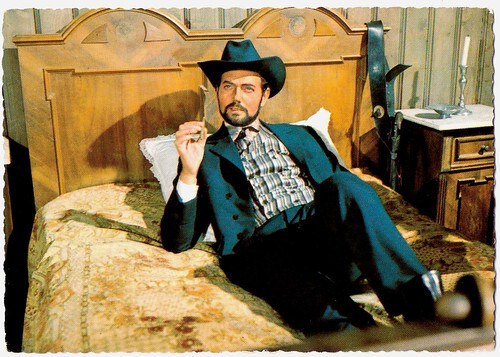
German postcard, no. 1 (of 32). Photo: Rialto / Constantin. Harald Leipnitz in Der Ölprinz/The Oil Prince (Harald Philipp, 1965). Caption: This is the oil prince, a ruthless adventurer who will do anything to get his hands on land and oil wells. His helpers are members of the Finders Gang. He has now commissioned them to intercept and kill the scout Bill Forner, who is to lead a trek of settlers to Lake Shelly. A member of the Finders Gang is to take his place and lead the trek astray because he needs the area around Lake Shelly for his machinations.
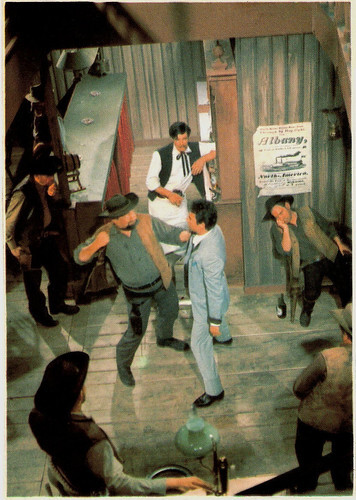
German postcard, no. 5 (of 32). Photo: Rialto / Constantin. Mario Girotti (Terence Hill) as Richard Forsythe in Der Ölprinz/The Oil Prince (Harald Philipp, 1965). Caption: A commotion ensues in the hotel, which ends in a brawl. Members of the Finders gang, who have been playing poker with young Forsythe, have discovered that Forsythe is a cardsharp. The oil prince rescues the young man from this situation. In return, he is supposed to join the trek and serve as a spy for the oil prince.
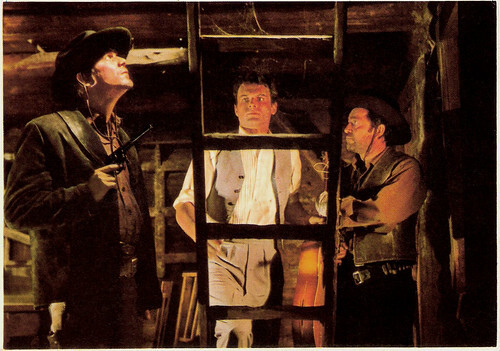
German postcard, no. 8. Photo: Rialto / Constantin. Mario Girotti (Terence Hill) in Der Ölprinz/Rampage at Apache Wells (Harald Philipp, 1965). Caption: The trek reaches according to appointment to the first stage near the river. The young Forsyth secretly sneaks out of the camp and meets with members of the Finders gang in the blockhouse. Here he receives his instructions, for the Finders gang will in the discharge of the Oil prince attack the wagons during the night.
Bandits, Indians, and Settlers
The bandit the Oil Prince (Harald Leipnitz) wants to sell the banker Duncan (Vladimir Leib) a fake oil well. However, a trek of settlers who want to settle in the area, of all places, stands in his way. The Oil Prince has the settlers' scout replaced by a member of the Finders Gang. Old Surehand ( Stewart Granger ) and Winnetou ( Pierre Brice ) track him down and are able to warn the trek.
Winnetou convinces the Navajo chief Nitsas-ini (Petar Dobric) of the peaceful nature of the settlers, and he lets them pass through his territory unhindered with Old Wabble (Milan Srdoc) as their guide to a stopover at the Chinla River. On the way to Utah, Old Surehand is lured into a trap by the Finders bandits, but Winnetou is able to rescue him.
At the Chinla River, the settlers, among them the widow Ebersbach (Antje Weisgerber), the cantor Hampel (Heinz Erhardt), the cardsharp Richard Forsythe ( Mario Girotti a.k.a. Terence Hill), and the shady businessman Bergmann (Veljko Maricic), are getting ready to spend the night when the Finders bandits attack. However, the attack can be repelled by Winnetou and Old Surehand, who arrive in time.
After the attack fails, the Oil Prince comes up with something new. He murders the son of the chief Mokaschi (Milivoje Popovic-Mavid) and blames the Indians for it on the settlers. The Indians surround the settlers at the river but are persuaded to wait with their attack if Old Surehand delivers the real murderer to them within a day.
Winnetou tries to bring the women and children to safety on the raging river with a raft. However, they fall into the water and are only saved when Old Surehand arrives. Old Surehand sets off in pursuit of the Oil Prince, who in the meantime has taken the money for the fake oil well from the banker Duncan and has trapped him in the oil cave with an avalanche of rubble.
Old Surehand is able to capture and tie up the Oil Prince after a short chase and a fight. The Indians have become impatient in the meantime and begin their attack on the settlers. The first wagons are already in flames when Old Surehand returns. The Oil Prince, who has been brought along, is handed over to the Indians and receives his just punishment from them.
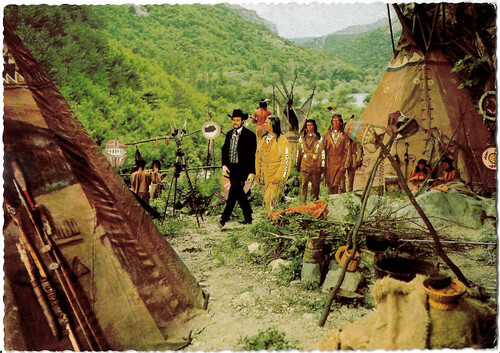
German postcard, no. 10 (of 32). Photo: Rialto / Constantin. Harald Leipnitz and Pierre Brice in Der Ölprinz/The Oil Prince (Harald Philipp, 1965). Caption: In the Comanche camp he tells the chief that one of the settlers is in possession of a silver dollar sack. This must be the only survivor of the stagecoach robbery.
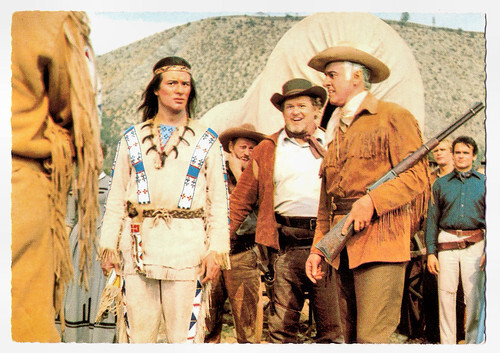
German postcard, no. 12. Photo: Rialto / Constantin. Pierre Brice , Stewart Granger, and Walter Barnes in Der Ölprinz/The Oil Prince (Harald Philipp, 1965). Caption: When he arrives in the camp of the settlers, chief Mokaschi reports what has been told to him by the Oil Prince. Winnetou, Old Surehand, and Campbell reaffirm that they have no money. The Chief is welcome to search their wagon.
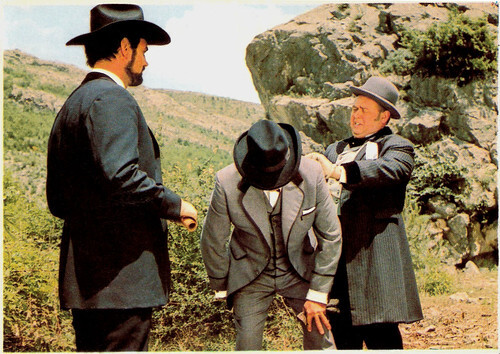
German postcard, no. 15 (of 32). Photo: Rialto / Constantin. Harald Leipnitz in Der Ölprinz/The Oil Prince (Harald Philipp, 1965). Caption: The Oil Prince has arrived at Lake Shelly with his servant Knife. There he meets the chief executive of the Arizona Commercial Bank and his secretary. After demonstrating fake oil chains to the director, he sells them to him for 75,000 dollars. But that is not enough. After issuing the cheque, he has them both killed by the Finders Gang.
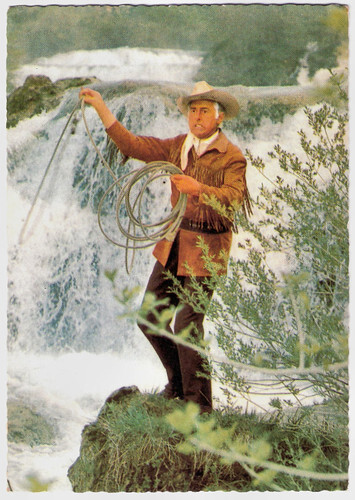
German postcard. Photo: Rialto / Constantin, no. 20. Stewart Granger as Old Surehand in Der Ölprinz/The Oil Prince (Harald Philipp, 1965). Caption: Bravely, young Forsythe holds his own on the raft. Old Surehand has reached a jutting cliff. In time he can throw his lasso to young Forsythe and pull him ashore. The empty raft crashes down the waterfall.
Old Surehand instead of Old Shatterhand
Apart from Der Schut, Der Ölprinz/The Oil Prince (Harald Philipp, 1965) is the only Karl May film in which the title character is a villain.
For the second time, Stewart Granger plays Old Surehand, deviating from the Karl May novel in which Old Shatterhand takes the main role. Producer Horst Wendlandt was unable to cast Lex Barker as Old Shatterhand because of Artur Brauner's production Through Wild Kurdistan.
The part of Lizzy (Macha Méril) was originally supposed to be played by Marie Versini, but she was also already under contract with Brauner at the time of filming. Fred Denger wrote the script, which was subsequently revised by Harald Philipp.
As Harald Reinl and Alfred Vohrer were busy, Wendlandt originally wanted Paul Martin as director. When the collaboration did not materialise, he called Harald Philipp in Berlin at Christmas 1964, who immediately agreed. Martin Böttcher once again composed an atmospheric score.
Der Ölprinz/The Oil Prince was shot at the Spandau Studios in Berlin and on location in Yugoslavia. The film's sets were designed by the art director Dusan Jericevic. Jericević had transformed the Western town of "Golden Hill" from Old Shatterhand into "Tucson".
Der Ölprinz/The Oil Prince recorded admissions of 409,817 in France, 1,449,558 in Spain, and over 3 million in Germany.
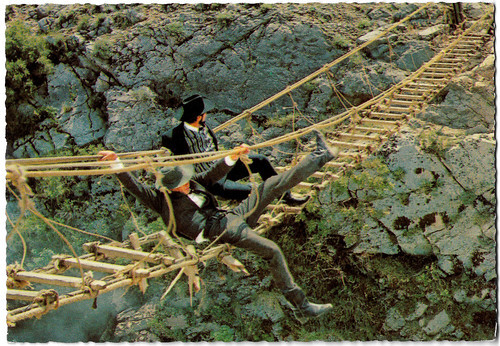
German postcard, no. 21. Photo: Rialto / Constantin. Stewart Granger as Old Surehand and Harald Leipnitz in Der Ölprinz/The Oil Prince (Harald Philipp, 1965). Caption: The oil prince in possession of the cheque is in a hurry to get back to town. Accompanied by Knife, he chooses a suspension bridge as a shortcut. Old Surehand surprises them. He forces them both to return by shooting the rungs.
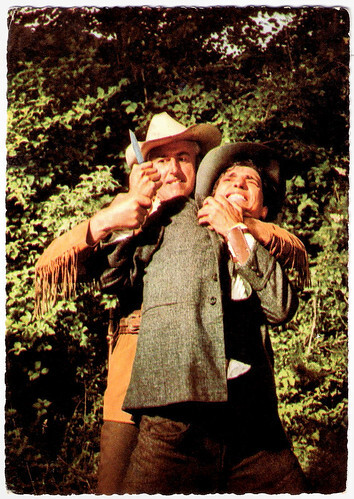
German postcard, no. 25. Photo: Rialto / Constantin. Stewart Granger as Old Surehand and Slobodan Dimitrijevic as Knife in Der Ölprinz/The Oil Prince (Harald Philipp, 1965). Caption: The battle swings back and forth. Then Old Surehand manages to wrest the knife from Knife and knocks him down with a punch. Now they have to get to the settlers' camp as quickly as possible in order to save them.
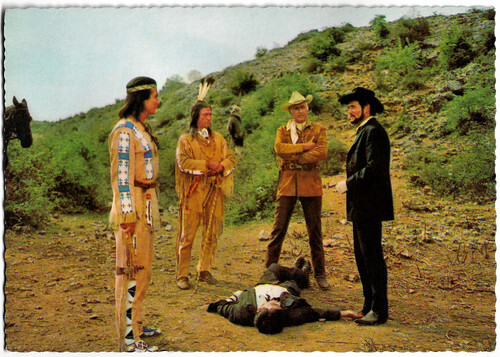
German postcard, no. 29. Photo: Constantin. Pierre Brice , Milivoje Popovic-Msvid, Stewart Granger and Harald Leipnitz in Der Ölprinz/The Oil Prince (Harald Philipp, 1965). Caption: Old Surehand has kept his promise. With the dead Knife, he brings the murderer of his son to the chief. Fearing revenge, the cowardly Oil Prince claims to have known nothing about all this.
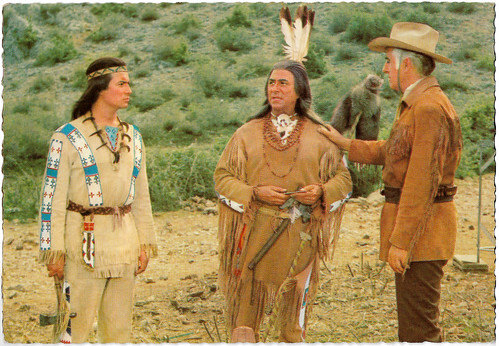
German postcard, no. 30. Photo: Constantin. Pierre Brice , Milivoje Popovic-Msvid and Stewart Granger in Der Ölprinz/The Oil Prince (Harald Philipp, 1965). Caption: The proof that Knife can be the murderer is the knife that the chief picked up. It fits exactly into the scabbard that Knife wore on his arm.
Sources: Wikipedia (English and German), and IMDb.

German postcard, no. 1 (of 32). Photo: Rialto / Constantin. Harald Leipnitz in Der Ölprinz/The Oil Prince (Harald Philipp, 1965). Caption: This is the oil prince, a ruthless adventurer who will do anything to get his hands on land and oil wells. His helpers are members of the Finders Gang. He has now commissioned them to intercept and kill the scout Bill Forner, who is to lead a trek of settlers to Lake Shelly. A member of the Finders Gang is to take his place and lead the trek astray because he needs the area around Lake Shelly for his machinations.

German postcard, no. 5 (of 32). Photo: Rialto / Constantin. Mario Girotti (Terence Hill) as Richard Forsythe in Der Ölprinz/The Oil Prince (Harald Philipp, 1965). Caption: A commotion ensues in the hotel, which ends in a brawl. Members of the Finders gang, who have been playing poker with young Forsythe, have discovered that Forsythe is a cardsharp. The oil prince rescues the young man from this situation. In return, he is supposed to join the trek and serve as a spy for the oil prince.

German postcard, no. 8. Photo: Rialto / Constantin. Mario Girotti (Terence Hill) in Der Ölprinz/Rampage at Apache Wells (Harald Philipp, 1965). Caption: The trek reaches according to appointment to the first stage near the river. The young Forsyth secretly sneaks out of the camp and meets with members of the Finders gang in the blockhouse. Here he receives his instructions, for the Finders gang will in the discharge of the Oil prince attack the wagons during the night.
Bandits, Indians, and Settlers
The bandit the Oil Prince (Harald Leipnitz) wants to sell the banker Duncan (Vladimir Leib) a fake oil well. However, a trek of settlers who want to settle in the area, of all places, stands in his way. The Oil Prince has the settlers' scout replaced by a member of the Finders Gang. Old Surehand ( Stewart Granger ) and Winnetou ( Pierre Brice ) track him down and are able to warn the trek.
Winnetou convinces the Navajo chief Nitsas-ini (Petar Dobric) of the peaceful nature of the settlers, and he lets them pass through his territory unhindered with Old Wabble (Milan Srdoc) as their guide to a stopover at the Chinla River. On the way to Utah, Old Surehand is lured into a trap by the Finders bandits, but Winnetou is able to rescue him.
At the Chinla River, the settlers, among them the widow Ebersbach (Antje Weisgerber), the cantor Hampel (Heinz Erhardt), the cardsharp Richard Forsythe ( Mario Girotti a.k.a. Terence Hill), and the shady businessman Bergmann (Veljko Maricic), are getting ready to spend the night when the Finders bandits attack. However, the attack can be repelled by Winnetou and Old Surehand, who arrive in time.
After the attack fails, the Oil Prince comes up with something new. He murders the son of the chief Mokaschi (Milivoje Popovic-Mavid) and blames the Indians for it on the settlers. The Indians surround the settlers at the river but are persuaded to wait with their attack if Old Surehand delivers the real murderer to them within a day.
Winnetou tries to bring the women and children to safety on the raging river with a raft. However, they fall into the water and are only saved when Old Surehand arrives. Old Surehand sets off in pursuit of the Oil Prince, who in the meantime has taken the money for the fake oil well from the banker Duncan and has trapped him in the oil cave with an avalanche of rubble.
Old Surehand is able to capture and tie up the Oil Prince after a short chase and a fight. The Indians have become impatient in the meantime and begin their attack on the settlers. The first wagons are already in flames when Old Surehand returns. The Oil Prince, who has been brought along, is handed over to the Indians and receives his just punishment from them.

German postcard, no. 10 (of 32). Photo: Rialto / Constantin. Harald Leipnitz and Pierre Brice in Der Ölprinz/The Oil Prince (Harald Philipp, 1965). Caption: In the Comanche camp he tells the chief that one of the settlers is in possession of a silver dollar sack. This must be the only survivor of the stagecoach robbery.

German postcard, no. 12. Photo: Rialto / Constantin. Pierre Brice , Stewart Granger, and Walter Barnes in Der Ölprinz/The Oil Prince (Harald Philipp, 1965). Caption: When he arrives in the camp of the settlers, chief Mokaschi reports what has been told to him by the Oil Prince. Winnetou, Old Surehand, and Campbell reaffirm that they have no money. The Chief is welcome to search their wagon.

German postcard, no. 15 (of 32). Photo: Rialto / Constantin. Harald Leipnitz in Der Ölprinz/The Oil Prince (Harald Philipp, 1965). Caption: The Oil Prince has arrived at Lake Shelly with his servant Knife. There he meets the chief executive of the Arizona Commercial Bank and his secretary. After demonstrating fake oil chains to the director, he sells them to him for 75,000 dollars. But that is not enough. After issuing the cheque, he has them both killed by the Finders Gang.

German postcard. Photo: Rialto / Constantin, no. 20. Stewart Granger as Old Surehand in Der Ölprinz/The Oil Prince (Harald Philipp, 1965). Caption: Bravely, young Forsythe holds his own on the raft. Old Surehand has reached a jutting cliff. In time he can throw his lasso to young Forsythe and pull him ashore. The empty raft crashes down the waterfall.
Old Surehand instead of Old Shatterhand
Apart from Der Schut, Der Ölprinz/The Oil Prince (Harald Philipp, 1965) is the only Karl May film in which the title character is a villain.
For the second time, Stewart Granger plays Old Surehand, deviating from the Karl May novel in which Old Shatterhand takes the main role. Producer Horst Wendlandt was unable to cast Lex Barker as Old Shatterhand because of Artur Brauner's production Through Wild Kurdistan.
The part of Lizzy (Macha Méril) was originally supposed to be played by Marie Versini, but she was also already under contract with Brauner at the time of filming. Fred Denger wrote the script, which was subsequently revised by Harald Philipp.
As Harald Reinl and Alfred Vohrer were busy, Wendlandt originally wanted Paul Martin as director. When the collaboration did not materialise, he called Harald Philipp in Berlin at Christmas 1964, who immediately agreed. Martin Böttcher once again composed an atmospheric score.
Der Ölprinz/The Oil Prince was shot at the Spandau Studios in Berlin and on location in Yugoslavia. The film's sets were designed by the art director Dusan Jericevic. Jericević had transformed the Western town of "Golden Hill" from Old Shatterhand into "Tucson".
Der Ölprinz/The Oil Prince recorded admissions of 409,817 in France, 1,449,558 in Spain, and over 3 million in Germany.

German postcard, no. 21. Photo: Rialto / Constantin. Stewart Granger as Old Surehand and Harald Leipnitz in Der Ölprinz/The Oil Prince (Harald Philipp, 1965). Caption: The oil prince in possession of the cheque is in a hurry to get back to town. Accompanied by Knife, he chooses a suspension bridge as a shortcut. Old Surehand surprises them. He forces them both to return by shooting the rungs.

German postcard, no. 25. Photo: Rialto / Constantin. Stewart Granger as Old Surehand and Slobodan Dimitrijevic as Knife in Der Ölprinz/The Oil Prince (Harald Philipp, 1965). Caption: The battle swings back and forth. Then Old Surehand manages to wrest the knife from Knife and knocks him down with a punch. Now they have to get to the settlers' camp as quickly as possible in order to save them.

German postcard, no. 29. Photo: Constantin. Pierre Brice , Milivoje Popovic-Msvid, Stewart Granger and Harald Leipnitz in Der Ölprinz/The Oil Prince (Harald Philipp, 1965). Caption: Old Surehand has kept his promise. With the dead Knife, he brings the murderer of his son to the chief. Fearing revenge, the cowardly Oil Prince claims to have known nothing about all this.

German postcard, no. 30. Photo: Constantin. Pierre Brice , Milivoje Popovic-Msvid and Stewart Granger in Der Ölprinz/The Oil Prince (Harald Philipp, 1965). Caption: The proof that Knife can be the murderer is the knife that the chief picked up. It fits exactly into the scabbard that Knife wore on his arm.
Sources: Wikipedia (English and German), and IMDb.
Published on March 22, 2022 23:00
Paul van Yperen's Blog
- Paul van Yperen's profile
- 13 followers
Paul van Yperen isn't a Goodreads Author
(yet),
but they
do have a blog,
so here are some recent posts imported from
their feed.



